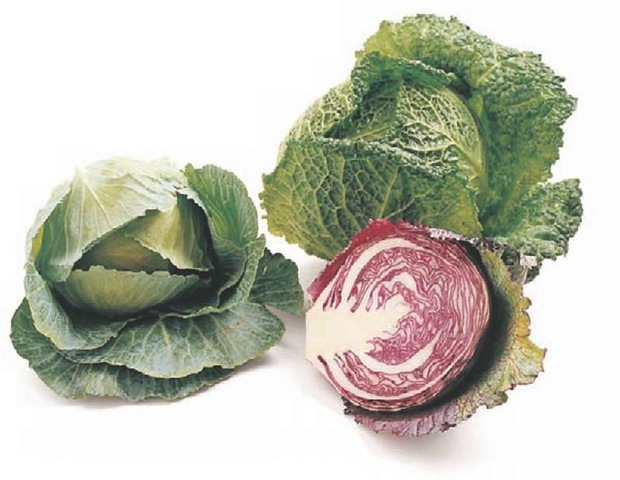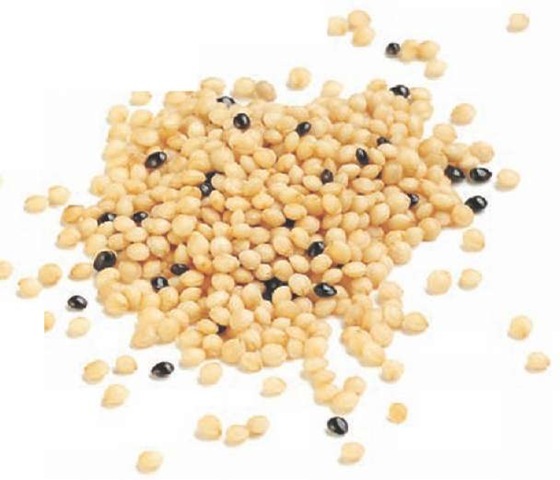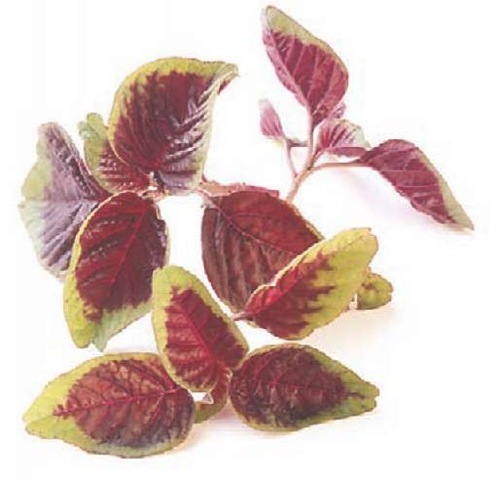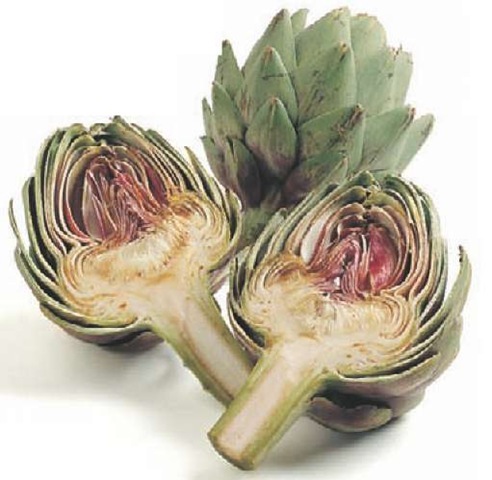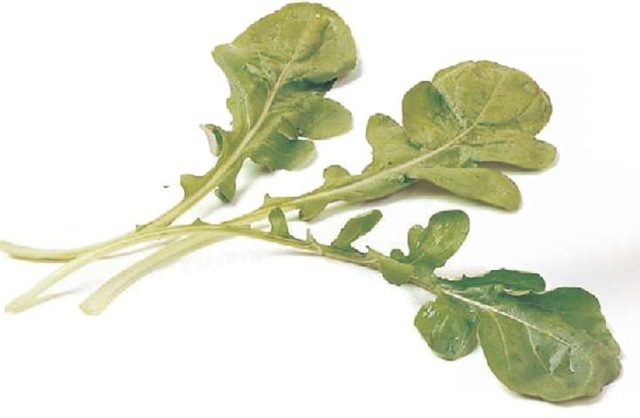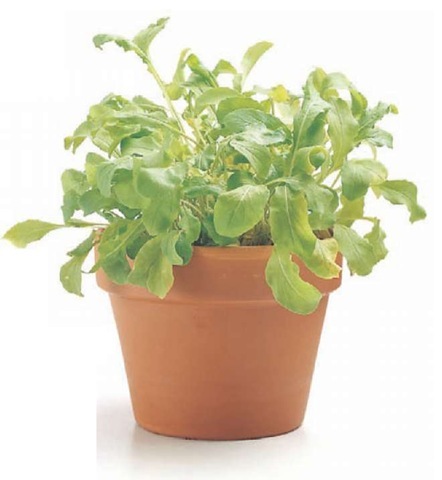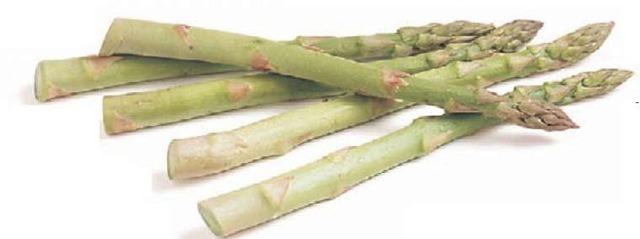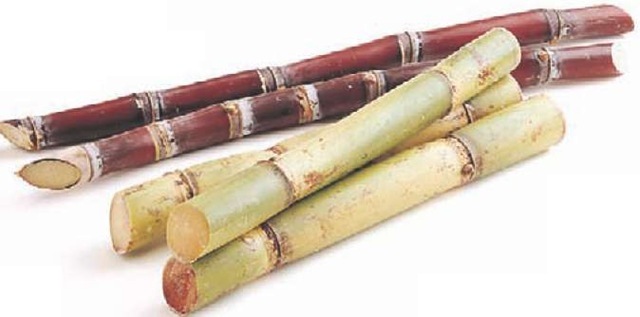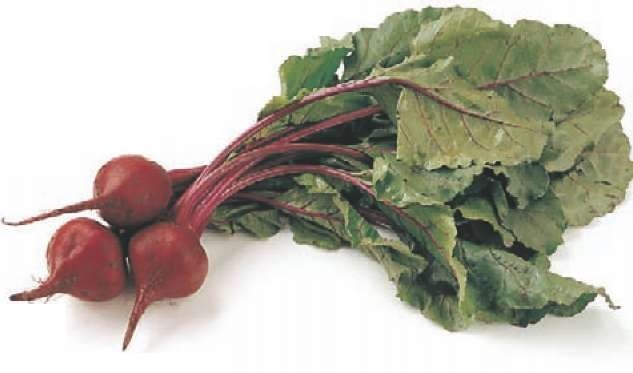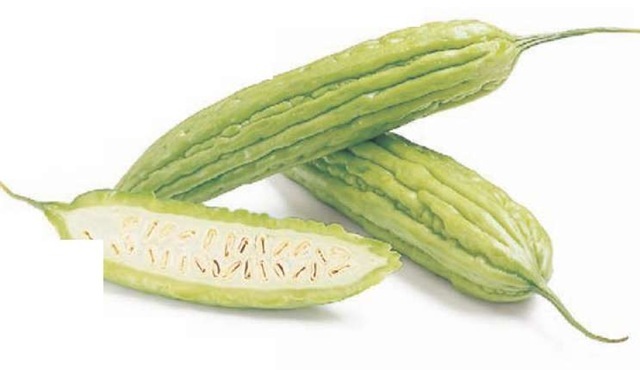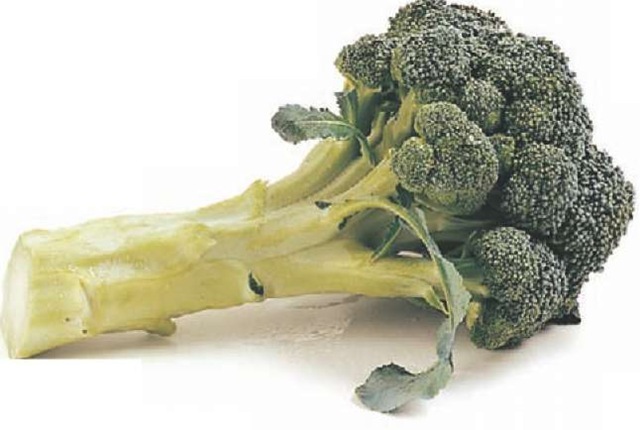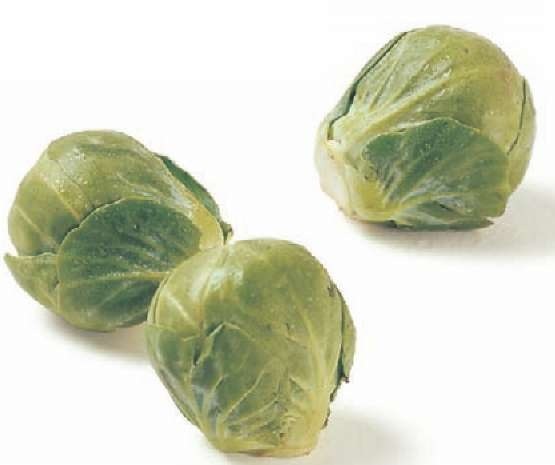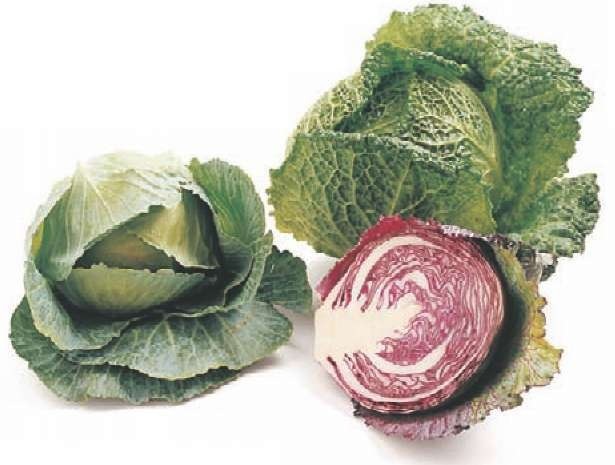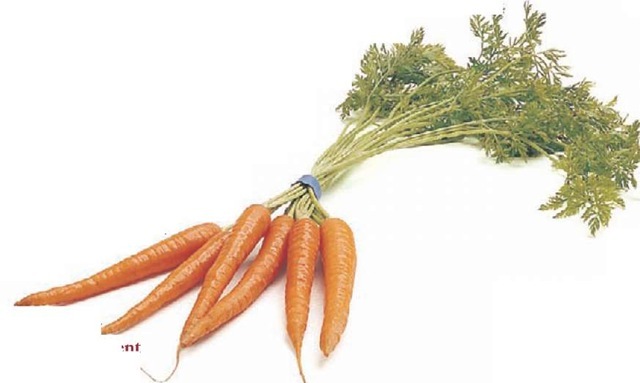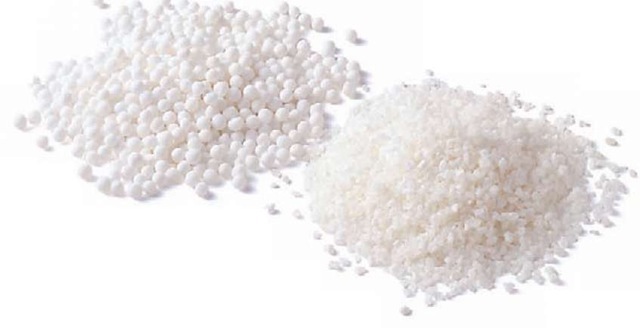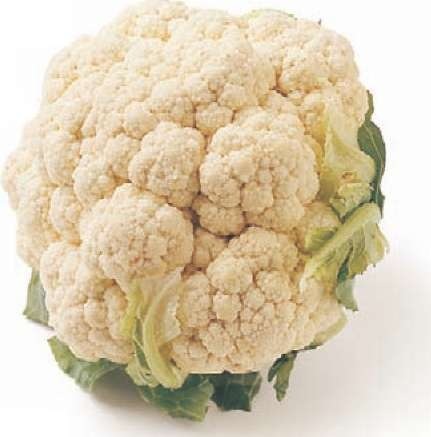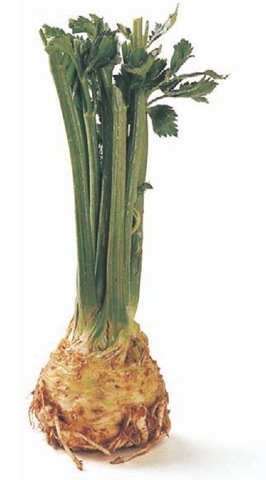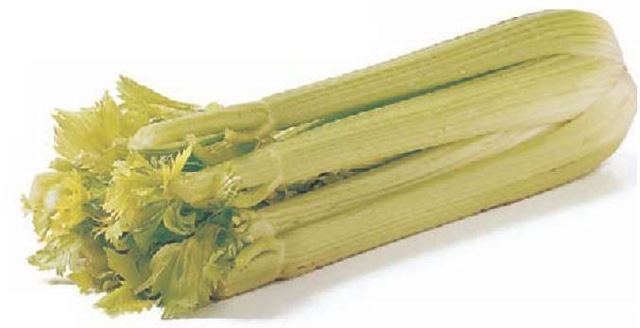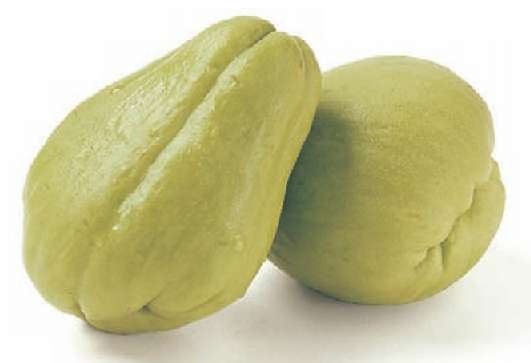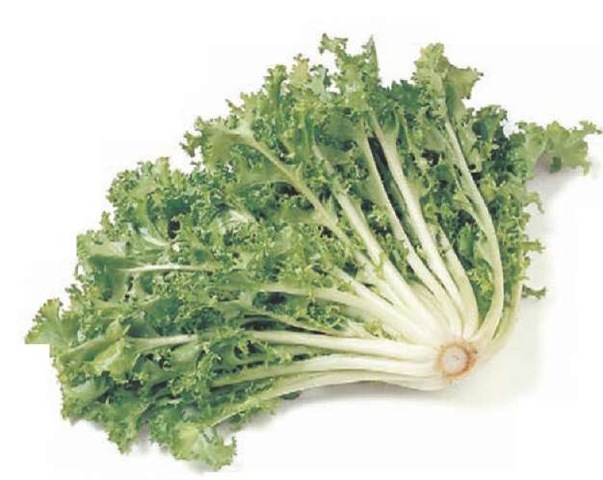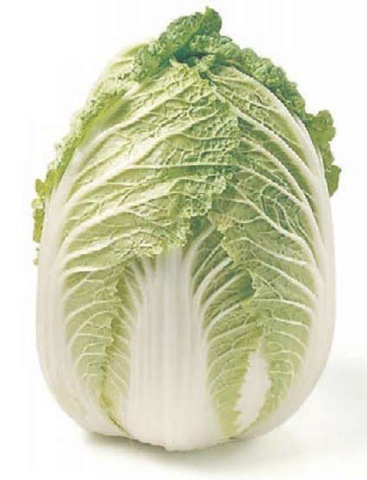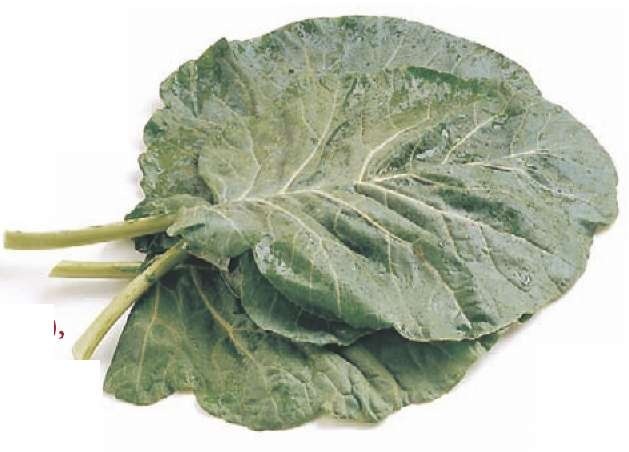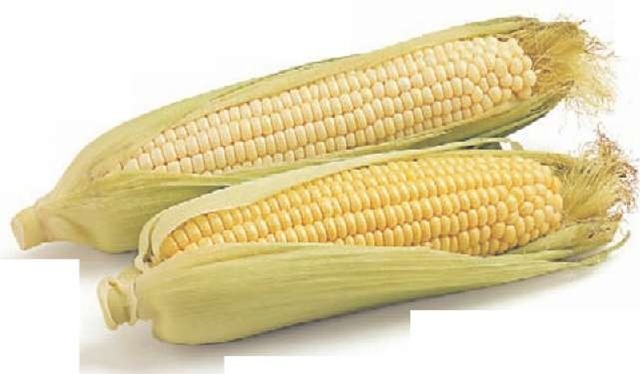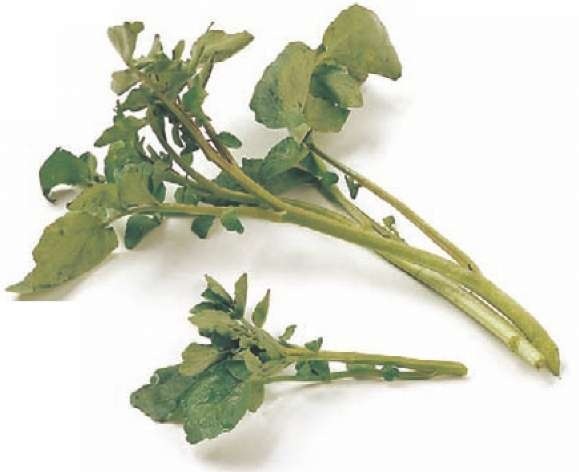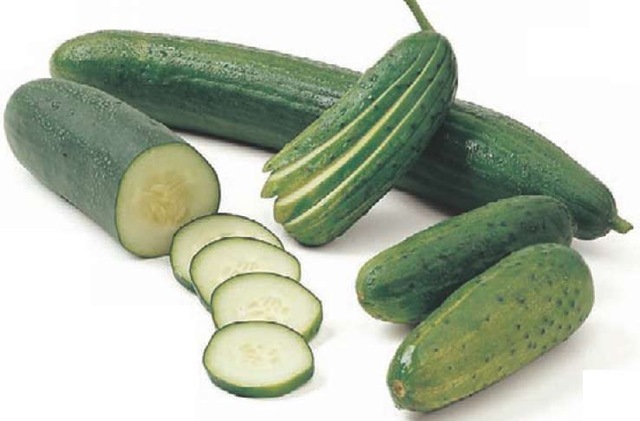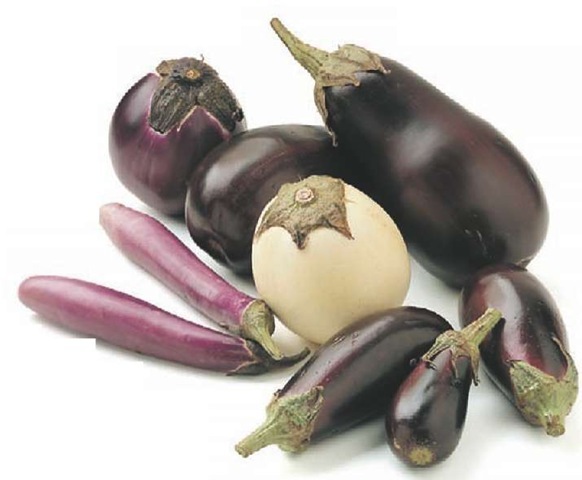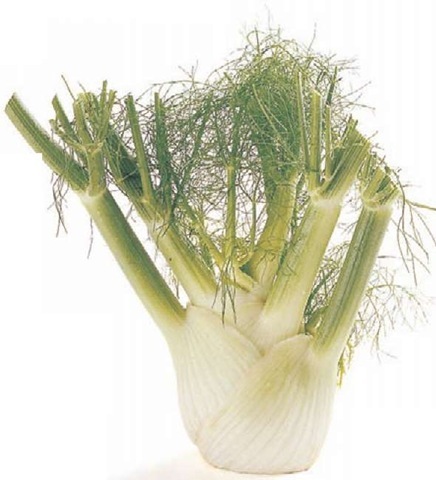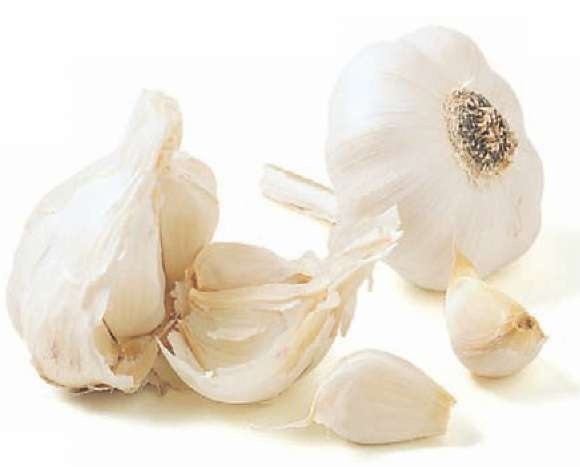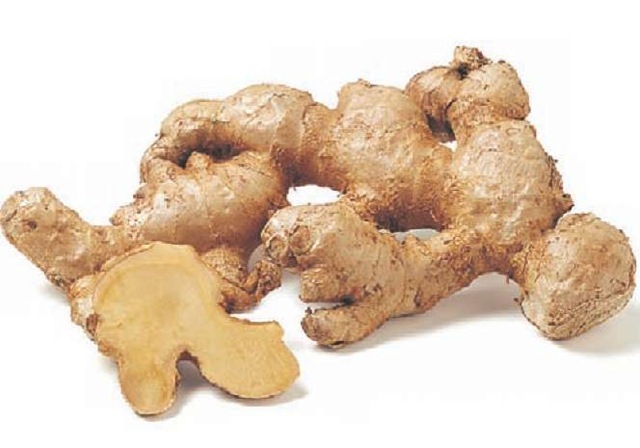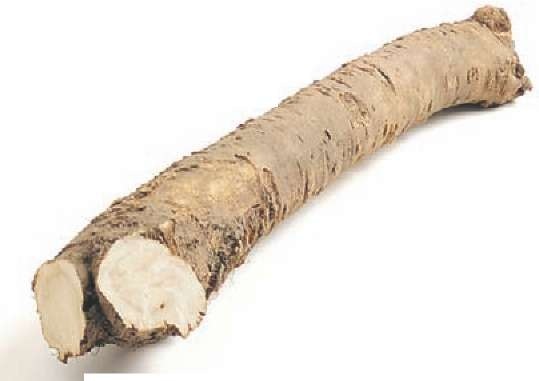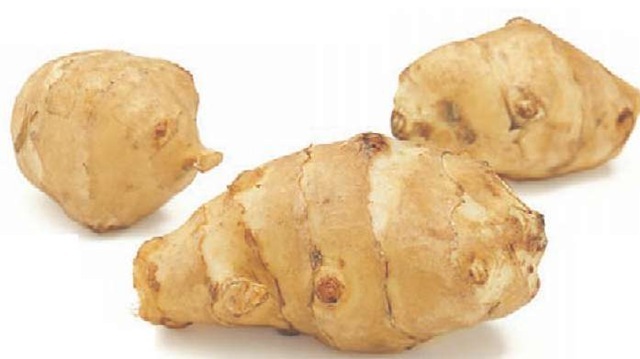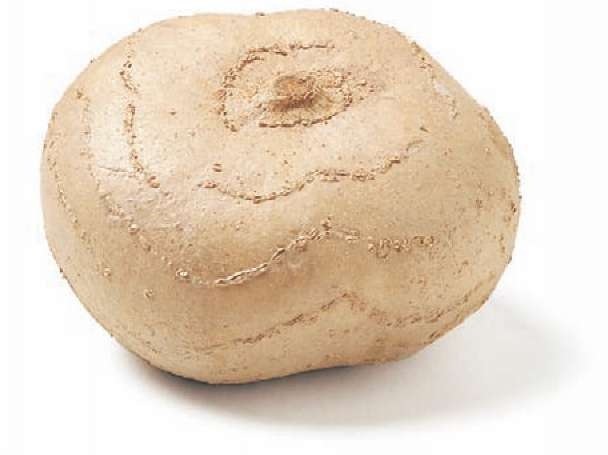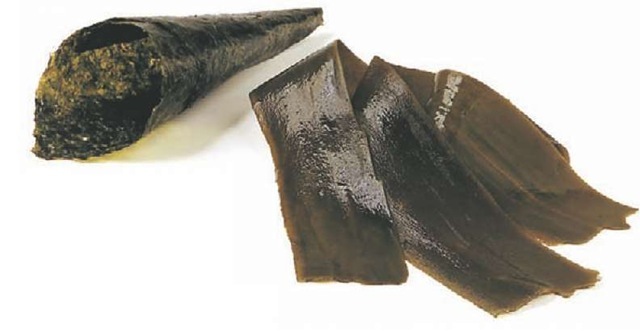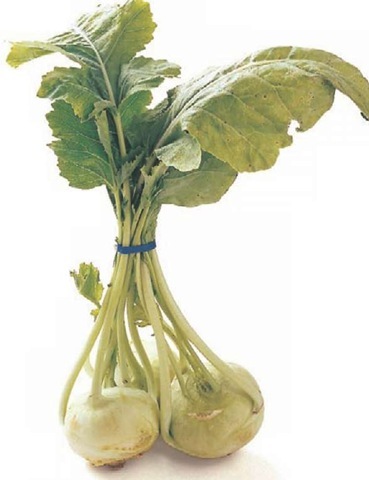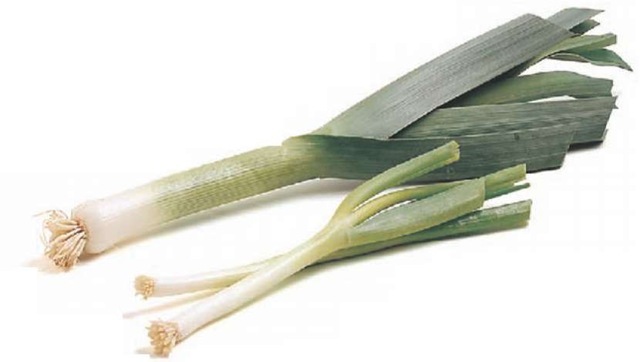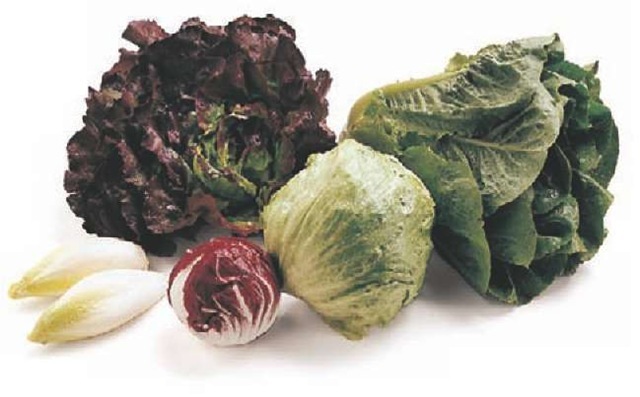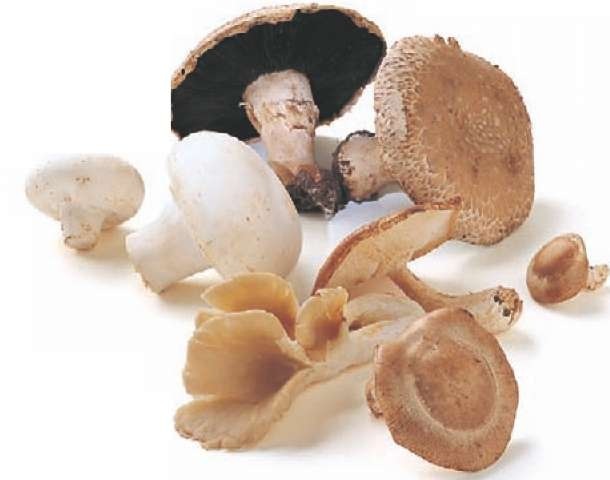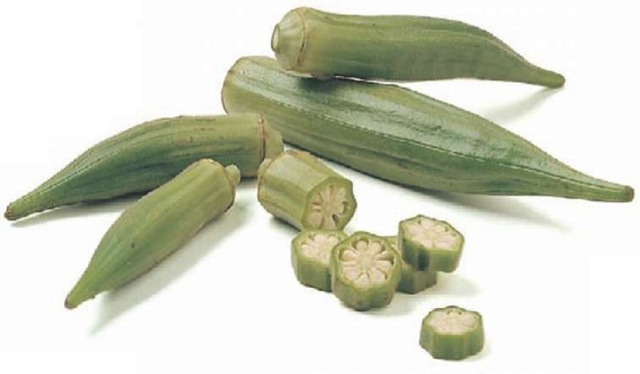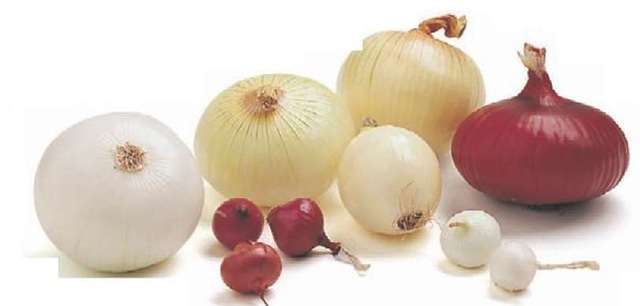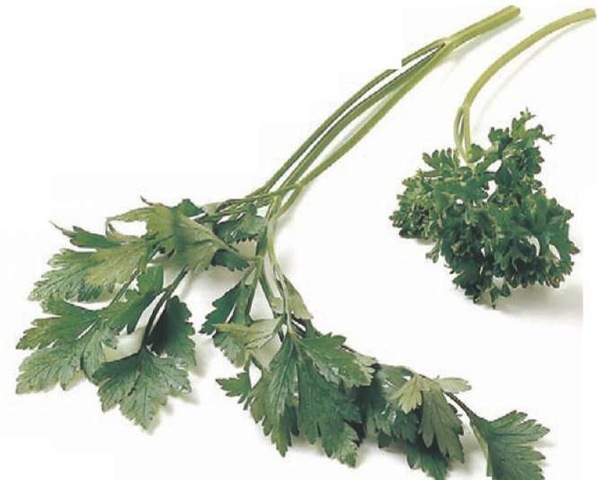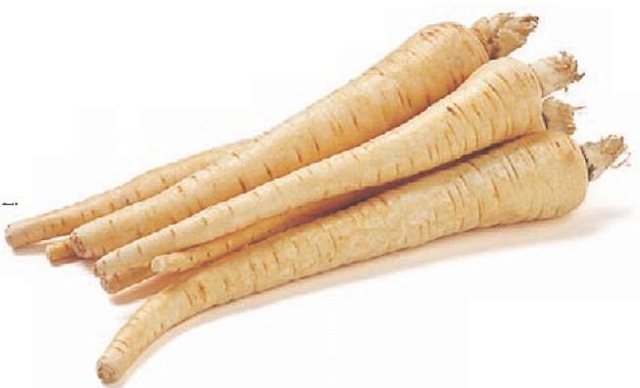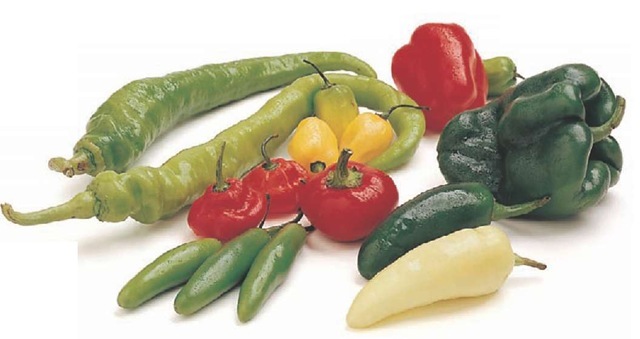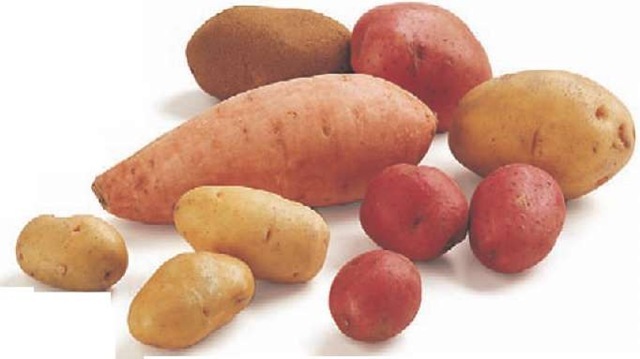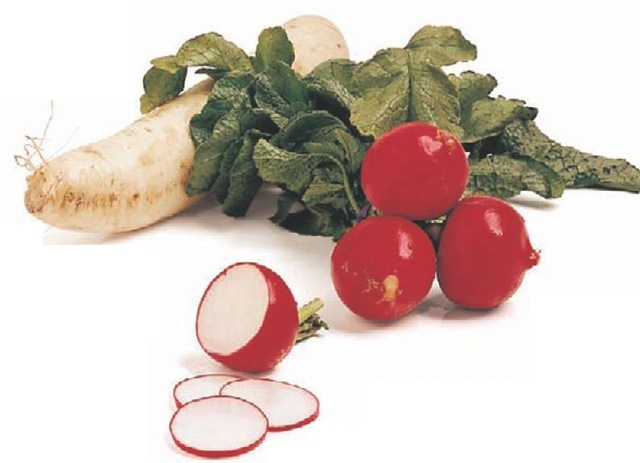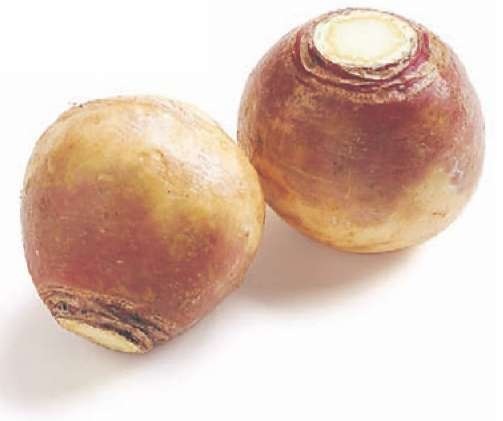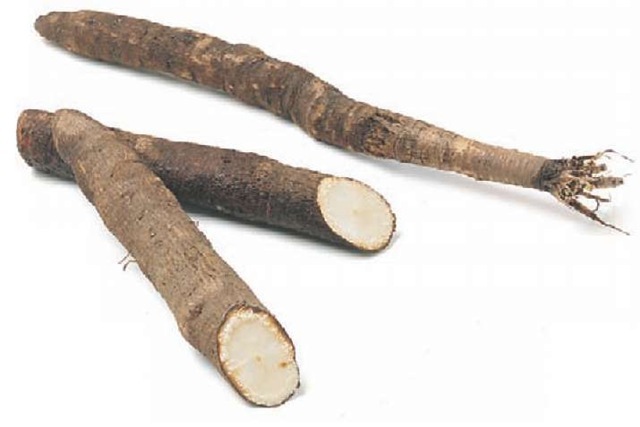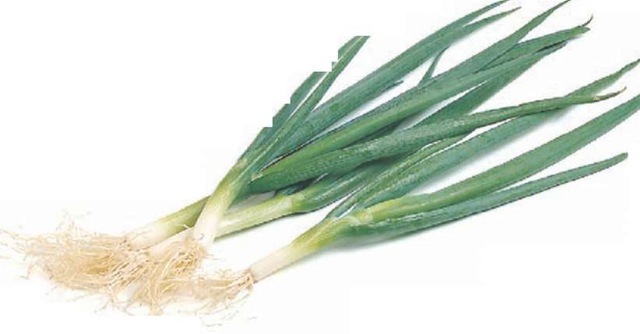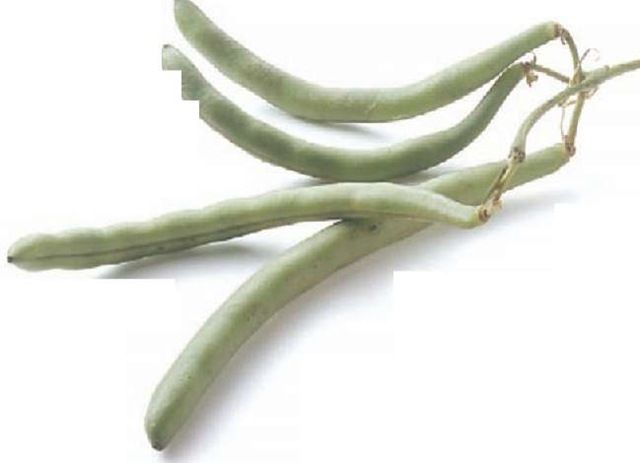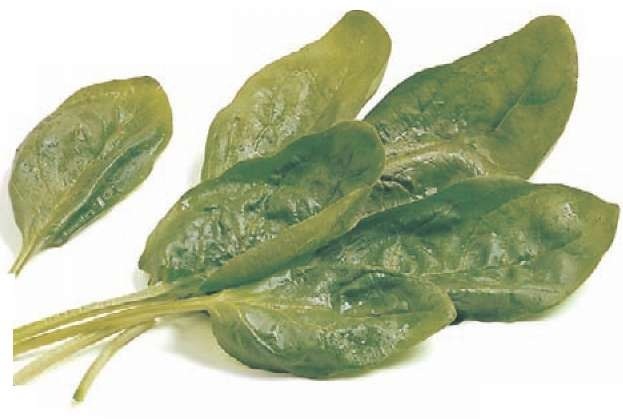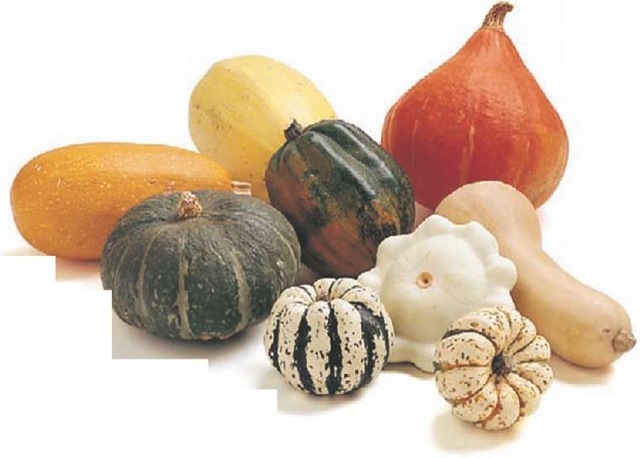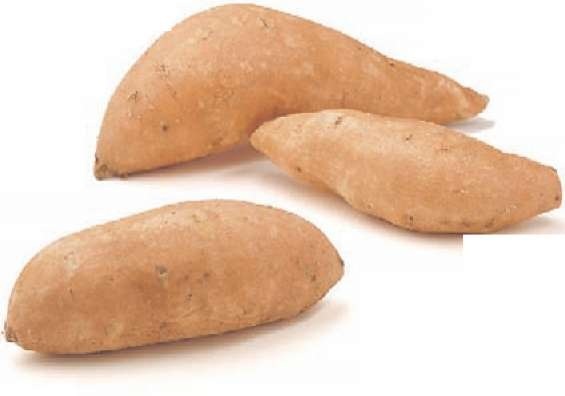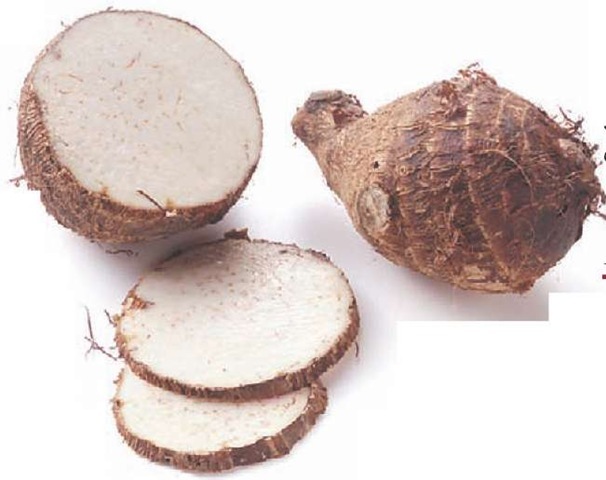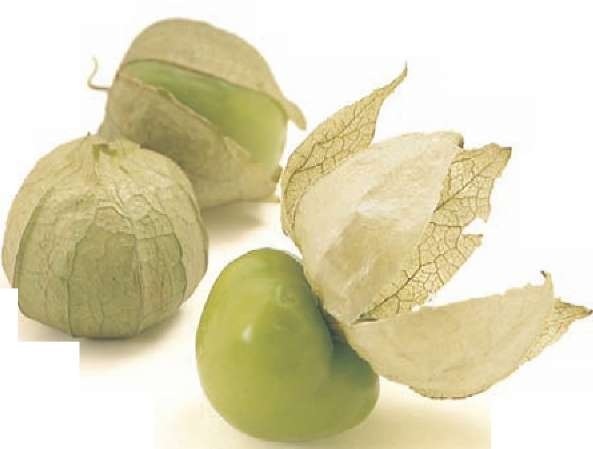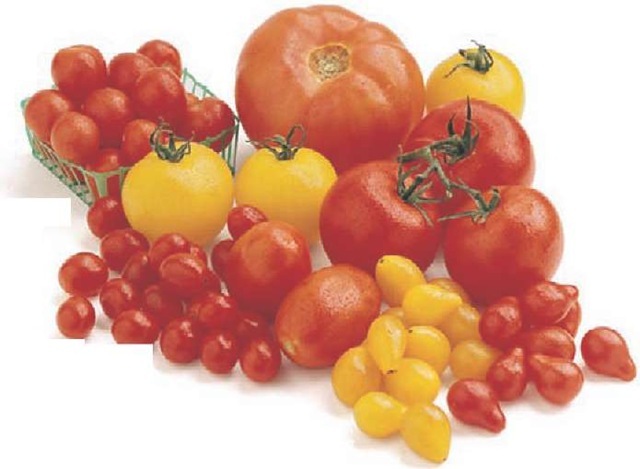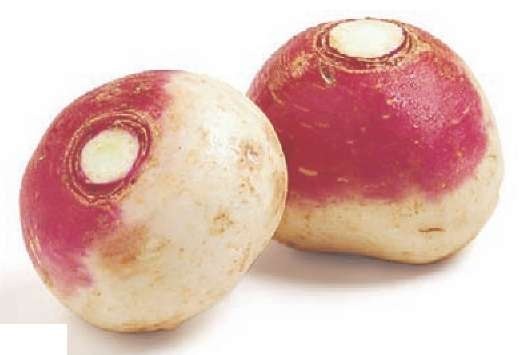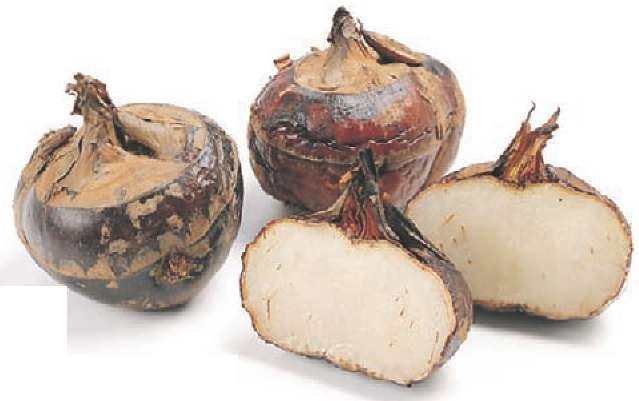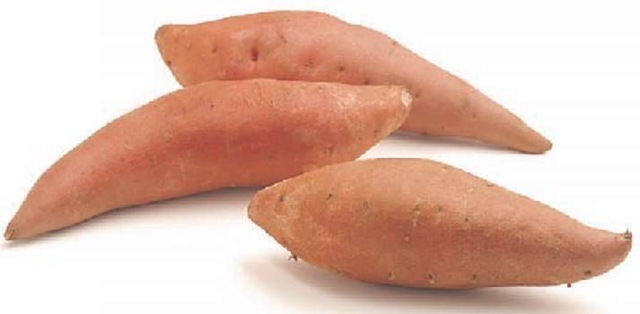Vegetables and other foods of plant origin were the primary source of sustenance for early humans.
The plant foods that we call vegetables came under cultivation later than the grains and legumes. Less protein- and carbohydrate-dense than the grains and legumes, vegetables have always served more as accompaniments or accessory ingredients than as staples. Some fragrant, highly flavored vegetables, such as scallions, garlic, ginger, parsley, basil, oregano, fenugreek, and dill, are really used as herbs and spices in sparing amounts as flavorings for other foods. Only a few of these "vegetables" are described in this section. Other herbs and spices are discussed on pages 363 to 375.
Some plant foods that we consider vegetables are, botanically, fruits (for example, avocado, squash, cucumber, olives, tomatoes, and eggplant), that is, edible flesh surrounding seeds. Nevertheless, the term "vegetable" has come to denote plant foods eaten as side dishes or used in the preparation of any part of the meal except dessert. Vegetables tend to be less sweet than foods considered fruits. In addition, some foods that are served as vegetables are really grains (corn), legumes (green beans, lima beans, peas), or fungi (mushrooms, truffles). So what is a vegetable, really? A vegetable is essentially any edible part of the plant (leaves, roots or tubers, and stalks) except, in most cases, the fruit. Multiple parts of some plants are eaten as separate vegetables with very different nutrient contents. The most common example is beet roots and their greens.
Vegetables contribute significant amounts of vitamins, minerals, soluble and insoluble fiber, and other phytonutrients to our diets. The Dietary Guidelines for Americans advise us to eat a wide variety of vegetables and fruits every day, because the nutrient content varies considerably from one to another.With the exception of olives and avocados, which are really fruits, few vegetables, by themselves, provide significant amounts of fat. The fat provided by olives and avocados is high in monounsaturated fatty acids, which may help prevent heart disease.
To assist you in menu planning, the following section provides information regarding the nutrient content of many vegetables.
The tables of nutrient values are based on serving sizes specified by the U.S. Department of Agriculture Food Guide Pyramid. Nutrient values are rounded (milligrams and micrograms tend to be rounded to one decimal point, grams are rounded to whole numbers). Nutrient claim statements listed beneath the common name of each vegetable are based on the serving size specified. For example, asparagus is considered a good source of vitamin C, because it provides about 18 percent of the Daily Value for vitamin C. A food that is high in a particular nutrient provides 20 percent or more of the Daily Value for that nutrient per serving.
Amaranth
Amaranth is cultivated as both a vegetable and a cereal grain. The upright herbaceous plant usually reaches 6 to 7 feet in height but may grow to 13 feet in favorable environments. The foliage varies in shape and color, although the leaves of most varieties are large, broad, and dark green with deep purplish veins. The flowers are small, green, and clover-like. The leaves from most varieties are edible and are delicious when cooked. The tiny grain is very nutritious. (See Grains, page 272, for a discussion of the grain.)
Family Amaranthaceae
Scientific name Amaranthus dubius
Common name amaranth
Cooked amaranth leaves are high in vitamin A, vitamin C, and potassium
Amaranth leaves are a good source of calcium
nutrient composition
Amaranth is a nutrient-dense food. One-half cup of cooked leaves is high in vitamin A and vitamin C and is a good source of calcium.
varieties
The genus Amaranthus includes a number of amaranth species. The common types include tampala, hon-moi-toi, bush greens, pigweed, Chinese spinach, and wild amaranth, some of which are edible and some not. Amaranth gangeticus, one of the edible varieties, is available in the United States as the green-leafed tampala. The red-leafed amaranth, known as Amaranth tricolor L., is also available, as is another familiar type called Joseph’s Coat.
origin & botanical facts
Reports of the existence of amaranth date back to the 2nd century A.D. The grain was a staple of the Aztec diet and was used in religious ceremonies until its cultivation was outlawed by the Spanish conquerors. Amaranth was brought to Asia after the 15th century and was cultivated in China and India. Today, China and Central America are the world’s leading suppliers.
Amaranths are hot weather plants that thrive best in well-fertilized, well-irrigated raised beds in sunny areas. Amaranth greens are harvested 4 to 6 weeks after the planting season. They are transported to the market packed in ice and are sold in bunches. Once considered a weed in the United States, amaranth is now consumed as a vegetable green.
uses
Young amaranth leaves are preferred for cooking. The leaves wilt easily and have a very short shelf life. They must be refrigerated or kept in ice water to retain their freshness and crispness. Amaranth leaves can be boiled, steamed, or stir-fried as a side dish to accompany meats, fish, or other vegetables. As a grain, amaranth is mostly ground into flour and used to make breads, pasta, pastries, and cereals. The flour is also available commercially.
nutrient composition
Amaranth is a nutrient-dense food. One-half cup of cooked leaves is high in vitamin A and vitamin C and is a good source of calcium.
nutrient content
|
Energy (kilocalories) |
14 |
|
Water (%) |
92 |
|
Dietary fiber (grams) - |
|
|
Fat (grams) |
0 |
|
Carbohydrate (grams) |
3 |
|
Protein (grams) |
1 |
|
Minerals (mg) |
|
|
Calcium |
138 |
|
Iron |
2 |
|
Zinc |
1 |
|
Manganese |
1 |
|
Potassium |
423 |
|
Magnesium |
36 |
|
Phosphorus |
48 |
|
Vitamins (mg) |
|
|
Vitamin A |
183 RE |
|
Vitamin C |
27 |
|
Thiamin |
0 |
|
Riboflavin |
0.1 |
|
Niacin |
0 |
|
Vitamin B6 |
0.1 |
|
Folate |
37 Mg |
|
Vitamin E - |
|
Note: A line (-) indicates that the nutrient value is not available.
Artichoke
The artichoke plant is a member of the thistle or sunflower family. The cones, or spherically shaped buds, are enclosed by overlapping outer scales (bracts) and are edible at the base. At the center of the bud is an inedible thistle (choke). The edible "heart" of an artichoke is the round, tender, firm base of the bud that is revealed after pulling off the petals. Commercially sold artichoke hearts are the tender central portions of small artichokes that have almost no choke. Their flavor is delicately nutty and slightly bitter.
Family Compositae
Scientific name Cynara scolymus
Common name globe artichoke
High in vitamin C and fiber
A good source of folate
VARIETIES
The most popular variety of artichoke is the Green Globe, which is usually solid green. Other varieties, rarely seen in the U.S. marketplace, include the Violetta and the Purple Roscoff, which have hints of purple either on the scales or the choke itself.
ORIGIN & BOTANICAl FACTS
The artichoke is native to the eastern Mediterranean region. Its use was documented by the ancient Greeks and Romans thousands of years ago. Today, most of the European supply of artichokes is still grown by the countries surrounding the Mediterranean Sea. Artichokes were introduced to the United States in the 19th century by European immigrants and soon found their way to the midcoast region of California, where most of the domestic crop is cultivated today.
An artichoke is an immature bud that, if left to bloom, boasts a bright-purple, thistle-like flower that can be found at outdoor farmers’ markets and can be dried for use in flower arrangements. The size of an artichoke bud is determined by the stalk on which it grows and is not indicative of quality. Thick stalks, which are usually concentrated around the center of the plant, produce large artichokes, and the thinner side stalks produce smaller artichokes.
USES
Artichokes picked in the fall or winter months may have bronze-tipped leaves or a slightly gray tint, which is a sign of exposure to frost. However, this should not affect the flavor of the artichoke. Squeezing the artichoke slightly should elicit a squeak if the leaves are still plump and crisp. Although the artichoke looks tough and hardy, it should be kept in the refrigerator for no more than 4 or 5 days. A sprinkle of water in a plastic bag will help maintain the moisture of the artichoke, but it should not be trimmed, cut, or washed before storing. Artichokes are most often boiled or steamed and can be eaten hot or cold. Each petal is pulled off and the base is dipped into melted butter or lemon juice. Only the tender portion at the base of the petal is edible. Underneath the rough outer petals, the thinner rose-colored petals can be bitten off or removed to find the choke. After removing the choke, the heart can be eaten whole. The hearts also can be added to pasta sauces or green salads and used to top pizzas. Whole steamed artichokes can be filled with well-seasoned stuffing and served as is or baked.
NUTRIENT COMPOSITION
The artichoke is high in vitamin C and dietary fiber and is a good source of folate.
nutrient content
|
Energy (kilocalories) |
60 |
|
Water (%) |
84 |
|
Dietary fiber (grams) |
6 |
|
Fat (grams) |
0 |
|
Carbohydrate (grams) |
13 |
|
Protein (grams) |
4 |
|
Minerals (mg) |
|
|
Calcium |
54 |
|
Iron |
2 |
|
Zinc |
1 |
|
Manganese |
0 |
|
Potassium |
425 |
|
Magnesium |
72 |
|
Phosphorus |
103 |
|
Vitamins (mg) |
|
|
Vitamin A |
22 RE |
|
Vitamin C |
12 |
|
Thiamin |
0.1 |
|
Riboflavin |
0.1 |
|
Niacin |
1 |
|
Vitamin B6 |
0.1 |
|
Folate |
61 |g |
|
Vitamin E |
0 |
Arugula
Arugula is an annual that grows 8 to 24 inches high. It has dull green, deeply cut, compound leaves that are edible and have a d spicy, pungent flavor resembling horseradish. The vegetable wa called roquette (the French word for rocket), but the term "arugula" is now becoming more common.
Family Cruciferae
Scientific name Eruca vesicaria sativa
Common name arugula, Italian cress, rocket, roquette, tira, white pepper, garden rocket
Provides some vitamin A
varieties
The arugula can be divided into smooth-edged or serrated-leafed varieties. Some arugula varieties are wild, although most are cultivated. The flavor varies depending on variety.
origin & botanical facts
Arugula belongs to the Cruciferae family and is a close relative of the mustard. Ancient Egyptians and Romans considered arugula leaves in salads to be an aphrodisiac. It is a minor crop in the southeastern United States, grown to a limited extent commercially and in home vegetable gardens. Seeds often are listed in seed catalogs as "roquette" under the category of herbs. A cool season vegetable best grown in Florida during the fall, winter, and spring, it matures from seed in 2 to 3 months. Periods of very warm temperatures cause it to bolt (go to seed) rather quickly. Few pests attack the arugula.
uses
The freshest, crispest leaves free of brown spots should be chosen. Arugula should be used as soon as possible after purchasing. If necessary, after removing any wilted leaves, the remaining unwashed leaves can be refrigerated for no more than 2 days in a plastic bag. The zesty leaves can be used raw in salads by themselves or tossed with other greens. Arugula also can be added to soups or lightly cooked and served as a side dish. The arugula is widely consumed in the Middle East as a garnish on meats and sandwiches. Tiny arugula blossoms also can be added to salads.
nutrient composition
Arugula provides some vitamin A.
nutrient content
|
Energy (kilocalories) |
5 |
|
Water (%) |
92 |
|
Dietary fiber (grams) |
0 |
|
Fat (grams) |
0 |
|
Carbohydrate (grams) |
1 |
|
Protein (grams) |
1 |
|
Minerals (mg) |
|
|
Calcium |
32 |
|
Iron |
0 |
|
Zinc |
0 |
|
Manganese |
0 |
|
Potassium |
74 |
|
Magnesium |
9 |
|
Phosphorus |
10 |
|
Vitamins (mg) |
|
|
Vitamin A |
47 RE |
|
Vitamin C |
3 |
|
Thiamin |
0 |
|
Riboflavin |
0 |
|
Niacin |
0 |
|
Vitamin B6 |
0 |
|
Folate |
19 Mg |
|
Vitamin E |
0 |
Asparagus
Asparagus is a member of the lily family and is related to onions, leeks, and garlic. It is cultivated for its edible young shoots, which are long and unbranched with compact, pointed tips made of tiny leaves.
Family Liliaceae
Scientific name Asparagus officinalis
Common name asparagus
High in folate
A good source of vitamin C
Contains glutathione, an antioxidant that promotes health
VARIETIES
Two basic varieties of asparagus, white and green, are cultivated. The green variety is the only one grown on a commercial scale in the United States, whereas the white is preferred in Europe. White asparagus is produced by banking soil against the plant to keep out sunlight, which otherwise would turn the stalks green. Also available, although not common, is a violet variety, with pinkish purple shoots and tips.
Origin & botanical facts
Asparagus was first cultivated in Greece about 2,500 years ago. In fact, the name asparagus is Greek for "stalk" or "shoot." The ancient Greeks believed that asparagus had medicinal qualities and could cure toothaches and bee stings. The cultivation of asparagus was adopted by the Romans, who carried it throughout Europe and Great Britain. From there, its popularity spread to the rest of the world. Traditionally, asparagus was a Northern Hemisphere crop, but today it is cultivated worldwide. The United States is the world’s largest supplier of asparagus, with most cultivation concentrated in California.
The asparagus plant is a perennial but requires three seasons to mature. In its first season, a crown forms with 6 inches of root. In its second season, the crown develops into a fern. Asparagus can be harvested in its third season, but the plant does not reach its prime until 6 to 8 years of age. At peak age, an asparagus field can yield up to 2 tons per acre. Because its growing season is short and it must be harvested by hand, asparagus can be expensive. Asparagus appears in American markets as early as February, when the first California crops are harvested, but the peak season in the West is from late April to late May and, elsewhere in the United States, from May through July. Throughout the rest of the year, fresh asparagus may be available from Mexico and South America.
USES
Asparagus stalks of similar width with tightly closed tips should be selected. Young asparagus is thinner and generally more tender. Fresh asparagus should be stored in the refrigerator with the cut ends immersed in water and should be used within a day or two.
Fresh asparagus is best steamed or microwaved until just crisp-tender. Steaming should be done quickly, with the spears in an upright position to heat the stalks evenly. The spears also can be roasted briefly in the oven with a little olive oil. Cooked asparagus is best served immediately and simply, without rich sauces. Asparagus spears also can be cut into diagonal pieces and stir-fried.
Asparagus is also available canned or frozen. Frozen spears are closer to fresh spears in flavor and nutrition. The canned variety is less nutritious.
NUTRIENT COMPOSITION
Asparagus is a good source of vitamin C and is an excellent source of folate. It also contains glutathione, an antioxidant that promotes health.
nutrient content
|
|
4 spears, raw (64 g) |
6 spears, cooked (1/2 cup) (72 g) |
|
Energy (kilocalories) |
14 |
22 |
|
Water (%) |
92 |
92 |
|
Dietary fiber (grams) |
1 |
1 |
|
Fat (grams) |
0 |
0 |
|
Carbohydrate (grams) |
3 |
4 |
|
Protein (grams) |
1 |
2 |
|
Minerals (mg) |
||
|
Calcium |
13 |
18 |
|
Iron |
1 |
1 |
|
Zinc |
0 |
0 |
|
Manganese |
0 |
0 |
|
Potassium |
175 |
144 |
|
Magnesium |
11 |
9 |
|
Phosphorus |
36 |
49 |
|
Vitamins (mg) |
||
|
Vitamin A |
37 RE |
49 RE |
|
Vitamin C |
8 |
10 |
|
Thiamin |
0.1 |
0.1 |
|
Riboflavin |
0.1 |
0.1 |
|
Niacin |
1 |
1 |
|
Vitamin B6 |
0.1 |
0 |
|
Folate |
82 Mg |
131 Mg |
|
Vitamin E |
1 |
0 |
Bamboo
Although the bamboo is often thought to be a tree, it is actually a type of evergreen perennial grass that is woody when mature but whose young shoots are edible. The mature stalks are characterized by green internodes ribbed with cream-colored, brown-speckled sheaths and hanging leaves up to 8 inches long and 3/4 inch wide. Fresh bamboo shoots are light yellow or brown, purple at the root end, and white at the stalk end. The cooked young shoots are crisp, fragrant, and mild in flavor.
Family Graminaceae
Scientific name Phyllostachys species, Bambusa species
Common name bamboo
A source of potassium
varieties
The dozens of varieties of bamboo can be classified in several ways. All bamboo can be divided into those that grow uncontrollably (the invasive type) and those that tend to clump. Bamboo also can be divided into those that are cold-hardy and those that are tropical and sub-tropical. Finally, within each of the above categories, the numerous species can be classified by their mature size (giant, large, medium, and dwarf). Bamboo grown in the United States is almost exclusively the cold-hardy Phyllostachys species, most of which are invasive.
origin & botanical facts
Bamboo is native to China, Japan, southeast Asia, India, Africa, South America, and parts of Mexico. Although bamboo shoots have been an important vegetable in Asian diets for thousands of years, Asian-grown bamboo is mostly consumed locally, with only small quantities processed for export. Bamboo is still a rare vegetable in Western countries, used exclusively in Oriental dishes. However, Europe and the United States are beginning to develop bamboo crops.
Bamboo grows by sending out new rhizomes (underground, horizontal stems) from which new shoots emerge. The constant appearance of new shoots and leaves gives the plant its evergreen appearance. The nutrients made by the leaves are stored in the rhizomes and then converted into the following year’s new growth. Because large crops occur in alternate years, growers maintain plants of various ages. To keep the shoots white, soil is sometimes piled against new growth areas to prevent them from developing chlorophyll.
Nations that export bamboo shoots may harvest cultivated plantations or native forests. Unfortunately, lack of regulation has allowed excessive harvesting, which has led to a decline in some native forests. In contrast, because many hardy bamboo species spread uncontrollably, U.S. home gardeners who want to grow bamboo should construct an underground barrier wall to prevent its spread.
uses
The tenderest shoots are those about 6 inches or less in height. Fresh shoots should be stored in cold water for no more than 2 days, or wrapped tightly in plastic and refrigerated up to a week. The shoots also can be blanched and frozen for up to a year. Fresh shoots should be boiled in one or two changes of plain or slightly salted water until tender, then husked and sliced lengthwise. Canned or frozen bamboo shoots should be rinsed, heated, and served as is or stir-fried with meats and other vegetables. The tender parts also can be used in salads.
nutrient composition
Cooked bamboo shoots are a source of potassium.
nutrient content
|
Energy (kilocalories) |
7 |
|
Water (%) |
95 |
|
Dietary fiber (grams) |
1 |
|
Fat (grams) |
0 |
|
Carbohydrate (grams) |
1 |
|
Protein (grams) |
1 |
|
Minerals (mg) |
|
|
Calcium |
7 |
|
Iron |
0 |
|
Zinc |
0 |
|
Manganese |
0 |
|
Potassium |
320 |
|
Magnesium |
2 |
|
Phosphorus |
12 |
|
Vitamins (mg) |
|
|
Vitamin A |
0 RE |
|
Vitamin C |
0 |
|
Thiamin |
0 |
|
Riboflavin |
0 |
|
Niacin |
0 |
|
Vitamin B6 |
0.1 |
|
Folate |
1 Mg |
|
Vitamin E - |
|
Note: A line (-) indicates that the nutrient value is not available.
Beets
Beets are round, firm root vegetables with edible, leafy green tops. Although the most common root color is bright red, colors may vary from deep red to yellow or white, and one variety displays concentric rings of red and white. When cooked, they have a tender-crisp texture and a sweet flavor.
Family Chenopodiaceae
Scientific name Beta vulgaris
Common name beet
Beets are a good source of folate
Cooked beet greens are high in vitamin A (beta-carotene) and vitamin C and are a good source of riboflavin and magnesium
VARIETIES
The garden or table beet is the type most commonly grown for human consumption. Three common varieties are the Lutz salad leaf beet, the Detroit dark red beet, and the Chioggia beet, an Italian favorite with alternate red and white concentric rings. Another type of beet is the spinach or leaf beet, grown not for its root but for its leaves, which are better known as Swiss chard. A third type of beet, the sugar beet, is not grown as a vegetable. This beet contains twice the sugar of table beets and provides about a third of the world’s sugar supply. This type of beet also is used as fodder.
Origin & Botanical facts
Modern varieties of beets are derived from the sea beet, an inedible plant that grows wild along the coasts of Europe, North Africa, and Asia. The garden beet has been cultivated for thousands of years. In ancient Greece, beets were so highly valued that, according to myth, a beet was offered on a silver platter to Apollo at Delphi.
Today, beets are grown in many regions of the world. The leading beet-producing regions of the United States are California, Colorado, New Jersey, Ohio, and Texas. The beet is a cool-weather biennial that is cultivated as an annual. Beets are grown from seeds sown in early spring and are ready to harvest 60 to 80 days after planting. Beets are not harmed by frost, but hot weather can toughen the roots. Thus, in regions with hotter summers, they are planted in early fall for winter and spring harvest. Consequently, fresh beets are available all year.
USES
When buying beets with the leaves attached, those with the youngest, freshest looking leaves should be selected. Otherwise, avoid beets that are dried, cracked, or shriveled. Large beets may be tough, and small ones are the most tender and flavorful. Leaves should be crisp and should be rinsed well before using. Beets should be stored separately from the leaves in perforated plastic bags in the refrigerator vegetable crisper.
Beets can be grated and eaten raw in salads, boiled, steamed, stewed, baked, sauteed, or pickled. To preserve their color and nutrients, it is best not to peel beets before cooking. They should be scrubbed gently and at least a half inch of stem should be left on. Beets also keep their color better if an acid ingredient such as vinegar or lemon juice is added during cooking. Canned beets are available, but fresh beets are crisper and more flavorful. Beets are used to make the traditional Russian soup borscht, which is colored red by the beet juice.
NUTRIENT COMPOSITION
Cooked beets are a good source of folate. Cooked beet greens are high in vitamin A (beta-carotene) and vitamin C. They are also a good source of riboflavin and magnesium.
nutrient content
|
|
1/2 cup sliced beets, cooked (85 g) |
1/2 cup greens, cooked (72 g) |
|
Energy (kilocalories) |
37 |
19 |
|
Water (%) |
87 |
89 |
|
Dietary fiber (grams) |
2 |
2 |
|
Fat (grams) |
0 |
0 |
|
Carbohydrate (grams) 8 |
4 |
|
|
Protein (grams) |
1 |
2 |
|
Minerals (mg) |
||
|
Calcium |
14 |
82 |
|
Iron |
1 |
1 |
|
Zinc |
0 |
0 |
|
Manganese |
0 |
0 |
|
Potassium |
259 |
655 |
|
Magnesium |
20 |
49 |
|
Phosphorus |
32 |
30 |
|
Vitamins (mg) |
||
|
Vitamin A |
3 RE |
367 RE |
|
Vitamin C |
3 |
18 |
|
Thiamin |
0 |
0.1 |
|
Riboflavin |
0 |
0.2 |
|
Niacin |
0 |
0 |
|
Vitamin B6 |
0 |
0.1 |
|
Folate |
68 Mg |
10 Mg |
|
Vitamin E |
0 |
0 |
Bitter Melon (balsam pear)
About 4 to 10 inches long, bitter melons are shaped like cucumbers and have wrinkled, bumpy skin. The vegetable’s name is derived from its distinctive bitter taste, the result of a high quinine content. The bitterness increases as the melon matures; young, green melons have a delicate, sour flavor, whereas older (yellow) ones are very bitter and acrid. When fully mature, the melon’s rind dries and splits lengthwise into three sections, revealing the bright-red arils that enclose the seeds. Bitter melons are normally eaten as immature fruits, but some people prefer the bitter-tasting, more mature fruits.
Family Cucurbitaceae
Scientific name Momordica charantia
Common name bitter melon, balsam pear, bitter cucumber, bitter gourd
High in vitamin C
varieties
The bitter melon is a variety of squash. A closely related variety, the balsam apple (Momordica balsamita), bears fruits similar to bitter melons except that they are egg-shaped and smaller, with smoother skin. Balsam apples, which have a taste similar to that of the bitter melon, are also cultivated, harvested, and prepared like the bitter melon.
origin & botanical facts
Bitter melons originated in tropical India and have been cultivated for centuries throughout Asia.
The bitter melon is an annual that grows in tropical and subtropical areas. Reaching up to 30 feet in length, the plant grows as a vine with tendrils that attach to plants or other objects for support. Although highly popular as a food crop in India, China, and southeast Asia, bitter melons have been introduced only recently as a food item in U.S. markets. In this country, bitter melons are often grown on trellises and fences as decorative plants.
uses
Bitter melons are available fresh from April through September in Asian markets and also are sold canned or dried. They can be refrigerated in a plastic bag for up to a week. When buying bitter melons, choose green ones if a less bitter taste is desired or yellow ones for a stronger, more bitter flavor. Before it is cooked, the fruit should be cut lengthwise to remove the seeds and the surrounding white fibers. The skin can be either left intact or removed. Bitter melons are always cooked before eating. In India, bitter melons are combined with potatoes or lentils and seasoned with cumin and turmeric. In China, they are steamed or used as an ingredient in soup. They can be thinly sliced and stir-fried with eggs, meats, or other vegetables.
Stuffed with meat, shrimp, wood ears, and thin rice noodles, bitter melons can be braised in a light broth to make a bittersweet soup. The young leaves of the plant can be boiled and stir-fried like greens or used fresh in salads.
nutrient composition
Bitter melons are high in vitamin C. They also contain many phytochemicals, including elasterol, lutein, and lycopene. The leafy tips are a good source of vitamin A.
nutrient content
|
Energy (kilocalories) |
12 |
|
Water (%) |
94 |
|
Dietary fiber (grams) |
1 |
|
Fat (grams) |
0 |
|
Carbohydrate (grams) |
3 |
|
Protein (grams) |
1 |
|
Minerals (mg) |
|
|
Calcium |
6 |
|
Iron |
0 |
|
Zinc |
0 |
|
Manganese |
0 |
|
Potassium |
198 |
|
Magnesium |
10 |
|
Phosphorus |
22 |
|
Vitamins (mg) |
|
|
Vitamin A |
7 RE |
|
Vitamin C |
20 |
|
Thiamin |
0 |
|
Riboflavin |
0 |
|
Niacin |
0 |
|
Vitamin B6 |
0 |
|
Folate |
32 Mg |
|
Vitamin E |
0 |
Broccoli
The broccoli plant is a dark-green vegetable with a firm stalk and branching arms that end in florets. The name comes from the Latin word brachium, meaning "arm" or "branch," or the Italian word broccolo, for "cabbage sprout." The edible portions are the florets and 6 to 8 inches of the supporting stem. Broccoli is closely related to cauliflower, cabbage, and Brussels sprouts.
Family Cruciferae
Scientific name Brassica oleracea
Common name broccoli
High in vitamin A (beta-carotene) and vitamin C
A cruciferous vegetable that contains phytochemicals that may help prevent cancer
Varieties
The most common type of broccoli in the United States today is the sprouting, or Italian, green broccoli. The light-green stalks are topped by umbrella-shaped clusters of dark-green florets. This variety is also called the Calabrese, named after the Italian province in which it was first grown. Broccoli rabe, a distinct but related type, has smaller florets and a stronger flavor.
Origin & botanical facts
Broccoli dates back to the time of the Roman Empire, when it was cultivated from wild cabbage native to coastal Europe. It was brought to the United States in the early 1900s by Italian immigrants to northern California. Currently, 90 percent of the domestic commercial market is supplied by California producers. Although it is not a popular vegetable worldwide, broccoli began gaining popularity in the 1970s, when consumption per person increased from about a half pound per year to the current 4 1/2 pounds. Today, broccoli ranks 11th among leading U.S. vegetable crops.
The broccoli plant is an upright annual, able to reach a height of 3 feet, with large spreading leaves. Usually grown from seed, broccoli is harvested 80 to 120 days after planting. The consumed portion of broccoli is actually a group of buds that are almost ready to flower. Overmature broccoli is tough and woody because the plant sugar is converted to lignin, a type of fiber that is not softened by cooking.
Uses
Broccoli with the tiniest buds and the darkest blue-green color should be selected. Avoid those with a yellowish cast. Broccoli should be stored unwashed in an open bag in the refrigerator, because excess moisture encourages the growth of mold. Before use, broccoli should be rinsed thoroughly under cold running water to remove any dirt. Broccoli can be consumed raw as an appetizer with dip or in salads, or it can be cooked in a variety of ways. Well-cooked broccoli should be tender enough to yield to a fork, yet remain crisp and bright. Because the florets tend to cook faster than the stalks, stalks should be split to expose more surface area, which ensures even cooking. The florets also may be cut from the stalks and added after the stalks have been cooking for 2 to 3 minutes. Broccoli can be boiled, steamed, microwaved, stir-fried, or pureed and added to soups.
Nutrient composition
Broccoli is high in vitamin A (beta-carotene) and vitamin C. The vitamin A and various phytochemicals, such as isoth-iocyanates, indoles, and bioflavonoids, in broccoli may help prevent cancer.
Nutrient Content
|
|
1/2 cup, raw (44 g) |
1/2 cup, cooked (about 2 spears) (78 g) |
|
Energy (kilocalories) |
12 |
22 |
|
Water (%) |
91 |
91 |
|
Dietary fiber (grams) |
1 |
2 |
|
Fat (grams) |
0 |
0 |
|
Carbohydrate (grams) |
2 |
4 |
|
Protein (grams) |
1 |
2 |
|
Minerals (mg) |
||
|
Calcium |
21 |
36 |
|
Iron |
0 |
1 |
|
Zinc |
0 |
0 |
|
Manganese |
0 |
0 |
|
Potassium |
143 |
228 |
|
Magnesium |
11 |
19 |
|
Phosphorus |
29 |
46 |
|
Vitamins (mg) |
||
|
Vitamin A |
68 RE |
108 RE |
|
Vitamin C |
41 |
58 |
|
Thiamin |
0 |
0 |
|
Riboflavin |
0.1 |
0.1 |
|
Niacin |
0 |
0 |
|
Vitamin E6 |
0.1 |
0.1 |
|
Folate |
31 Mg |
39 Mg |
|
Vitamin E |
1 |
1 |
Brussels Sprouts
Brussels sprouts look like miniature dark-green cabbages and are, in fact, related to the cabbage. The sprouts range from 1 to 1 1/2 inches in diameter. As many as a hundred of these ball-like sprouts may grow in bunches from a single, long plant stalk that is usually between 2 and 4 feet in height. Brussels sprouts are similar to the cabbage in flavor but are milder and have a denser texture.
Family Cruciferae
Scientific name Brassica oleracea var. gemmifera
Common name Brussels sprouts
High in vitamin C
A good source of folate and vitamin A (beta-carotene)
A cruciferous vegetable that contains phytochemicals that may help prevent cancer
varieties
Among the common varieties of Brussels sprouts are the Noisette and Bedford Fillbasket. The Rubine is a red-leafed variety; the Mallard, Captain Marvel, Prince Marvel, Montgomery, and Jade Cross are all hybrids. The Early Half Tal is another variety.
origin & botanical facts
Brussels sprouts, named after the capital of Belgium, are one of the few vegetables that originated in northern Europe. They were first cultivated in Belgium in the 16th century, introduced to France and England in the 19th century, and probably brought to North America by French settlers, who grew them in Louisiana. In the United States, they are grown primarily along the east and west coasts where summer daytime temperatures average 65 degrees or less. Brussels sprouts are grown from seed, and the first sprouts are ready to pick about 4 months after the seeds are sown. The plant continues to produce sprouts for approximately 6 weeks. Brussels sprouts are very resistant to cold, and the tastiest sprouts are often those that mature after the first fall frost. They are usually available throughout the year. The peak season is from late August through March. California is the major supplier of Brussels sprouts in the United States.
uses
Brussels sprouts are usually selected on the basis of size and appearance. Small, compact, fresh sprouts that are bright green will have the freshest flavor and the crispiest texture. They may be stored in a loosely closed plastic bag in the refrigerator for up to 5 days. Any wilted or yellow outer leaves should be removed and the stems of the sprouts trimmed, although not flush with the bottoms, before cooking. Cutting an "X" in the base of the sprouts helps the heat penetrate the solid core and allows the sprouts to cook evenly. Brussels sprouts can be cooked in a variety of ways, although care must be taken to avoid overcooking, which turns the stems mushy. Sprouts may be boiled, braised, steamed, or microwaved and can be seasoned with mustard, dill, caraway, poppy seeds, or sage leaves. Brussels sprouts are a good accompaniment to strong-flavored meats and cheeses.
nutrient composition
Brussels sprouts are high in vitamin C and are a good source of folate and vitamin A (beta-carotene). They are cruciferous vegetables and contain phytochemicals that may help prevent cancer.
nutrient content
|
Energy (kilocalories) |
30 |
|
Water (%) |
87 |
|
Dietary fiber (grams) |
2 |
|
Fat (grams) |
0 |
|
Carbohydrate (grams) |
7 |
|
Protein (grams) |
2 |
|
Minerals (mg) |
|
|
Calcium |
28 |
|
Iron |
1 |
|
Zinc |
0 |
|
Manganese |
0 |
|
Potassium |
247 |
|
Magnesium |
16 |
|
Phosphorus |
44 |
|
Vitamins (mg) |
|
|
Vitamin A |
56 RE |
|
Vitamin C 48 |
|
|
Thiamin |
0.1 |
|
Riboflavin |
0.1 |
|
Niacin |
0 |
|
Vitamin B6 |
0.1 |
|
Folate |
47 Mg |
|
Vitamin E |
1 |
Cabbage
Cabbage is a leafy vegetable that grows in heads close to the ground. The leaves may be loosely or tightly compacted and range from pale-green to dark purple-red, depending on the variety.
Family Cruciferae
Scientific name Brassica oleracea L.
Common name cabbage
High in vitamin C
A cruciferous vegetable that contains phytochemicals called indoles that may help prevent cancer
varieties
Of the hundreds of types of cabbage, three are grown and sold in the United States: green, red, and savoy. Green cabbage has smooth, green outer leaves and pale interior leaves. The three most commonly grown varieties of green cabbage are Danish, with very compact, round or oval heads, produced for sale in the late fall; Domestic, with looser heads of curled leaves; and Pointed, grown primarily in the Southwest for the spring market, with small, conical heads and smooth leaves. Red cabbage has dark-red to purple leaves with white veins. Red cabbage has a tougher texture and a flavor that is similar to but slightly sweeter than that of the green variety. Savoy cabbage has pale, yellow-green, crinkled leaves forming a less compact, more oblong head. Its flavor tends to be milder than that of red or green cabbage.
origin & botanical facts
The oldest accounts of cultivated cabbage appear in Greek literature and date from about 600 B.C. However, the cabbage eaten by the early Greeks and Romans appears to have been a loose-leaved, non-heading type. Modern compact-headed varieties with overlapping leaves were developed by northern European farmers during the Middle Ages. Because this type thrived through cold winters, it became almost as much a staple in the European diet as potatoes and corn. Cabbage is an inexpensive vegetable that is easy to grow and stores well. It is particularly popular in Germany, Austria, Poland, and Russia. In the United States, the primary regions of cultivation are California, Florida, Georgia, New York, and Texas.
Cabbage is propagated from seed sown first in a seedbed and then transplanted after 1 to 2 months. Tall varieties must be staked to prevent damage from wind or heavy rain. Cabbage is a relatively slow-growing crop. Some varieties take up to 200 days to mature. Other vegetables that develop more quickly, such as lettuce or green beans, may be sown between rows of cabbage plants.
uses
Uncut cabbage can be stored for months in perforated vegetable bags in the refrigerator crisper.
Raw cabbage can be shredded for salads and cole slaw. Cooked cabbage has a strong flavor and mushy consistency when overcooked, but it can be prepared so that its mild taste and crisp texture are retained. Cabbage can be microwaved, steamed, stir-fried, or added to soups and stews. Individual cabbage leaves can be separated and used to wrap a variety of stuffings, such as meats and rice or other grains. Seasonings that work well with both raw and cooked cabbage include caraway, dill, mustard, and curry.
nutrient composition
Cabbage is high in vitamin C. As a cruciferous vegetable, it contains significant amounts of nitrogen compounds called indoles, which are phytochemicals that may help prevent some types of cancer.
nutrient content
|
|
1 cup shredded, raw (70 g) |
1/2 cup shredded, boiled (75 g) |
|
Energy (kilocalories) |
18 |
17 |
|
Water (%) |
92 |
94 |
|
Dietary fiber (grams) |
2 |
2 |
|
Fat (grams) |
0 |
0 |
|
Carbohydrate (grams) 4 |
3 |
|
|
Protein (grams) |
1 |
1 |
|
Minerals (mg) |
||
|
Calcium |
33 |
23 |
|
Iron |
0 |
0 |
|
Zinc |
0 |
0 |
|
Manganese |
0 |
0 |
|
Potassium |
172 |
73 |
|
Magnesium |
11 |
6 |
|
Phosphorus |
16 |
11 |
|
Vitamins (mg) |
||
|
Vitamin A |
9 RE |
10 RE |
|
Vitamin C |
23 |
15 |
|
Thiamin |
0 |
0 |
|
Riboflavin |
0 |
0 |
|
Niacin |
0 |
0 |
|
Vitamin B6 |
0.1 |
0.1 |
|
Folate |
30 Mg |
15 Mg |
|
Vitamin E |
0 |
0 |
Carrot
The carrot plant is a member of the parsley family, characterized by light, feathery leaves. Other members of this family include fennel, dill, and celery. The edible root of the plant is usually orange and shaped like a long cylindrical cone. A fibrous channel or core runs the length of the vegetable; usually, the smaller the core, the younger and sweeter the vegetable.
Family Umbelliferae
Scientific name Daucus carota
Common name carrot
High in vitamin A (carotenes)
Good source of fiber
Contains phytochemicals that may help prevent cancer and heart disease
Varieties
Many varieties of carrots are grown throughout the world. Colors range from white to yellow to crimson. A carrot may be as short as 3 to 6 inches and as long as several feet. However, most carrots on the U.S. market today are orange and 7 to 9 inches long. Mini-peeled carrots are cut from the smaller, sweeter "caropak" carrots, which have been grown tightly together especially for this purpose. Despite packaging and labeling claims, mini-peeled carrots are not baby carrots. True baby carrots are carrots harvested earlier than usual and do, in fact, look like miniature carrots. They are often sold with their green tops still on them in specialty food stores.
Origin & botanical facts
The first carrots, which were white, purple, and yellow, were cultivated in Afghanistan and then brought to the Mediterranean area. Today’s orange carrots descend from Dutch-bred carrots and have been grown in the United States since colonial times. Domestically, California produces about 60 percent of the United States crop, 25 percent of which goes into the production of mini-peeled carrots.
Uses
Carrots should be firm and brightly colored from top to bottom. Near the leafy crown of the root, there may be a greenish tinge, but dark or black coloring is an indication of age. Keeping carrots refrigerated in moisture-retaining packaging will preserve them for up to a month. The green leaves should be twisted off before storage, because they wilt quickly and draw moisture from the carrots. Fruits that produce ethylene gas as they ripen, such as apples or pears, should not be stored in the same bag with carrots.
With the exception of beets, carrots contain more sugar than any other vegetable. They are a satisfying snack when eaten raw and are a tasty addition to a variety of mixed dishes. Grated raw carrots may be added to fruit or vegetable salads, mixed with peanut butter as a sandwich filling, or used in baking cakes, muffins, or breads. Cooked carrots enhance the flavor of casseroles, soups, and stews. Pureed carrots may be used in cookies, puddings, and souffles.
Nutrient composition
A medium-sized raw carrot is an excellent source of beta-carotene, which is converted into vitamin A. Carrots are a relatively good source of fiber. In addition to beta-carotene, carrots contain two other carotenoids: alpha-carotene and lutein. The carotenoids, which are responsible for the bright-orange color of carrots, have antioxidant properties and may help prevent cancer and heart disease. Lutein also has been looked at for its role in protecting the eye from free-radical damage and maintaining vision. Cooking carrots makes them more digestible and appears to increase the amount of vitamin A available for use in the body. However, the vitamin A content of fresh or frozen carrots is twice that of canned versions.
Nutrient Content
|
1 |
medium, |
1/2 cup, |
|
|
raw |
cooked |
|
|
(61 g) |
(78 g) |
|
Energy (kilocalories) |
26 |
35 |
|
Water (%) |
88 |
87 |
|
Dietary fiber (grams) |
2 |
3 |
|
Fat (grams) |
0 |
0 |
|
Carbohydrate (grams) |
6 |
8 |
|
Protein (grams) |
1 |
1 |
|
Minerals (mg) |
||
|
Calcium |
16 |
24 |
|
Iron |
0 |
0 |
|
Zinc |
0 |
0 |
|
Manganese |
0 |
1 |
|
Potassium |
197 |
177 |
|
Magnesium |
9 |
10 |
|
Phosphorus |
27 |
23 |
|
Vitamins (mg) |
||
|
Vitamin A |
1,716 RE |
1,915 RE |
|
Vitamin C |
6 |
2 |
|
Thiamin |
0.1 |
0 |
|
Riboflavin |
0 |
0 |
|
Niacin |
1 |
0 |
|
Vitamin E6 |
0.1 |
0.2 |
|
Folate |
9 Mg |
11 Mg |
|
Vitamin E |
0 |
0 |
Cassava
The cassava is a root 2 to 3 inches in diameter and 6 to 12 inches long, covered with a coarse, inedible brown skin. To help preserve the root, the skin is often coated with a shiny film of wax. The flesh of the tuber is white with thin veins running through it and is potato-like in texture.
Family Euphorbiaceae
Scientific names Manihot esculenta Crantz (Manihot ultissima Phol [sweet]; Manihot aipi Phol [bitter])
Common name yuca, tapioca, manioc, apple
varieties
Until recently, the many varieties of cassava were divided into two main categories: bitter and sweet. Because the bitter root contains substances that are converted to toxic cyanide compounds when the root is cut, it must not be eaten raw; cooking destroys these substances. Although sweet cassava is believed to have low amounts of these potential toxins, taste is not a reliable predictor of toxin content, and experts recommend that all cassava be cooked.
origin & botanical facts
The cassava originated in Brazil, Paraguay, and the Caribbean Islands, from where it was introduced to Africa and the Far East. Africa is now the leading producer, and cassava is an important dietary staple throughout the continent. In the United States, cassava is grown in Florida and is imported from Mexico, Central America, South America, and the Antilles.
Cassava is propagated from stem cuttings. Ideal growing conditions include temperatures between 77° and 86° Fahrenheit (the plants cease to grow if temperatures fall below 50° Fahrenheit). Most cassava roots are harvested by hand, although Brazil has developed mechanical harvesters. Because the roots are extremely sensitive to physical damage, harvesting must be done carefully.
To increase the short shelf life of the cassava further, the leaves are removed 2 weeks before harvest. In addition to dipping the roots into wax, storing the newly harvested roots in plastic bags extends the shelf life by 3 to 4 weeks.
uses
Cassava should be refrigerated no more than 4 days. The peeled cassava can be boiled and mashed, baked, or sliced and fried, identical to the cooking of potatoes. Alternatively, the peeled root can be grated and the starch extracted to make breads, crackers, pasta, and tapioca pearls (a commercial product used to make pudding). In Africa, the roots are fermented in water, after which they are made into an alcoholic beverage; sun-dried for storage; or grated, formed into a dough, and cooked alone or in soups or stews. West Indians cook bitter cassava with brown sugar and spices to make a condiment called cassareep, available in Caribbean markets. In addition to its varied uses in the human diet, cassava is used as animal feed and in many industrial applications.
nutrient composition
Cassava is composed mostly of carbohydrate and is a major source of calories in Third-World countries.
nutrient content
|
Energy (kilocalories) |
83 |
|
Dietary fiber (grams) |
1 |
|
Fat (grams) |
0 |
|
Carbohydrate (grams) |
20 |
|
Protein (grams) |
1 |
|
Minerals (mg) |
|
|
Calcium |
8 |
|
Iron |
0 |
|
Zinc |
0 |
|
Manganese |
0 |
|
Potassium |
140 |
|
Magnesium |
11 |
|
Phosphorus |
14 |
|
Vitamins (mg) |
|
|
Vitamin A |
1 RE |
|
Vitamin C |
11 |
|
Thiamin |
0 |
|
Riboflavin |
0 |
|
Niacin |
0 |
|
Vitamin B6 |
0 |
|
Folate |
14 Mg |
|
Vitamin E |
0 |
Cauliflower
As their names imply, cauliflower and broccoflower are actually flowers. The part of the plant that is eaten is the head of underdeveloped, tender flower stems and buds. While growing, the head is surrounded by heavy green leaves that protect it from sunlight and discoloration. Many of the leaves are trimmed off during preparation for shipment and sale. Cauliflower has a strong odor when cooked and a rich, cabbage-like flavor. Broccoflower is a hybrid of broccoli and cauliflower.
Family Cruciferae
Scientific name Brassica oleracea L. (botrytis) Common name cauliflower
High in vitamin C
A cruciferous vegetable that contains phytochemicals that may help prevent cancer
Varieties
Cauliflower falls into three types. The most commonly grown and sold is the white cauliflower, which has creamy curds and bright-green leaves. The green variety is actually the hybrid broccoflower developed about 10 years ago, which has bright lime-green curds. Less commonly known is the purple-headed cauliflower.
Origin & botanical facts
Cauliflower is native to the Mediterranean region and Asia Minor, where it was cultivated more than 2,000 years ago. By the 16th century, its cultivation had spread throughout western Europe. In the United States, cauliflower did not become an important vegetable until the early part of the 20th century. Today it is grown in numerous states. California and New York are the leading producers, and it is also grown in Arizona, Michigan, Oregon, Florida, Washington, and Texas.
Cauliflower requires cool temperatures and rich, fertile soil with good moisture. It is usually planted as an annual, but milder climates can support winter varieties, so it is available year-round, with peak seasons in spring and fall. Cauliflower is propagated from seed, usually sown first in beds and then transplanted to the field after 4 or 5 weeks. The flower bud forms on a single stalk and is surrounded by large, heavy green leaves that protect it from the discoloring effect of sunlight. Heads are ready for harvest between 80 and 110 days after transplantation. In the field, many of the leaves are trimmed off, and the heads, which bruise easily, are packed gently for shipping, usually in plastic wrap that has been perforated to allow the escape of carbon dioxide, which can discolor the head and cause an unpleasant taste.
Uses
A cauliflower head should be unbruised, firm, and uniformly cream-colored without a trace of black, and it should be heavy for its size. It can be stored in perforated plastic vegetable bags in the refrigerator crisper for several days.
The raw florets are tasty in salads, as a crunchy appetizer with dips, or pickled. Cauliflower can be boiled, steamed, microwaved, or baked. It is a flavorful addition to soups and stews or to other vegetables such as carrots, tomatoes, peas, bell pepper, or broccoli. Cauliflower also works well on its own, seasoned with nutmeg, dillweed, chives, or almonds. Cauliflower is available fresh and frozen, but the processing required for freezing destroys some nutrients and can turn the florets watery in flavor and appearance.
Nutrient composition
Cauliflower is high in vitamin C. As a cruciferous vegetable, cauliflower contains phytochemicals that may help prevent cancer.
Nutrient Content
|
1/2 cup, 1/2 cup, raw (50 g) boiled (62 g) |
||
|
Energy (kilocalories) |
13 |
14 |
|
Water (%) |
92 |
93 |
|
Dietary fiber (grams) |
1 |
2 |
|
Fat (grams) |
0 |
0 |
|
Carbohydrate (grams) 3 |
3 |
|
|
Protein (grams) |
1 |
1 |
|
Minerals (mg) |
||
|
Calcium |
11 |
10 |
|
Iron |
0 |
0 |
|
Zinc |
0 |
0 |
|
Manganese |
0 |
0 |
|
Potassium |
152 |
88 |
|
Magnesium |
8 |
6 |
|
Phosphorus |
22 |
20 |
|
Vitamins (mg) |
||
|
Vitamin A |
1 RE |
1 RE |
|
Vitamin C |
23 |
27 |
|
Thiamin |
0 |
0 |
|
Riboflavin |
0 |
0 |
|
Niacin |
0 |
0 |
|
Vitamin E6 |
0.1 |
0.1 |
|
Folate |
29 Mg |
27 Mg |
|
Vitamin E |
0 |
0 |
Celeriac
Closely related to celery, celeriac (also called celery root or celery knob) is a knobby, bulb-shaped root about the size of a baseball. It has a rough brown skin and rootlets. It has a crisp texture and a nutty flavor that resembles that of strong celery or parsley.
Family Umbelliferae
Scientific name Apium graveolens
Common name celeriac
Raw celeriac is a good source of vitamin C and provides some potassium and phosphorus
varieties
Celeriac is available in three varieties: Iram, a medium-sized, globe-shaped root with few side shoots; Marble Ball, a round, white root; and Tellus, a quick-growing, round root with brownish red leaf stems.
origin & botanical facts
A native of the Mediterranean region, celeriac is a popular vegetable in Europe, particularly in France and Italy, but it is less well known in the United States.
Celeriac is propagated from seed, usually sown in pots or greenhouses in early spring, and then transplanted to the field in May. It requires a fertile soil that is rich in organic matter. For a large corm (underground stem base) to develop, a long growing season and plenty of water are required. Thus, celeriac thrives in moist, temperate climates. In midsummer, the outer leaves are removed, and the plant is mulched or fertilized to assist growth and moisture retention. Lateral shoots also are removed to create a single growing point. Celeriac is hardier than celery and keeps well in winter if stored in a cool place. Thus, it is available year-round, with a peak season lasting from November through April.
uses
Small to medium-sized celeriac roots that are heavy for their size and free of cuts, bruises, and soft spots are the best. The roots should be stored with their stalks intact in perforated plastic bags in the refrigerator crisper.
Celeriac can be consumed either raw or cooked. Regardless of how it is to be used, the root must be rinsed well and peeled. After it is peeled, the pieces should be dropped into a bowl of acidulated water (water to which a few drops of lemon juice or vinegar have been added) to prevent the discoloration that occurs from exposure to the air. The raw root can be cut into sticks for dipping, or it can be grated or julienned for salads. Celeriac can be boiled, braised, baked, or steamed until it is tender. It can be cooked whole and then peeled, diced, or pureed and added to soups, stews, and stir-fries or eaten alone with a bit of butter or margarine and fresh herbs. In Europe, celeriac is often added to mashed potatoes and served with butter or cream sauce. Like celery, the celeriac root as well as the stalks are often used as a seasoning.
nutrient composition
Raw celeriac is a good source of vitamin C and provides some potassium and phosphorus.
nutrient content
|
1/2 cup, raw 1/2 cup, (78 g) cooked (77 g) |
||
|
Energy (kilocalories) |
33 |
21 |
|
Water (%) |
88 |
92 |
|
Dietary fiber (grams) |
1 |
1 |
|
Fat (grams) |
0 |
0 |
|
Carbohydrate (grams) |
7 |
5 |
|
Protein (grams) |
1 |
1 |
|
Minerals (mg) |
||
|
Calcium |
34 |
20 |
|
Iron |
0 |
0 |
|
Zinc |
0 |
0 |
|
Manganese |
0 |
0 |
|
Potassium |
234 |
134 |
|
Magnesium |
16 |
9 |
|
Phosphorus |
90 |
51 |
|
Vitamins (mg) |
||
|
Vitamin A |
0 RE |
0 RE |
|
Vitamin C |
6 |
3 |
|
Thiamin |
0 |
0 |
|
Riboflavin |
0 |
0 |
|
Niacin |
1 |
0 |
|
Vitamin B6 |
0.1 |
0.1 |
|
Folate |
6 Mg |
3 Mg |
|
Vitamin E |
0 |
- |
Note: A line (-) indicates that the nutrient value is not available.
Celery
Celery is a vegetable that is enjoyed for its crisp texture and distinctive flavor. A bunch of celery is actually a single stalk consisting of separate ribs, and the most tender, inner ribs are called the hearts. The crispness of celery comes from the rigidity of its cell walls and its high water content. In fact, celery is mostly water, which makes it low in calories and an ideal snack food.
Family Umbelliferae
Scientific name Apium graveolens L.
Common name celery
A good source of vitamin C
Varieties
Although celery is available in many colors, most of the celery grown in the United States belongs to the green varieties, which range in shade from pale to dark and are referred to as Pascal. One common green variety is the American Green, also known as the Tall Utah or Greensnap, which does not require blanching (the banking of soil against the plant to keep it from turning dark green upon exposure to sunlight). Other varieties of celery include the Giant Pink, with pink or red stems and dark-green leaves; the Golden Self-Blanching, with pale, golden-yellow leaves and golden stems; and the Ivory Tower, a fast-maturing, self-blanching variety with pale leaves.
Origin & botanical facts
Wild celery is a biennial or annual herb native to southern Europe, Asia, and Africa, growing in marshes along the muddy banks of tidal rivers or in other saltwater areas. Although it resembles domestic celery, it is smaller, with a stronger, more pungent odor and flavor. Before the familiar milder, thick-stalked forms were cultivated, celery probably was used solely as a seasoning and medicinal herb. Leafy cultivated varieties may date back 2,000 years or more, but stalk celery seems to have been grown first in Italy in the 16th century. In the 1690s, John Evelyn, an English diarist, described celery as a new vegetable. Today, celery is grown in Great Britain, India, the United States, and Canada.
Celery requires a moist, rich soil for good growth. It is especially successful in low-lying, alkaline areas such as the eastern regions of Florida and Great Britain. Because of its high water content, celery requires large amounts of moisture; otherwise, the stalks become stringy and tough. Celery is propagated from seeds so tiny that it takes more than a million of them to add up to a pound. Most commercially grown celery is planted in March or April, in greenhouses or seedbeds with controlled watering.
About 2 months after sowing, when the seedlings are 4 to 6 inches tall, they are transplanted to fields. Varieties that require blanching usually are planted in trenches to facilitate the banking of the soil against the plants. Three to 4 months after field planting, celery is ready for harvesting.
Uses
Celery that is light in color and shiny has the best flavor. Celery should be stored by the bunch in perforated plastic vegetable bags in the refrigerator crisper.
Celery is a versatile vegetable. Raw celery adds crunch to chicken, seafood, egg, potato, and green salads. It is an excellent snack food or appetizer. Celery also can be microwaved, stir-fried, braised, or steamed to serve as a main vegetable, but it usually is combined with other vegetables or is included in stuffings for poultry and fish. Celery even has been made into a uniquely flavored soft drink, Dr. Brown’s Cel-Ray tonic.
Nutrient composition
Celery is a good source of vitamin C.
Nutrient Content
|
Energy (kilocalories) |
13 |
|
Water (%) |
95 |
|
Dietary fiber (grams) |
1 |
|
Fat (grams) |
0 |
|
Carbohydrate (grams) |
3 |
|
Protein (grams) |
1 |
|
Minerals (mg) |
|
|
Calcium |
32 |
|
Iron |
0 |
|
Zinc |
0 |
|
Manganese |
0 |
|
Potassium |
230 |
|
Magnesium |
9 |
|
Phosphorus |
20 |
|
Vitamins (mg) |
|
|
Vitamin A |
10 RE |
|
Vitamin C |
6 |
|
Thiamin |
0 |
|
Riboflavin |
0 |
|
Niacin |
0 |
|
Vitamin B6 |
0.1 |
|
Folate |
22 Mg |
|
Vitamin E |
0 |
Chayote
The chayote, a tropical member of the cucumber and squash family, is actually a fruit. It resembles a summer squash or avocado in shape and appearance but has deep, lengthwise ridges and a single, flat, nut-like seed. The fruit can be variable in size, color, texture, and flavor. The skin of the fruit can be smooth, deeply fissured, or even wrinkled and prickly. Colors range from light-green to almost white. The opaque flesh has a cucumber-like texture and varies in color. Once heated, the flesh becomes somewhat translucent. Except for the seed, the entire fruit is edible.
Family Cucurbitaceae
Scientific name Sechium edule
Common name chayote
A good source of vitamin C
varieties
Although definite strains of chayote-pro-ducing plants exist, distinctive varieties of the fruit are yet to be identified. However, the fruit is identified by a variety of names. In many places, it is recognized as mango squash, chocho, christophine, and choke. In Louisiana, it is called mirliton, and in Florida it is called a vegetable pear.
origin & botanical facts
Chayote is native to Mexico, Central America, and the West Indies. The fruit is believed to have been cultivated by the Aztecs and Mayans long before Columbus arrived. The name chayote is derived from the Mayan word "chayotli." The plant is now grown in South America, North Africa, and in subtropical parts of southern Florida. The fruit grows abundantly from a fast-growing tropical climbing vine that may reach up to 100 feet in a single season and is covered with large, heart-shaped, lobed leaves that measure 4 to 6 inches. Ideal growing conditions include full sunlight, high moisture levels, and rich, well-drained soil. Under the proper conditions, some plants can produce up to 100 fruits in a single season. The fruits must be harvested young or they will become tough. Chayote is available year-round, but the peak season is late summer through early fall.
uses
A firm, unblemished, clear-green chayote is the best choice. The chayote keeps up to 1 month stored uncovered in a cool, dry, dark place, or it can be stored in a perforated plastic bag in a refrigerator vegetable crisper for up to a week.
The chayote is most easily prepared by peeling the fruit and microwaving or steaming it for a few minutes. Although very young fruit can be prepared with the skin left on, more mature fruit should be peeled under running water to prevent being irritated by the sticky sap under the skin. Cooked chayote can be seasoned to taste and eaten as is; sliced or diced and added to other dishes such as salads in place of cucumbers; or prepared like frenchfries. Chayote halves that are stuffed and baked make a filling main dish. The chayote can be substituted for many other fruits and vegetables in recipes. A fully mature fruit may be used in place of potatoes in soups and purees. The grated fruit also is useful as a substitute for carrots and zucchini in breads and pastries. Cooked, mashed, and seasoned with sweet spices, it resembles applesauce and can be served as a light snack or dessert. The leaves and stems of the chayote plant are used as a low-cost animal feed and can also be spun into cord.
nutritional facts
Chayote is a good source of vitamin C.
nutrient content
|
Energy (kilocalories) |
17 |
|
Water (%) |
93 |
|
Dietary fiber (grams) |
2 |
|
Fat (grams) |
0 |
|
Carbohydrate (grams) |
4 |
|
Protein (grams) |
1 |
|
Minerals (mg) |
|
|
Calcium |
10 |
|
Iron |
0 |
|
Zinc |
0.2 |
|
Manganese |
0 |
|
Potassium |
138 |
|
Magnesium |
10 |
|
Phosphorus |
23 |
|
Vitamins (mg) |
|
|
Vitamin A |
4 RE |
|
Vitamin C |
6 |
|
Thiamin |
0 |
|
Riboflavin |
0 |
|
Niacin |
0 |
|
Vitamin B6 |
0.1 |
|
Folate |
14 Mg |
|
Vitamin E - |
|
Note: A line (-) indicates that the nutrient value is not available.
Chicory
Chicory is a perennial that forms long, stick-like stems and ragged, widely spaced bunches of leaves, sometimes in tight heads or in loose formations. The outer leaves may be green, white, or red, depending on variety, and have a strong, slightly bitter taste. The inner leaves are usually paler in color and milder in flavor.
Family Compositae
Scientific name Chichorium intybus
Common name chicory, Belgian endive radicchio
Leaves are high in folate, vitamin A, vitamin C, potassium, and fiber
A good source of calcium, magnesium, riboflavin, and vitamin Bg
varieties
The two basic types of chicory, forcing and nonforcing, are distinguished by their method of cultivation. The forcing chicories are initially sown outdoors, but because exposure to light tends to create a bitter taste, the plants are transferred to a dark area (a process called blanching) for the latter half of their growth. As a result, forcing chicories have a milder flavor. The most common forcing varieties are the Witloof chicory, sometimes called Belgian endive, and the red-leaf radic-chio, an Italian chicory that is becoming increasingly popular in the United States.
Nonforcing chicories do not require blanching. These varieties are grown like lettuce, without forcing. The Italian radichetta, more common in North America than in Europe, has narrow leaves that grow on wide stalks and are cooked like asparagus.
origin & botanical facts
Chicory is native to Europe and western Asia. Evidence suggests that it was grown in ancient Egypt, where, along with endive and escarole, it was believed to have been one of the bitter herbs consumed during the Jewish Passover. Works by Horace, Aristophanes, and Pliny attest to the use of chicory by the early Greeks and Romans. Later, it was brought to North America, where it now grows wild and in cultivated form.
Chicory can be grown in a variety of soil types. Seeds generally are sown directly into open ground. Because most types of chicory thrive in cool temperatures, planting is done in early spring or late fall. Chicory plants have shallow roots, so frequent irrigation is necessary. The plants grow with a scruffy appearance and with multiple stick-like stems that are 2 to 3 feet tall. Bright, almost iridescent, blue flowers appear on the stems in the second year.
Forcing varieties are dug up in late fall, the leaves and roots are cut back, and the plants are laid horizontally in pots of moist peat in a dark, warm place. After 3 or 4 weeks, the heads are ready to be cut. Nonforcing varieties of chicory are planted in the spring and picked like lettuce in the fall. They can be used immediately or stored in a cool place for later use. Leading domestic producers of chicory, particularly the newly popular radicchio, are California and New Jersey. Some chicory is also grown in Mexico and Italy.
uses
Chicory, Belgian endive, and radicchio should be selected and stored in a manner similar to arugula and lettuce. Chicory leaves most often are used raw in salads. The roots of some varieties of chicory are roasted and ground to make a coffee substitute or flavoring popular in Louisiana.
nutrient composition
Chicory is high in folate, vitamin A, vitamin C, potassium, and fiber. It is also a good source of calcium, magnesium, riboflavin, and vitamin B6.
nutrient content
|
Energy (kilocalories) |
41 |
|
Water (%) |
92 |
|
Dietary fiber (grams) |
7 |
|
Fat (grams) |
1 |
|
Carbohydrate (grams) |
8 |
|
Protein (grams) |
3 |
|
Minerals (mg) |
|
|
Calcium |
180 |
|
Iron |
2 |
|
Zinc |
1 |
|
Manganese |
1 |
|
Potassium |
756 |
|
Magnesium |
54 |
|
Phosphorus |
85 |
|
Vitamins (mg) |
|
|
Vitamin A |
720 RE |
|
Vitamin C |
43 |
|
Thiamin |
0.1 |
|
Riboflavin |
0.2 |
|
Niacin |
1 |
|
Vitamin B6 |
0.2 |
|
Folate |
197 Mg |
|
Vitamin E |
4 |
Chinese Cabbage
Bok choy and napa are two varieties of Chinese cabbage, a member of the same family as broccoli and Brussels sprouts. Resembling a cross between celery and Swiss chard, bok choy has white, celery-like stalks with dark-green, long, rounded leaves. Napa cabbage is similar in shape and size to romaine lettuce and has white, crisp stalks.
Family Cruciferae
Scientific name Brassica campestris L.
Common name bok choy, napa cabbage
Raw bok choy is high in vitamin A and vitamin C
Raw bok choy is a good source of folate
Napa cabbage is a good source of zinc
Varieties
As many as 33 varieties of Chinese cabbage exist, each with a different name. The two most common varieties are bok choy (var. chinensis) and napa cabbage (var. pekinensis). Bok choy also is known as pak-choi, qing cai, taisai, chongee, and Chinese mustard cabbage. Baby bok choy is a variety that grows to a fraction of the size of regular bok choy and is consumed whole. Among its other names, napa cabbage is sometimes called Chinese cabbage, which adds to the confusion among varieties.
Origin & botanical facts
Native to China and eastern Asia, Chinese cabbages are annual plants that grow best in cool, moist environments. Both bok choy and napa cabbage have been cultivated in China for thousands of years and are popular in that country and in Korea and Japan. Introduced to the United States by Chinese immigrants in the late 19th century, Chinese cabbage is now grown in California, New Jersey, Hawaii, and Florida.
Uses
Both bok choy and napa are available throughout the year. Bok choy should have bright, white stalks and fresh green leaves and should show no signs of wilting. Napa heads should be tightly closed and have unblemished leaves. Uncut, unwashed cabbage can be refrigerated in a plastic bag for up to 3 days. Mild-flavored and versatile, both bok choy and napa cabbage can be prepared in the same ways as regular cabbage. They can be used raw in salads or steamed, boiled, braised, stuffed, or stir-fried. Cooking softens the flavor of the leaves and sweetens the flavor of the stalks. Before cooking, the stalks must be sliced crosswise or on the diagonal, and the leaves cut into thick shreds. When stir-frying bok choy, the stems should be cooked a few minutes before adding the (bok choy & napa) more tender leaves. Bok choy and napa cabbage are delicious cooked alone or with meat, poultry, and other vegetables. A mild-flavored soup can be prepared by adding the leaves and stalks to either a chicken or miso broth with scallions and cubes of chicken or tofu. In Korea, kim-chee, a spicy dish made from pickled Chinese cabbage, is served at most meals.
Nutrient composition
Raw bok choy is high in vitamin A and vitamin C. One serving of cooked napa cabbage is a good source of zinc.
Nutrient Content
|
1 cup bok choy, raw, shredded (70 g) |
1/2 cup napa, cooked (55 g) |
|
|
Energy (kilocalories) |
9 |
7 |
|
Water (%) |
95 |
96 |
|
Dietary fiber (grams) |
1 |
- |
|
Fat (grams) |
0 |
0 |
|
Carbohydrate (grams) |
2 |
1 |
|
Protein (grams) |
1 |
1 |
|
Minerals (mg) |
||
|
Calcium |
74 |
16 |
|
Iron |
1 |
0 |
|
Zinc |
0 |
2 |
|
Manganese |
0 |
0 |
|
Potassium |
176 |
47 |
|
Magnesium |
13 |
4 |
|
Phosphorus |
26 |
10 |
|
Vitamins (mg) |
||
|
Vitamin A |
210 RE |
5 RE |
|
Vitamin C |
32 |
2 |
|
Thiamin |
0 |
0 |
|
Riboflavin |
0 |
0 |
|
Niacin |
0 |
0 |
|
Vitamin E6 |
0.1 |
0 |
|
Folate |
46 Mg |
23 Mg |
|
Vitamin E |
0 |
- |
Note: A line (-) indicates that the nutrient value is not available.
Collards
Collards are plain-leafed, nonheading members of the cabbage family, closely related to kale. In flavor, they resemble a cross between cabbage and kale and are considered one of the milder greens.
Family Cruciferae
Scientific name Brassica oleracea var. acephala
Common name collards
High in vitamin A (beta-carotene vitamin C, and folate
A good source of fiber and calcium
A cruciferous vegetable that contains phytochemicals that may help prevent cancer
varieties
Collard varieties include the Plant Vates, Carolina Improved Heading (or Morris), Georgia Southern, Blue Max, and Heavi Crop.
origin & botanical facts
Collards, one of the oldest members of the cabbage family, are similar to the wild, nonheading forms of cabbage that were among the first foods eaten by prehistoric people. They are native to the eastern Mediterranean region and Asia Minor and were cultivated by the ancient Greeks and Romans. Collards were introduced to Britain and France around 400 B.C. by either the Romans or the Celts. Although collards were first mentioned in the American colonies in 1669, they may have been present here before that time.
Collards are a cool-season crop that thrives in temperate climates. They grow well in warm weather but can tolerate cold temperatures in late fall, and their flavor is enhanced by light autumn frost. Because they can survive cold temperatures, the cultivation of collards has spread north from the southeastern United States, where they have long been a popular vegetable. Collard seeds can be sown directly into fields, or they can be planted in protected beds and the seedlings transplanted 6 or 8 weeks later into the fields. The plants mature in about 60 days. Collards can grow in a variety of soils and are tolerant of poor soil.
Collard greens can be harvested in these ways: the tender, young leaves can be removed from mature plants (which encourages new growth), or the entire plant can be cut when it is very young, half-grown, or fully mature. Maximal yield occurs when the leaves are removed from the bottom of the plant before they age. The peak season for collards is January through April, but they generally are available in markets year-round.
uses
Crisp bunches of intact leaves with no yellowing are best. Collards can be stored in perforated plastic bags in the refrigerator crisper.
All green parts of the collard plant are edible. The southern style of cooking fresh collards is to boil them with a chunk of bacon or salt pork, but they can be prepared similarly to cabbage, spinach, or other greens. They can be steamed or microwaved and added to soups and stews or casseroles. Cooked collards make a tasty salad served chilled with olive oil and lemon juice. Collard leaves also are available frozen and canned.
nutrient composition
One-half cup of cooked collards is a good source of fiber and calcium and is high in vitamin A (beta-carotene), vitamin C, and folate. As a cruciferous vegetable, collards contain phytochemicals that may help prevent cancer.
nutrient content
|
Energy (kilocalories) |
25 |
|
Water (%) |
92 |
|
Dietary fiber (grams) |
3 |
|
Fat (grams) |
0 |
|
Carbohydrate (grams) |
5 |
|
Protein (grams) |
2 |
|
Minerals (mg) |
|
|
Calcium |
113 |
|
Iron |
0 |
|
Zinc |
0 |
|
Manganese |
1 |
|
Potassium |
247 |
|
Magnesium |
16 |
|
Phosphorus |
25 |
|
Vitamins (mg) |
|
|
Vitamin A |
297 RE |
|
Vitamin C |
17 |
|
Thiamin |
0 |
|
Riboflavin |
0.1 |
|
Niacin |
1 |
|
Vitamin B6 |
0.1 |
|
Folate |
88 Mg |
|
Vitamin E |
1 |
Corn
Because corn is a member of the grass family, it is not strictly a vegetable but a grain (see Grains, page 269). However, one type, sweet corn, is prepared and served as a fresh vegetable. The seeds, or kernels, which are the edible part of the plant, form in spikelets on a woody axis called an ear. They are covered with a green husk. Ears of corn vary in size, and the kernels range from white to yellow, orange, red, brown, blue, purple, and black, although sweet corn is always white or butter-yellow.
Family Gramineae (Poaceae)
Scientific name Zea mays L.
Common names corn, sweet corn
Moderately good source of fiber, vitamin C, and folate
Variety
Of the many types of corn, sweet corn is the only variety that is eaten fresh as a vegetable. Sweet corn is available in several varieties divided by kernel color. Some sweet corn is pure yellow; some, like Silver Queen, is white; and some, like Butter and Sugar, is bicolored, that is, it has both yellow and white kernels. Popping corn, baby corn, and the white corn known as hominy are different types of eating corn.
Origin & botanical facts
Corn is native to the Americas, probably having originated in Mexico or Guatemala, where historians believe it evolved from a wild grain called teosinte that still grows in the Mexican highlands. The corn plant, which can attain heights of 20 feet, has a hard, jointed stalk. Male flowers develop in the tassel at the top of the stalk, and the female flower is a cluster at the joint of the stalk. Corn is pollinated by the wind. The corn silk hanging from the husk of each ear is the pollen receptor; each thread must receive a grain of pollen for the kernels to develop. Corn grows best during long, hot summers. It requires rich soil and regular fertilizing, particularly with nitrogen. Because the flowers are wind-pollinated, plants should be spaced closely together. The ears do not ripen well in cold weather, so the seeds must be planted in plenty of time for the kernels to develop before the first autumn frost. Although each ear of corn produces many kernels, the plant has no natural mechanism for dispersing its seeds. To ensure that it will be tender and succulent for eating, sweet corn is picked before it reaches maturity.
Uses
Sweet corn is a popular vegetable in the United States. The average American eats about 25 pounds of corn every year, most of it frozen or canned, but in summer, corn is preferred fresh on the cob. Because the sugars in the kernels of sweet corn begin to convert to starch as soon as the ear is picked, corn should be eaten as soon after harvest as possible.
While still on the cob and after the husks are removed, corn can be boiled, steamed, or microwaved, but the secret to retaining the flavor is to cook it no more than a few minutes. For grilling ears of corn in their husks, the ears should be soaked in water for about 20 minutes and then cooked on a grill rack or in the oven for 10 to 15 minutes. Grilling or roasting husked corn (for 5 to 7 minutes) produces a stronger flavor.
Nutrient composition
Corn provides some fiber, vitamin C, and folate.
Nutrient Content
|
|
1/2 cup (about 1 ear) yellow corn, boiled (82 g) |
1 cup popcorn, air-popped (8 g) |
|
Energy (kilocalories) 89 |
31 |
|
|
Water (%) |
70 |
4 |
|
Dietary fiber (grams) 2 |
1 |
|
|
Fat (grams) |
1 |
0 |
|
Carbohydrate (grams) 21 |
6 |
|
|
Protein (grams) |
3 |
1 |
|
Minerals (mg) |
||
|
Calcium |
2 |
1 |
|
Iron |
1 |
0 |
|
Zinc |
0 |
0 |
|
Manganese |
0 |
0 |
|
Potassium |
204 |
24 |
|
Magnesium |
26 |
10 |
|
Phosphorus |
84 |
24 |
|
Vitamins (mg) |
||
|
Vitamin A |
18 RE |
2 RE |
|
Vitamin C |
5 |
0 |
|
Thiamin |
0.2 |
0 |
|
Riboflavin |
0.1 |
0 |
|
Niacin |
1 |
0 |
|
Vitamin E6 |
0 |
0 |
|
Folate |
38 Mg |
2 Mg |
|
Vitamin E |
0 |
0 |
Cress (watercress)
Cress is a member of the mustard family, a cruciferous vegetable whose small, dark-green leaves add a slight crunch and a tangy, peppery flavor to dishes.
Family Cruciferae
Scientific name Lepidium sativum (garden cress)
Common name cress, garden cress, watercress
High in vitamin C
A good source of folate and vitamin A
A cruciferous vegetable that contains phytochemicals that may help prevent cancer
varieties
The most common variety of cress is watercress, which grows in flooded soil beds and has small, heart-shaped leaves and a slightly bitter taste. Watercress is difficult to grow in home gardens. An easily grown, hardy alternative is winter cress, with dark-green, strongly flavored leaves that form rosettes. Other varieties include broad-leaved cress, with oval leaves; peppergrass, or curly cress, with an attractive, ornamental appearance; extra curled, a compact plant with short stalks and fine leaves; and garden cress, a tall, cool-season annual.
origin & botanical facts
Cress grows wild in many parts of the world, including Asia, the Middle East, Europe, North America, and New Zealand. Watercress is native to Europe, and garden cress originated in Persia, later spreading to India, Syria, Greece, and Egypt. Watercress has been cultivated since ancient Roman times. Commercial cultivation was first recorded in Germany in 1750 and later in Great Britain in 1808. Today, watercress is grown in Great Britain and in the United States, mainly in California, Florida, and Virginia. Winter cress is cultivated as a substitute for watercress when flowing water is not available for planting. It is produced mostly in the United States, favored by growers because of its hardiness.
Cress is propagated from seeds or stem cuttings and generally prefers the cool growing conditions of early spring and late fall. The growth of watercress requires a special environment with flooded soil beds containing absolutely pure water, because any water-borne contaminants could be deposited on the plant. The leafy stems are generally harvested about 180 days after planting. Requirements for other varieties vary. Garden cress, which can grow up to 18 inches tall, prefers sun or light shade and well-drained soil. Seeds can be sown at intervals from early spring through the summer in order to furnish a constant supply of young leaves. The whole plants are harvested about 60 days after planting. Hardy winter cress is not planted until July or August and can be harvested from late fall through the winter, until the plants begin to flower in spring. The leaves of most cresses are picked when they are 3 to 5 inches long, or the entire plant can be harvested before seed stalks form.
uses
The raw, young leaves of the cress plant are sold in bunches. When selecting watercress, choose crisp leaves with deep color, and avoid those with yellow leaves. Watercress can be refrigerated up to 5 days in a plastic bag or with the stem ends in a glass of water and the leaves covered with a plastic bag. The leaves and trimmed stems may be added to salads, sandwiches, and soups and used as a garnish for a variety of dishes.
nutrient composition
Watercress is high in vitamin A and vitamin C. As a cruciferous vegetable, it contains phytochemicals that may help prevent cancer.
nutrient content
|
Energy (kilocalories) |
4 |
|
Water (%) |
89 |
|
Dietary fiber (grams) |
1 |
|
Fat (grams) |
0 |
|
Carbohydrate (grams) |
0 |
|
Protein (grams) |
1 |
|
Minerals (mg) |
|
|
Calcium |
41 |
|
Iron |
0 |
|
Zinc |
0 |
|
Manganese |
0 |
|
Potassium |
112 |
|
Magnesium |
7 |
|
Phosphorus |
20 |
|
Vitamins (mg) |
|
|
Vitamin A |
159 RE |
|
Vitamin C |
15 |
|
Thiamin |
0 |
|
Riboflavin |
0 |
|
Niacin |
0 |
|
Vitamin B6 |
0 |
|
Folate |
40 Mg |
|
Vitamin E |
0 |
Cucumber
The cucumber is a member of the same family as gourds, melons, and squash. Although the cucumber is botanically a fruit, it is more commonly thought of and used as a vegetable. It is usually oblong and 1 to 8 inches long. It has glossy, dark-green skin and tapering ends. Its interior is generally pale green to white, with rows of tender, edible seeds down the center. Cucumbers are largely water. They are moist but crisp, and their flavor is sweet and mild.
Family Cucurbitaceae
Scientific name Cucumis sativus
Common name cucumber
Varieties
Cucumbers grow in a variety of shapes and sizes, from tiny gherkins to greenhouse types that are up to 20 inches long. All have a similar flavor. Those grown primarily for eating fresh are called slicing varieties and include both field-grown and greenhouse cucumbers. The greenhouse varieties, sometimes called English cucumbers, tend to be longer and narrower, milder, and seedless. One type of English cucumber is sometimes referred to as "burpless." Other varieties are cultivated for pickling. These are usually smaller than slicing cucumbers and have bumpy, lighter-colored skins. The smallest is the gherkin, which is only 1 or 2 inches long. One of the pickling varieties, the Kirby, is often sold fresh and is enjoyed for its thin skin, crispness, and very small seeds.
Origin & botanical facts
The cucumber is believed to have originated in wild form in the mountains of northern India, where a similar wild species still grows. It was also in India that the cucumber was first cultivated, about 3,000 years ago. From there it was brought to Greece and then to Western Europe. Columbus transported the cucumber to the Americas, where it eventually was cultivated by American Indians and European colonists in eastern North America and as far north as Canada. Today, the leading producers of cucumbers in the United States are Florida, North Carolina, Texas, Georgia, and South Carolina.
Cucumbers require warm temperatures and should not be planted until all danger of frost has passed. Distinct male and female flowers develop on one cucumber plant, and pollen is carried by insects; 10 to 20 bee visits per flower per day are required to produce long, straight fruit. In contrast, greenhouse cucumbers are not pollinated, so they form without seeds. Both field and greenhouse types are picked as soon as they are of edible size so that the plants will continue to produce flowers and fruit.
Uses
Whole cucumbers can be refrigerated in a crisper up to 1 week, tightly wrapped in plastic.
With its high water content, the cucumber is especially refreshing in warm weather, chilled and eaten fresh, pickled and eaten alone, or added to green salads or sandwiches. In the Mediterranean region, cucumber often is grated into yogurt, to which spices and raisins or nuts are added to make a cooling condiment for spicy dishes.
Nutrient composition
Cucumbers are composed mostly of water and contain only small amounts of nutrients.
Nutrient Content
|
Energy (kilocalories) |
7 |
|
Water (%) |
96 |
|
Dietary fiber (grams) |
0 |
|
Fat (grams) |
0 |
|
Carbohydrate (grams) |
1 |
|
Protein (grams) |
0 |
|
Minerals (mg) |
|
|
Calcium |
7 |
|
Iron |
0 |
|
Zinc |
0 |
|
Manganese |
0 |
|
Potassium |
75 |
|
Magnesium |
6 |
|
Phosphorus |
10 |
|
Vitamins (mg) |
|
|
Vitamin A |
21 RE |
|
Vitamin C |
3 |
|
Thiamin |
0 |
|
Riboflavin |
0 |
|
Niacin |
0 |
|
Vitamin B6 |
0 |
|
Folate |
7 Mg |
|
Vitamin E |
0 |
Eggplant
Although often thought of as a vegetable, the eggplant is botanically a fruit. It is a member of the nightshade family, which includes the tomato, potato, and pepper. In addition to the purple eggplant, there are many other types of eggplant, varying from white to green-yellow and purple-black. Eggplants also vary in shape and may be oblong, round, tear-dropped, or lobed. Eggplants range in length from 2 to 12 inches.
Family Solanaceae
Scientific name Solanum melogena esculentum
Common name eggplant, aubergine
varieties
The eggplant is available in many varieties. In the United States, the most common eggplant is the large, cylindrical or pear-shaped variety with a smooth, glossy, dark-purple skin. Another popular variety is the Japanese or Asian eggplant, which ranges from solid purple to striated shades and has tender, slightly sweet flesh. The Italian, or baby, eggplant looks like a miniature version of the larger common variety. The egg-shaped White Egg has tougher skin and firmer, smoother flesh.
origin & botanical facts
First cultivated more than 4,000 years ago, the eggplant is believed to be native to India, from where it was subsequently brought to China. In the Middle Ages, Arab traders brought it to Spain and northern Africa. By the 18th century, both the French and the Italians cultivated eggplant, which they called aubergine. Thomas Jefferson introduced the eggplant to the United States.
However, it was not until the 20th century that Americans began to use the eggplant as a food. Previously, it was used as a table decoration. Today, the eggplant is most popular in the cuisines of southern Italy and the Middle East.
The eggplant is a frost-intolerant perennial grown as an annual. It will sustain damage if the temperature falls below 65° Fahrenheit. Eggplant is available throughout the year. The peak season is from July to October. Florida and North Carolina produce half the domestic crop. In the winter months, California and Mexico are also major suppliers.
uses
Eggplant is very perishable and should be stored in a cool, dry place. It can be refrigerated in a plastic bag for 3 to 4 days. Because it contains a heat-sensitive toxin that can induce diarrhea and vomiting, eggplant must be cooked before eating. To prevent the discoloration that occurs when the flesh is exposed to air, eggplant should be left intact until just before cooking. Peeling is recommended for older eggplant, because the skin toughens with age. Because a carbon steel blade will blacken the flesh, a stainless steel knife is preferred for cutting eggplant.
Eggplant can be stuffed and baked, broiled, roasted, fried, stir-fried, or stewed. Because they are very porous, eggplants soak up oil easily during frying. Oil absorption can be minimized by salting to draw out the moisture and compact the flesh. This process also eliminates the natural bitter taste. Using a nonstick pan also can help cut down on fat absorption.
nutrient composition
Eggplant is composed mostly of water and contains only small amounts of nutrients.
nutrient content
|
Energy (kilocalories) |
14 |
|
Water (%) |
92 |
|
Dietary fiber (grams) |
1 |
|
Fat (grams) |
0 |
|
Carbohydrate (grams) |
3 |
|
Protein (grams) |
0 |
|
Minerals (mg) |
|
|
Calcium |
3 |
|
Iron |
0 |
|
Zinc |
0 |
|
Manganese |
0 |
|
Potassium |
123 |
|
Magnesium |
6 |
|
Phosphorus |
11 |
|
Vitamins (mg) |
|
|
Vitamin A |
3 RE |
|
Vitamin C |
1 |
|
Thiamin |
0 |
|
Riboflavin |
0 |
|
Niacin |
0 |
|
Vitamin B6 |
0 |
|
Folate |
7 Mg |
|
Vitamin E |
0 |
Fennel
Fennel is an aromatic herb similar in appearance to dill. It has pale yellowish-green, hollow stems and bright-green, feathery leaves. The clear yellow flowers of fennel produce seed structures that resemble umbrellas. Both the root and the leaves have a mild licorice flavor. The seeds have a pungent, aromatic scent.
Family Umbelliferae
Scientific name Foeniculum vulgare (dulce)
Common name fennel, sweet anise
variety
The two basic types of fennel, common fennel and Florence fennel, bear a close resemblance to one another but are used differently. The shoots, leaves, and seeds (called "fruit") of the common fennel are used primarily as flavoring agents for food. Several varieties of common fennel have seeds that differ in length, width, and taste. These include the sweet variety, also known as French or Roman fennel, characterized by long, yellowish green fruit with a sweet flavor; Indian fennel, which is brownish, smaller, and less rounded; and the pale-green Persian and Japanese varieties, which are the smallest and have a stronger anise flavor and odor.
Florence fennel, also called finocchio, is somewhat smaller than common fennel and is grown mainly for its broad, bulbous leaf base, which is eaten as a vegetable.
Origin & botanical facts
Fennel is native to the Mediterranean region and was well known to the ancient Greeks and Romans. The Romans enjoyed the young shoots as both a flavoring and, according to their belief, an aid to controlling obesity. The Greeks called it "marathon," a name derived from "maraino," meaning "to grow thin."
From the Mediterranean, fennel was carried east to India and also north to Europe and England, especially to Roman colonies. Spanish settlers are believed to have brought fennel to the Western Hemisphere more than 200 years ago. In 1824, the American consul at Liverpool gave Thomas Jefferson fennel seeds for his garden at Monticello.
Fennel is a long-lived plant that thrives almost anywhere. Fennel plants usually grow to 3 or 4 feet but have been known to reach 7 feet. Young plants form a bulbous, thick root the first year and flower the following summer. By midsummer, the clusters of small yellow blossoms begin to droop with the weight of the heavy seeds. Leaves can be picked at any time, and seeds should be harvested when they begin to turn brown. A single plant produces about 1/4 cup of seeds and 1 cup of leaves.
Uses
Fennel can be refrigerated unwashed in a plastic bag up to 1 week.
All parts of the fennel plant are edible. The mildly licorice-flavored leaves are used as a seasoning for fish. They also can be chopped for salads, dressings, dips, and cream sauces. The seeds have a more pungent flavor and are used either whole or ground as an ingredient in curries, pies, breads, and sausages and in a variety of soups and stews. The bulb can be sliced and eaten raw in salads, cooked in stews, added to pasta dishes, sauteed in oil, or baked and served with grated cheese and breadcrumbs.
Nutrient composition
Fennel is not a significant source of nutrients.
Nutrient Content
|
Energy (kilocalories) |
13 |
|
Water (%) |
90 |
|
Dietary fiber (grams) |
1 |
|
Fat (grams) |
0 |
|
Carbohydrate (grams) |
3 |
|
Protein (grams) |
0 |
|
Minerals (mg) |
|
|
Calcium |
21 |
|
Iron |
0 |
|
Zinc |
0 |
|
Manganese |
0 |
|
Potassium |
180 |
|
Magnesium |
7 |
|
Phosphorus |
22 |
|
Vitamins (mg) |
|
|
Vitamin A |
6 RE |
|
Vitamin C |
5 |
|
Thiamin |
0 |
|
Riboflavin |
0 |
|
Niacin |
0 |
|
Vitamin B6 |
0 |
|
Folate |
12 Mg |
|
Vitamin E - |
|
Note: A line (-) indicates that the nutrient value is not available.
Garlic
Garlic is a member of the Allium genus, as are the onion, leek, and scallion. Covered in a loose, thin outer skin, the garlic bulb consists of small sections called cloves that are individually wrapped by a more tight-fitting, paper-like sheath.
Family Amaryllidaceae
Scientific name Allium sativum L.
Common name garlic, stinking rose
Contains phytochemicals that may promote health
varieties
Some 300 varieties of garlic are grown around the world. In the United States only two main types, "early" and "late," are grown. About 90 percent of the garlic is grown in California. The early variety is harvested in mid-summer, and the late variety is harvested a few weeks later. The late variety is slightly denser and has a longer shelf life than the early variety. Other, rare varieties of garlic are the Chileno and Elephant garlic, which is actually a form of leek and has a milder flavor.
origin & botanical facts
Garlic is native to central Asia, where it has been cultivated for more than 5,000 years. Garlic was known to the Egyptians as early as 3200 B.C. When taking solemn oaths, the ancient Egyptians swore on garlic in much the same way people swear on the Bible today. Today, garlic is among the leading vegetable crops of the world. Some 2.3 million metric tons are produced worldwide annually. Some of the leading garlic-producing countries are China, South Korea, India, Spain, the United States, Thailand, Egypt, Turkey, and Brazil.
Garlic is available year-round as a result of staggered harvests and a long shelf life. The California harvest begins in June, and garlic is shipped to markets from July through December. When the California supply is depleted, it is replaced by imported garlic from Mexico and South America.
uses
Garlic’s strength varies with the season and variety, a factor to keep in mind when cooking with garlic. Because garlic that has sprouted is less pungent than younger garlic, sprouting should be prevented by keeping the bulbs in a cool, dark place. Garlic is the basic flavoring in most Chinese dishes and in much of the cooking of southern and central Europe. Garlic is potent when raw, milder when sauteed, and sweetly delicate when boiled or baked, because heat destroys some of the flavor- and odor-producing compounds. However, when garlic is sauteed, care must be taken not to burn the garlic, because it will turn bitter. Slow baking produces garlic that is sweet and nutty with a buttery consistency. Baked garlic can be spread on bread to make an appetizer. Rubbing a salad bowl with a cut garlic clove before adding the ingredients will give the salad a mild and fresh garlic flavor. Garlic juice also can be used to make salad dressing. Slivers of garlic can be inserted into slits made in roast beef, veal, or lamb before cooking. In addition, whole garlic can be baked or roasted with meat or poultry.
nutrient composition
Garlic contains the phytochemicals allicin, ajoene, saponins, and phenolic compounds that may have antioxidant and immune-promoting functions.
nutrient content
|
Energy (kilocalories) |
4 |
|
Water (%) |
59 |
|
Dietary fiber (grams) |
0 |
|
Fat (grams) |
0 |
|
Carbohydrate (grams) |
1 |
|
Protein (grams) |
0 |
|
Minerals (mg) |
|
|
Calcium |
5 |
|
Iron |
0 |
|
Zinc |
0 |
|
Manganese |
0 |
|
Potassium |
11 |
|
Magnesium |
1 |
|
Phosphorus |
4 |
|
Vitamins (mg) |
|
|
Vitamin A |
0 RE |
|
Vitamin C |
1 |
|
Thiamin |
0 |
|
Riboflavin |
0 |
|
Niacin |
0 |
|
Vitamin B6 |
0 |
|
Folate |
0 Mg |
|
Vitamin E |
0 |
Ginger
Ginger is a tropical Asian herb grown for its pungent and spicy aromatic roots. Gingerroot is peppery and slightly sweet. Its light-brown skin covers a firm flesh that ranges from greenish yellow to ivory.
Family Zingiberaceae
Scientific name Zingiber officinale
Common name Jamaican ginger, African ginger, Cochin or Asian ginger
Varieties
Several hundred varieties of ginger exist. In addition, fresh gingerroot may be young or mature. Spring ginger, as young ginger is sometimes called, has a pale, thin skin that does not require peeling. Young ginger is delicate and milder than mature ginger.
Origin & Botanical Facts
Ginger is believed to be native to South China or India, where it has been cultivated since ancient times. The earliest recorded mention of ginger appears in Chinese writings. According to the Pen Tsao Ching (Classics ofHerbs), written by Shen Nung around 3000 B.C., ginger "eliminates body odor and puts a person in touch with the spiritual realm." In ancient India, ginger was believed to cleanse the body spiritually. Ginger also was used to preserve food and treat digestive problems. As in India, the ancient Greeks used ginger for digestive problems by eating ginger wrapped in bread after large meals. Eventually, ginger was added to the bread dough, and the product became known as gingerbread. The Romans also used ginger as a digestive aid. Arab traders introduced ginger to the Mediterranean area, and in the 16th century, Francisco de Mendoza of Spain brought it to the West Indies. In England and Colonial America, ginger was made into ginger beer, a popular home remedy for diarrhea, nausea, and vomiting and a precursor to today’s ginger ale.
Ginger thrives in the tropics and in warmer regions of the temperate zone. Currently, the herb is grown in several regions of West Africa and the West Indies, and in India and China. The plant reaches maturity in the late summer when the foliage begins to turn yellow. However, the root can be harvested at any stage simply by digging it up. The finest quality ginger comes from Jamaica, where production is most abundant. In the United States, ginger is grown in Florida, Hawaii, and along the east coast of Texas.
Uses
Ginger is a popular ingredient in Asian cooking, for which it has been used for centuries in both its fresh and dried forms. Fresh ginger can be shredded, grated, finely minced, or sliced and used in curries and stir-fried dishes. When buying fresh ginger, choose roots that
have a firm, smooth skin with a fresh, spicy smell. Fresh unpeeled ginger can be tightly wrapped in a paper towel and plastic wrap or placed in a sealed plastic bag and refrigerated up to 2 weeks or frozen for 6 months. Powdered, dried ginger, which has a more spicy, intense flavor, is used for making gingerbread, gingersnaps, and other spice cookies. Ginger also is available in crystallized or candied form, preserved, and pickled. Dried powdered ginger should not be substituted for fresh or crystallized ginger in recipes, because it will not provide the same flavor.
Nutrient composition
Ginger is not a significant source of nutrients.
Nutrient Content
|
Energy (kilocalories) |
8 |
|
Water (%) |
82 |
|
Dietary fiber (grams) |
0 |
|
Fat (grams) |
0 |
|
Carbohydrate (grams) |
2 |
|
Protein (grams) |
0 |
|
Minerals (mg) |
|
|
Calcium |
2 |
|
Iron |
0 |
|
Zinc |
0 |
|
Manganese |
0 |
|
Potassium |
46 |
|
Magnesium |
5 |
|
Phosphorus |
3 |
|
Vitamins (mg) |
|
|
Vitamin A |
0 RE |
|
Vitamin C |
1 |
|
Thiamin |
0 |
|
Riboflavin |
0 |
|
Niacin |
0 |
|
Vitamin B6 |
0 |
|
Folate |
1 Mg |
|
Vitamin E |
0 |
Horseradish
Horseradish is a root crop belonging to the botanical family that includes cabbage, mustard, and radish. Only the long, fleshy roots of this vegetable are used, because the leaves contain a slightly poisonous compound and have no culinary value. Rough and cream-colored, the parsnip-like root can grow to 20 inches in length and 1 to 3 inches in diameter. A sulfur-containing compound known as allyl isothiocyanate is responsible for the root’s strong, pungent odor and hot, biting flavor, which is reminiscent of mustard and results from a chemical reaction that occurs only when the root is bruised or cut.
Family Cruciferae
Scientific name Armoracia rusticana
Common name horseradish, mountain radish, great raifort, red cole
Origin & botanical facts
The horseradish is native to Eastern Europe and has been used as an herb since ancient times. It was grown in Greece more than 3,000 years ago. Mentioned in the Bible, it is one of the bitter herbs served during the Jewish Passover festival. In medieval Europe, the root was believed to be a cure-all. Initially used only for its medicinal properties, by the 1600s horseradish had become a common condiment for fish and meat in Europe. The word "horse" in horseradish, often used to imply coarseness, as in horse-mint or horse chestnut, is used similarly in this case to distinguish the plant from the edible radish (Raphanus sativus).
The perennial horseradish plant grows worldwide and is often found growing wild along roadsides throughout Europe and North America. From the long main root, stems sprout that grow to about 3 feet in height and give rise to large, jagged, wavy leaves. Once established, horseradish can tolerate any amount of neglect and can easily become a weed. Most of the fresh horseradish sold in the United States is grown in California.
uses
Roots that are firm and free of blemishes should be selected. The root can be refrigerated in a plastic bag for up to a week. Usually grated and used raw, the root must be washed, scrubbed, and peeled before grating by hand or with a food processor. Vinegar or lemon juice can be added to the grated horseradish to retard the enzyme process that produces the distinctive bite. For a mild sauce, 2 to 3 tablespoons of lemon juice or vinegar can be added to a cup of horseradish along with a half teaspoon of salt immediately after grating. For a hot sauce, the grated horseradish should be allowed to stand a few minutes before the lemon juice or vinegar is added. Because heat causes the root to release a pungent smell, horseradish should never be cooked. Grated horseradish is used as a condiment on fish, beef, chicken, and sausages. It is usually combined with oil and vinegar or with cream to make sauces for beef, smoked fish, or asparagus. Horseradish is the ingredient that provides the fresh, pungent flavor to seafood cocktail sauce. Blending horseradish with yogurt or applesauce makes a traditional Austrian accompaniment to meat. Preserved, grated horseradish is available bottled in vinegar or in beet juice, which gives it a reddish hue. Horseradish also is available in a dried form that must be reconstituted with water before using. Wasabi, a pungent green condiment sometimes referred to as "Japanese horseradish," is traditionally made from the root of a semiaquatic Asian plant, Wasabia japonica, from the same family of cruciferous vegetables. However, some inexpensive commercial wasabi powder and paste may contain domestic horseradish instead of wasabi.
nutrient composition
One serving of prepared horseradish provides small amounts of nutrients.
nutrient content
|
Energy (kilocalories) |
2 |
|
Water (%) |
85 |
|
Dietary fiber (grams) |
0 |
|
Fat (grams) |
0 |
|
Carbohydrate (grams) |
1 |
|
Protein (grams) |
0 |
|
Minerals (mg) |
|
|
Calcium |
3 |
|
Iron |
0 |
|
Zinc |
0 |
|
Manganese |
0 |
|
Potassium |
12 |
|
Magnesium |
1 |
|
Phosphorus |
2 |
|
Vitamins (mg) |
|
|
Vitamin A |
0 RE |
|
Vitamin C |
1 |
|
Thiamin |
0 |
|
Riboflavin |
0 |
|
Niacin |
0 |
|
Vitamin B6 |
0 |
|
Folate |
3 Mg |
|
Vitamin E |
0 |
Jerusalem Artichoke
Paradoxically, the Jerusalem artichoke is neither an artichoke nor from Jerusalem. This vegetable is the thick, brown-skinned root of a variety of sunflower. The mature tubers or roots, most of which are 3 to 4 inches long and about half as thick, resemble small, lumpy Irish potatoes. The white flesh of the Jerusalem artichoke is usually described as nutty, sweet, and crunchy.
Family Compositae
Scientific name Helianthus tuberosus
Common name Jerusalem artichoke, sunflower artichoke, sunchoke, topinambour
A good source of thiamin and iron
Varieties
Jerusalem artichokes exist in both red-and white-skinned varieties. Smooth Garnet and Brazilian Red are red-skinned varieties. White-skinned varieties such as the New White Mammoth and Brazilian White have a clean, white skin and are also more rounded than the red-tinted ones. Other varieties include the Golden Nugget, which has carrot-like tubers; Stampede, a quick-maturing variety with large tubers; and Dwarf Sunray, which is a small variety. Modern varieties produce less knobby tubers that are easier to peel.
Origin & botanical facts
One of the few vegetables that is native to the North American plains, the Jerusalem artichoke is indigenous to the lake regions of Canada. In the United States, it grows as far south as Arkansas and Georgia. Reportedly cultivated by American Indians before the 16th century, the tuber prefers to grow in damp places with good soil. It is a hardy perennial that tolerates frost and can be left in the ground all year. The plants have stiff stems that may grow to a height of 10 feet, and some varieties produce small sunflowers late in the summer. Several tubers are produced at the base of each flower stalk.
Uses
Jerusalem artichokes may be stored in a sealed plastic bag in the refrigerator for up to a week. After that, they lose moisture and become withered. Jerusalem artichokes can be eaten raw in salads or served with a dip. Although they should be washed thoroughly, they need not be peeled. If peeled, the vegetable should be immersed in acidulated water (dilute lemon juice) to prevent discoloration. The tuber also can be cooked in a variety of ways, including baking, boiling, mashing, or frying. It can also be prepared in combination with other vegetables. Added to soups, Jerusalem artichokes impart a sweet, nutty flavor.
Nutrient composition
The Jerusalem artichoke is a good source of thiamin and iron.
Nutrient Content
|
Energy (kilocalories) |
57 |
|
Water (%) |
78 |
|
Dietary fiber (grams) |
1 |
|
Fat (grams) |
0 |
|
Carbohydrate (grams) |
13 |
|
Protein (grams) |
2 |
|
Minerals (mg) |
|
|
Calcium |
11 |
|
Iron |
3 |
|
Zinc |
0 |
|
Manganese |
0 |
|
Potassium |
322 |
|
Magnesium |
13 |
|
Phosphorus |
59 |
|
Vitamins (mg) |
|
|
Vitamin A |
2 RE |
|
Vitamin C |
3 |
|
Thiamin |
0.2 |
|
Riboflavin |
0 |
|
Niacin |
1 |
|
Vitamin B6 |
0.1 |
|
Folate |
10 Mg |
|
Vitamin E |
0 |
Jicama
Jicama (pronounced hi-ca-ma) is a large, edible, tuberous root that can weigh up to 50 pounds. It has a slightly squat shape, a thin brown skin, and ivory flesh that is crunchy (resembling a raw potato), very juicy, and slightly sweet.
Family Leguminosae
Scientific name Pachyrhizus erosus
Common name Xiquima, Mexican turnip Mexican potato, yam bean
High in vitamin C
A good source of fiber
Family Leguminosae
Scientific name Pachyrhizus erosus
Common name Xiquima, Mexican turnip Mexican potato, yam bean
High in vitamin C
A good source of fiber
varieties
The two most popular cultivated forms of jicama are jicama de agua and jicama de leche. The former, which produces a translucent juice, is usually preferred, while jicama de leche, which has elongated roots and a milky juice, is less familiar.
origin & botanical facts
A legume native to Central America and Mexico, jicama is a perennial vine that grows to a length of 20 feet or more and has compound leaves with pointed edges. The vine bears beautiful sprays of mauve, white, or blue flowers and poisonous seeds in pods 6 to 8 inches long. Because the tuber requires a very long and warm growing season, most of the jicama available in U.S. supermarkets is imported from Mexico and South America, although the plant is also grown in parts of east and southeast Asia.
uses
Jicama is ready to be eaten at any stage of growth. Tubers should be firm, smooth-skinned, heavy, and free of bruises, wrinkles, and cracks. Jicama can be stored in the refrigerator for up to 2 weeks. If it is stored for longer periods, its starch content converts to sugar. Ideally the tuber should be stored in a cool, dry place, because too much moisture can cause mold to form. The peeled tuber can be eaten raw or cooked. The sliced or julienned root retains its crispness even after sauteing or stir-frying and can be added to soups or stews. Raw jicama can be served as part of a vegetable platter or added to salads. It serves as a substitute for water chestnut.
nutrient composition
The jicama is high in vitamin C and is a good source of fiber.
nutrient content
|
Energy (kilocalories) |
23 |
|
Water (%) |
90 |
|
Dietary fiber (grams) |
3 |
|
Fat (grams) |
0 |
|
Carbohydrate (grams) |
5 |
|
Protein (grams) |
0 |
|
Minerals (mg) |
|
|
Calcium |
7 |
|
Iron |
0 |
|
Zinc |
0 |
|
Manganese |
0 |
|
Potassium |
90 |
|
Magnesium |
7 |
|
Phosphorus |
11 |
|
Vitamins (mg) |
|
|
Vitamin A |
1 RE |
|
Vitamin C |
12 |
|
Thiamin |
0 |
|
Riboflavin |
0 |
|
Niacin |
0 |
|
Vitamin B6 |
0.1 |
|
Folate |
7 Mg |
|
Vitamin E |
0 |
Kelp
Kelp is a type of seaweed that grows up to 200 feet in length in the waters off Japan, Europe, and North America. Like other seaweed, it is a large form of algae. Fresh seaweed and other sea vegetables are similar in texture to some dry-land greens, but they have a strong, salty, seawater flavor.
Family Laminariaceae
Scientific name Laminaria
Common name kelp
varieties
The thousands of varieties of algae grow in a broad spectrum of colors, shapes, and sizes, ranging from the small freshwater algae to the long-stemmed kelp that flourishes in the oceans. Also called seaweed, agar-agar, carrageenan, and dulse, algae are generally classified by their color, which varies from brown to red, green, or blue-green. Kelp is one of the brown algae. Some of the varieties of kelp available in Japan include Wakame, Arame, Kombu, and Hijiki.
origin & botanical facts
The word "seaweed" generally refers to the large red or brown varieties of algae. Brown algae grow in cold waters, and red algae thrive in tropical seas. Algae compose two-thirds of the plant material on earth and are among the very few plants that have not changed for centuries. In ancient times, sailors harvested the kelp beds that thrived off the coasts of England and France and burned the plants for fuel. They also wrapped fish in the fronds and baked them. Unlike the Japanese, Europeans have never made significant use of kelp as a food. However, 18th-century
European physicians noted that enlarged thyroid gland (goiter) rarely developed in people who lived along the coast. In 18th-century England, a physician successfully used charred kelp to treat a patient who had goiter. It was not until the 19 th century, however, that scientists discovered that goiter is caused by iodine deficiency and that kelp is rich in iodine. For several decades after this discovery, Europeans and Americans harvested kelp from undersea rocks to use as a source of iodine.
uses
Today, seaweed is a staple in the diets of some people. In Japan, seaweed constitutes approximately 25 percent of the diet. Kombu and Wakame, two popular types of kelp, are used extensively. Kombu is used to make a tasty broth, and Wakame is used as an ingredient in soups and stir-fries. Sheets of Wakame are used to prepare sushi. Powdered kelp can serve as a salt substitute, helping to flavor soups, salads, and tomato juice. In the United States, dried sheets of seaweed can be found in Asian groceries and in some supermarkets.
nutrient composition
The nutritional value of seaweed depends on the type, but most provide calcium, iodine, folate, and magnesium. Dried kelp contains so much iodine that consumption of large quantities can be harmful. Some varieties, such as Kombu and Wakame, are also high in sodium.
nutrient content
|
Energy (kilocalories) |
4 |
|
Water (%) |
82 |
|
Dietary fiber (grams) |
0 |
|
Fat (grams) |
0 |
|
Carbohydrate (grams) |
1 |
|
Protein (grams) |
0 |
|
Minerals (mg) |
|
|
Calcium |
17 |
|
Iron |
0 |
|
Zinc |
0 |
|
Manganese |
0 |
|
Potassium |
9 |
|
Magnesium |
12 |
|
Phosphorus |
4 |
|
Sodium |
23 |
|
Vitamins (mg) |
|
|
Vitamin A |
1 RE |
|
Vitamin C |
0 |
|
Thiamin |
0 |
|
Riboflavin |
0 |
|
Niacin |
0 |
|
Vitamin B6 |
0 |
|
Folate |
18 Mg |
|
Vitamin E |
0 |
Kohlrabi
The kohlrabi is a member of the cabbage family, grown for the swollen, globe-shaped portion of the stem, which rests on the surface of the ground. The best kohlrabi bulbs are between 2 and 3 inches in diameter. The vegetable can be white, purple, or green and has a creamy-white interior that is somewhat sweet and similar in texture to a turnip.
Family Cruciferae
Scientific name Brassica oleracea var. caulorapo
Common name kohlrabi, stem turnip, colinabo, cabbage turnip
Kohlrabi is high in vitamin C
Raw kohlrabi is a good source of fiber
varieties
Kohlrabi varieties are distinguished by color. Among the popular varieties are the Grand Duke, Kolibri F1, Purple Danube, Purple Vienna, and White Vienna.
origin & botanical facts
The kohlrabi, which literally means "cabbage turnip," is descended from both the wild cabbage and the wild turnip. Although the origin of this vegetable is uncertain, a vegetable answering to the same description was mentioned by the Roman botanist Pliny in the 1st century A.D. No such vegetable was again described until after the Middle Ages. Today, the kohlrabi is mainly eaten in central and eastern Europe.
Unlike other cruciferous vegetables, the part of kohlrabi that is eaten is a swollen part of the stem. Kohlrabi has so declined in popularity in the last century that it can be difficult to purchase. The reason for this decline is not known but may be its increased toughness with larger sizes.
Kohlrabi bulbs should be harvested when they reach no more than 2 to 3 inches in diameter. Kohlrabi cultivation in the United States is quite limited.
uses
Kohlrabi bulbs that are plum-size or smaller, firm, and unblemished and have leaves that are still attached are best. After the leaf stems are removed, the bulbs of kohlrabi can be stored in the refrigerator for several weeks (longer if placed in sealed plastic bags). The kohlrabi bulb may be eaten raw or cooked. Although small, tender bulbs generally do not require peeling, the skin of medium and large ones should be removed before use. The crisp flesh can be served raw in salads or made into a relish. The bulb also can be cubed, sliced, or julienned and steamed until tender. The practice in many central European countries is to hollow out the vegetable and stuff it with meat or other vegetables before baking or steaming.
Kohlrabi leaves are similar to collard greens or kale in flavor. The succulent, tender leaves of young kohlrabi plants can be cooked like spinach or mustard greens.
nutrient composition
Kohlrabi is high in vitamin C. Raw kohlrabi is a good source of fiber. Both raw and cooked forms also contain antioxidants and bioflavonoids.
nutrient content
|
1/2 cup, 1/2 cup, raw (70 g) cooked (83 g) |
||
|
Energy (kilocalories) |
19 |
24 |
|
Water (%) |
91 |
90 |
|
Dietary fiber (grams) |
3 |
1 |
|
Fat (grams) |
0 |
0 |
|
Carbohydrate (grams) 4 |
6 |
|
|
Protein (grams) |
1 |
1 |
|
Minerals (mg) |
||
|
Calcium |
17 |
21 |
|
Iron |
0 |
0 |
|
Zinc |
- |
0 |
|
Manganese |
0 |
0 |
|
Potassium |
245 |
281 |
|
Magnesium |
32 |
16 |
|
Phosphorus |
13 |
37 |
|
Vitamins (mg) |
||
|
Vitamin A |
3 RE |
3 RE |
|
Vitamin C |
43 |
45 |
|
Thiamin |
- |
0 |
|
Riboflavin |
- |
0 |
|
Niacin |
0 |
0 |
|
Vitamin B6 |
0 |
0.1 |
|
Folate |
11 Mg |
10 Mg |
|
Vitamin E |
0 |
1 |
Note: A line (-) indicates that the nutrient value is not available.
Leek
The leek is related to garlic, scallions, and onions and resembles a large scallion. Unlike the onion, however, it does not form a real bulb but grows as a thick, fleshy stalk with flattened leaves. The leaves are green to blue-green or purple and wrap tightly around each other like rolled paper. The white leaf base—the part that is most commonly eaten—has a flavor and fragrance similar to but milder than onions.
Family Amaryllidaceae
Scientific name Allium ampeloprasum
Common name leek
varieties
The many varieties of leeks differ mostly in the color of their leaves, their general cold hardiness, and the degree of bulbing at the stem base. Those with blue or purple leaves tend to be the hardiest. An old French variety called Bleu Solaise, which is known to be resistant to cold, has blue-green leaves.
origin & botanical facts
Leeks are native to southern Europe and the Mediterranean region, where they still grow wild. Both wild and cultivated leeks have been consumed for thousands of years. In ancient Rome, Emperor Nero consumed large quantities of leeks in the belief that they would improve his singing voice. In the 6th century, Wales adopted the leek as its national symbol in the belief that leeks worn on the helmets of Welsh soldiers, to distinguish them from enemy troops, helped them achieve victory. Today, France, Belgium, and the Netherlands lead the world in leek production. Although not as popular in the United States, the leek is cultivated in California, Michigan, New Jersey, and Virginia. Leeks can be grown from seed or transplants, but transplanting is the preferred method, for which plants are begun in containers between December and April. Leeks prefer a cool to moderate climate, rich but well-drained soil, and uniform watering. The base is blanched by tilling the soil up around each plant when it is about the size of a pencil. Blanching makes the edible portion longer and whiter. Leek plants produce flowering stems more than 6 feet in height, with white, pink, or dark-red flowers. On most leek varieties, numerous bulbils, or secondary bulbs, form around the base of the plant, and these can be used to start new plants.
uses
Before being used, leeks should be washed thoroughly to remove any soil or grit trapped between the leaves, and the rootlets and leaf ends should be trimmed off. Like onions and garlic, leeks are used primarily to add flavor to a variety of dishes. Raw leeks can be sliced thin and added to salads of all types. Sliced or pureed, they add zest to quiches, stews, casseroles, mixed vegetable dishes, and soups. They are one of the key ingredients in French vichyssoise, a classic cold potato and leek soup. They also may be baked, braised in broth or wine, broiled, sauteed, or microwaved. Leeks should be cooked only until barely tender.
nutrient Composition
Leeks contain only small amounts of nutrients.
nutrient content
|
1/2 cup chopped, raw (45 g) |
1/2 cup chopped, cooked (52 g) |
|
|
Energy (kilocalories) |
27 |
16 |
|
Water (%) |
83 |
91 |
|
Dietary fiber (grams) |
1 |
1 |
|
Fat (grams) |
0 |
0 |
|
Carbohydrate (grams) |
6 |
4 |
|
Protein (grams) |
1 |
0 |
|
Minerals (mg) |
||
|
Calcium |
26 |
16 |
|
Iron |
1 |
1 |
|
Zinc |
0 |
0 |
|
Manganese |
0 |
0 |
|
Potassium |
80 |
45 |
|
Magnesium |
12 |
7 |
|
Phosphorus |
16 |
9 |
|
Vitamins (mg) |
||
|
Vitamin A |
4 RE |
3 RE |
|
Vitamin C |
5 |
2 |
|
Thiamin |
0 |
0 |
|
Riboflavin |
0 |
0 |
|
Niacin |
0 |
0 |
|
Vitamin B6 |
0.1 |
0.1 |
|
Folate |
29 Mg |
13 Mg |
|
Vitamin E |
0 |
- |
Note: A line (-) indicates that the nutrient value is not available.
Lettuce
Lettuce is a salad green that grows in forms ranging from tightly compacted heads to loose leaves, depending on the variety. The leaves are pale to dark green or green with red edges, crisp, and mild to pungent.
Family Asteraceae
Scientific name Lactuca sativa
Common name lettuce
Depending on the variety, lettuce can be a good source of folate and a good to excellent source of vitamin C
varieties
Four basic types of lettuce are grown: head lettuce, loose leaf, butterhead, and romaine. The most common, popular variety is iceberg, a compact head lettuce that is pale green and has a delicate flavor. Loose leaf lettuce forms rosettes of crisp, curly leaves 8 to 12 inches long and includes the red-edged varieties. The mild butterhead lettuce, including the Boston and Bibb varieties, has a softly compressed head, 8 to 12 inches across, of grass-green leaves that fade to a lighter yellowish green in the interior. Romaine lettuce forms a dark-green, tightly compressed head of leaves about 10 inches long and has a stronger, more pungent flavor than the other varieties.
origin & botanical facts
The cultivation of lettuce dates back more than 2,500 years. From early Rome, where many varieties were developed, its popularity spread throughout Europe and Asia. In 1885, an American agricultural report listed 87 varieties, considerably more than the 4 commonly available in today’s markets. In the United States, lettuce ranks a close second to potatoes as the most popular fresh vegetable. The four leading American producers are California, Arizona, Florida, and Colorado.
Lettuce is cultivated by direct seeding into fields or by seedling transplantation into raised beds. Loose leaf lettuce matures about 6 weeks after seeds are sown; other types take longer to mature. Romaine takes the longest (up to 12 weeks). Head lettuce is harvested when the heads reach about 2 pounds. Because lettuce is very perishable, harvesting is done by hand, and the crop is packed directly into boxes in the field. Head lettuce, which is the hardiest, can be shipped long distances without damage, but leaf lettuce is more fragile and usually is grown for local and regional markets.
uses
Lettuce should be used as soon after purchase as possible, but if it must be stored, leaves that are wilting should be removed. Unwashed lettuce can be kept 3 to 4 days at most in a perforated plastic bag in the vegetable crisper of the refrigerator. Lettuce is most often eaten raw in salads and sandwiches. Iceberg, leaf, or romaine works well in Greek salad; romaine is often used for Caesar salad. Combinations of lettuce varieties make for tastier and more nutritious salads. A salad spinner improves the quality of salads by drying the greens quickly and completely. In addition to being used in salads, lettuce leaves can be used to hold cooked vegetables, sandwich fillings, and condiments.
nutrient Composition
Romaine and loose leaf lettuce contain five to six times the vitamin C and five to ten times the vitamin A of iceberg. Romaine and butterhead lettuce are good sources of folate.
nutrient content
|
Romaine |
Loose leaf |
|
|
|
(56 g) |
(56 g) |
|
Energy (kilocalories) |
8 |
10 |
|
Water (%) |
95 |
94 |
|
Dietary fiber (grams) |
1 |
1 |
|
Fat (grams) |
0 |
0 |
|
Carbohydrate (grams) |
1 |
2 |
|
Protein (grams) |
1 |
1 |
|
Minerals (mg) |
||
|
Calcium |
20 |
38 |
|
Iron |
1 |
1 |
|
Zinc |
0 |
0 |
|
Manganese |
0 |
0 |
|
Potassium |
162 |
148 |
|
Magnesium |
3 |
6 |
|
Phosphorus |
25 |
14 |
|
Vitamins (mg) |
||
|
Vitamin A |
146 RE |
106 RE |
|
Vitamin C |
13 |
10 |
|
Thiamin |
0.1 |
0 |
|
Riboflavin |
0.1 |
0 |
|
Niacin |
0 |
0 |
|
Vitamin B6 |
0 |
0 |
|
Folate |
76 Mg |
28 Mg |
|
Vitamin E |
0 |
0 |
Mushroom
Mushrooms are fleshy fungi, only some of which are edible. They usually have thick stems and rounded caps with radiating gills on the underside. The caps can be smooth or bumpy, honeycombed or ruffled, ranging in size from less than 1/2 inch in diameter to 12 inches and in color from snowy white to black, with a broad spectrum of colors in between. They can be soft or crunchy, and they range in flavor from bland to nutty and earthy.
Family Fungi
Scientific name Agaricus bisporus
Common name mushroom
Cooked mushrooms are an excellent source of niacin and a good source of riboflavin
varieties
Mushrooms come in literally thousands of varieties. The most popular is the simple, cultivated white mushroom, the Agaricus, which is relatively small and has a mild, earthy flavor. Young fungi of this variety are called button mushrooms. Variations on the white mushroom are the Crimini, which is dark brown, more firm, and has a fuller flavor, and the larger Portabella, a relative of the Crimini. Shiitake mushrooms, up to 10 inches across, are a dark, umbrella-shaped variety native to Japan and Korea and have a pungent, woody flavor. Enoki mushrooms are fragile and flower-like, with tiny white caps, long, slender stems, and a mild flavor. Oyster mushrooms are mild flavored and velvety textured with large, fluted grayish caps on short stems. Chanterelles are golden to yellow-orange and have a rich, slightly almond flavor. Porcini mushrooms are thick-stemmed and nutty in flavor, with large white or reddish brown caps. Less well-known varieties, which grow mainly in the wild, include the black trumpet mushroom, which is thin, brittle, and trumpet-shaped. Because many species of poisonous mushrooms can be commonly mistaken for edible ones, no one except experienced mushroom hunters should attempt to gather wild mushrooms.
origin & botanical facts
Archaeological evidence indicates that humans have been eating mushrooms for thousands of years. The first cultivators of mushrooms appear to have been the Greeks and Romans. Today, mushrooms are cultivated on every continent.
Mushroom cultivation does not require darkness, as was once believed. Most important to mushrooms are a constant temperature, protection from drafts, good compost, and proper sanitation. However, in the United States, most mushrooms are grown in caves or climate-controlled, windowless buildings, because outdoor conditions are less suitable for mushroom cultivation.
uses
Mushrooms should be stored unwashed in a loosely closed paper sack or in their original packaging on a refrigerator shelf no more than 2 to 3 days and only wiped clean with a damp paper towel just before use. Mushrooms can be eaten raw or cooked. White and Enoki mushrooms can be added raw to fresh green salads. Porcini mushrooms can be cooked with pork or chicken or combined with vegetables, rice, or pasta. Shiitakes are traditionally added to stir-fries and other Asian dishes. Portabella mushrooms often are sliced, grilled, and served as an appetizer, added to sandwiches, or stuffed with any number of ingredients and baked. Some mushroom varieties are also available canned or dried.
nutrient composition
Cooked mushrooms are an excellent source of niacin and a good source of riboflavin.
nutrient content
|
1/2 cup pieces, raw (35 g) |
7 medium, cooked (84 g) |
|
|
Energy (kilocalories) |
9 |
22 |
|
Water (%) |
92 |
92 |
|
Dietary fiber (grams) |
0 |
2 |
|
Fat (grams) |
0 |
0 |
|
Carbohydrate (grams) |
1 |
4 |
|
Protein (grams) |
1 |
2 |
|
Minerals (mg) |
||
|
Calcium |
2 |
5 |
|
Iron |
0 |
1 |
|
Zinc |
0 |
1 |
|
Manganese |
0 |
0 |
|
Potassium |
130 |
299 |
|
Magnesium |
4 |
10 |
|
Phosphorus |
36 |
73 |
|
Vitamins (mg) |
||
|
Vitamin A |
0 RE |
0 RE |
|
Vitamin C |
1 |
3 |
|
Thiamin |
0 |
0.1 |
|
Riboflavin |
0.1 |
0.3 |
|
Niacin |
1 |
4 |
|
Vitamin B6 |
0 |
0.1 |
|
Folate |
4 Mg |
15 Mg |
|
Vitamin E |
0 |
0 |
Okra
The okra is the immature seedpod of the okra plant. The slightly curved, tapering pods range from 2 to 7 inches in length and have green, fuzzy skin. Numerous soft white seeds are clustered along the length of the pod’s interior. When cooked, the pods exude a juice that thickens any liquid to which it is added and can give the vegetable a slimy texture.
Family Malvaceae
Scientific name Hibiscus esculentus
Common name okra, lady’s finger, gumbo, bindi, bamia
High in vitamin C
A good source of magnesium
varieties
The many varieties of okra differ in shade of green, shape (plump or slender), and surface (ribbed or smooth). The Clemson Spineless variety has medium-green, angular pods, whereas the Emerald variety is dark green and has smooth, round pods. Other varieties include Lee, Annie Oakley, and Prelude.
origin & botanical facts
The okra plant originated in the Near East and was brought to North Africa and the Middle East before being brought to the Americas in the early 1700s. The name "okra" is derived from the Twi (from the Gold Coast of Africa) word "nkruman." In other parts of the world, this vegetable is referred to by the African name "gumbo" and by other regional names. Whether West African slaves or French colonists of Louisiana brought the plant to the United States is unclear, but its widespread popularity in the South suggests that this region was the first in the United States to be introduced to the vegetable. Texas, Georgia, Florida, Alabama, and California are the leading producers in the United States.
The okra plant is a tropical perennial belonging to the cotton family. The plants begin to produce flowers about 60 days after germination and can grow 3 to 5 feet in height. The maroon-centered, pale-yellow flowers develop into slender seedpods that are harvested a few days after the flower petals have fallen. Okra, the vegetable, should not be confused with Chinese okra, which is also known as dishcloth gourd, sponge gourd, or loofah.
uses
Because very young or fully developed okra pods tend to be flavorless and stringy, pods that are 1 to 3 inches should be selected. Fresh okra is very perishable and should be used as soon as possible. It can be stored in a plastic bag in the refrigerator for a couple of days. Fresh okra should be washed and thoroughly dried before cooking, because moisture causes the pods to become slimy. Also, unless okra is added to soup or stew, it should never be cut before cooking, because cutting releases the fluid that acts as a thickener and gives okra the slimy texture with which it is associated. The secret to tender but crisp okra is to saute the whole pods for no more than 5 minutes. In the United States, okra is most popularly known as an ingredient in gumbo, a stew-like dish that is a specialty of New Orleans Creole cuisine. Okra is also available in frozen and canned forms.
nutrient composition
Okra is high in vitamin C and is a good source of magnesium.
nutrient content
|
Energy (kilocalories) |
26 |
|
Water (%) |
90 |
|
Dietary fiber (grams) |
2 |
|
Fat (grams) |
0 |
|
Carbohydrate (grams) |
6 |
|
Protein (grams) |
2 |
|
Minerals (mg) |
|
|
Calcium |
50 |
|
Iron |
0 |
|
Zinc |
0 |
|
Manganese |
1 |
|
Potassium |
258 |
|
Magnesium |
46 |
|
Phosphorus |
45 |
|
Vitamins (mg) |
|
|
Vitamin A |
46 RE |
|
Vitamin C |
13 |
|
Thiamin |
0.1 |
|
Riboflavin |
0 |
|
Niacin |
1 |
|
Vitamin B6 |
0.2 |
|
Folate |
37 Mg |
|
Vitamin E |
1 |
Onion
The onion is a round or oval bulb that grows in multiple layers underground and is covered by a dry, papery skin at maturity. Its flavor can range from mild and sweet to sharp and pungent.
Family Amaryllidaceae
Scientific name Allium cepa
Common name onion
Contains phytochemicals that promote health
varieties
The two main varieties of onion are fresh onions and dry onions. Scallions (also called green onions), the most common type of fresh onion, are pulled up before the bulb forms. Sweet onions, another type of fresh onion, grown in warmer climates, are harvested and sold during the spring and summer. They are characterized by a light-colored, thin skin and a high water and sugar content, which gives them a mild, sweet flavor. The most popular sweet onions are the mild Maui from Hawaii, the juicy Vidalia from Georgia, and the round, golden Walla-Walla from Washington State.
Dry onions, also called storage onions, are grown in cooler northern states and are available year-round. They have a darker, thicker skin, a firmer texture, and a stronger, more pungent flavor. They range from white to yellow and red. Smaller varieties of dry onions include the marble-sized pearl onions and the slightly larger boiling onions. Although red onions tend to be sweeter than yellow or white onions, the flavor of dry onions is influenced more by variety and origin than by color.
origin & botanical facts
Onions were grown by the ancient Egyptians, who regarded them as sacred. From Egypt, onions were brought to Rome, where they acquired their current name, derived from the Latin unio, meaning "large pearl." Christopher Columbus brought the onion from Europe to the Americas. Today, onions are among the world’s leading vegetable crops.
Onion plants are propagated from seeds or from seedlings and are planted on raised beds, in fertile, well-balanced soil. They are hardy plants, able to withstand temperatures as low as 20° Fahrenheit, and are generally planted in early spring, 4 to 6 weeks before the last spring freeze. When first planted, young onions concentrate their growth on new roots and green leaves or tops. Bulb formation does not begin until the right combination of daylight, darkness, and temperature is achieved.
uses
Fresh onions should be refrigerated and used soon after purchase, but dry (storage) onions can be kept in a cool, dry place for weeks, or even months, without losing their nutrients. The onion’s flavor and odor result primarily from sulfuric compounds. When the onion is peeled and sliced, these are released as vapors, causing the eyes to tear. Chilling the onion before use or peeling it under cold water can alleviate this problem. Onions can be served raw or cooked and can be added to numerous other foods as a flavoring. Cooking onions tends to soften them and removes any sharpness from the flavor. However, because heat makes onions bitter, they should be cooked over low to medium heat. Onions can be boiled, steamed, baked, sauteed, scalloped, or grilled.
nutrient composition
Raw onions contain phytochemicals that include antioxidants, which promote health.
nutrient content
|
1/2 cup raw, chopped, or 1 medium (80 g) |
|
|
Energy (kilocalories) |
30 |
|
Water (%) |
90 |
|
Dietary fiber (grams) |
1 |
|
Fat (grams) |
0 |
|
Carbohydrate (grams) |
7 |
|
Protein (grams) |
1 |
|
Minerals (mg) |
|
|
Calcium |
16 |
|
Iron |
0 |
|
Zinc |
0 |
|
Manganese |
0 |
|
Potassium |
126 |
|
Magnesium |
8 |
|
Phosphorus |
26 |
|
Vitamins (mg) |
|
|
Vitamin A |
0 RE |
|
Vitamin C |
5 |
|
Thiamin |
0 |
|
Riboflavin |
0 |
|
Niacin |
0 |
|
Vitamin B6 |
0.1 |
|
Folate |
15 Mg |
|
Vitamin E |
0 |
Parsley
Parsley is a bright-green, multibranched biennial herb with crisp leaves and greenish yellow flowers. It is most often used as a seasoning or garnish and has a fresh, slightly peppery flavor.
Family Apiaceae
Scientific name Petroselinum crispum
Common name parsley
Contains some vitamin C
varieties
Although more than 30 varieties of parsley exist, the most commonly used in the United States are the curly-leaved and the Italian, or flat-leaved, varieties. Among the curled parsleys are Moss Curled, Green Velvet, and Paramount Imperial. The flat-leaved variety, most commonly used in southeastern Europe and in Asia, has a more vibrant flavor than the curled types.
origin & botanical facts
Parsley is believed to have originated in southern Europe, around the Mediterranean, and has been cultivated since about 320 B.C. In ancient times, parsley wreaths were believed to ward off drunkenness. According to Greek mythology, parsley sprang from the blood of Opheltes, the infant son of King Lycurgus of Nemea, who was killed by a serpent while his nurse directed some thirsty soldiers to water. Thus, Greek soldiers associated parsley with death and avoided contact with it before battle. A completely different meaning is imparted to the herb in the Jewish Seder, the ritual Passover meal. Because parsley is one of the first herbs to appear in the spring, it is used in the Seder to symbolize new beginnings. The ancient Romans ate parsley after meals to freshen their breath, and the Roman physician Galen prescribed it for epilepsy and as a diuretic. In Europe during the Middle Ages, parsley was regarded as the devil’s herb and was believed to bring disaster on anyone who grew it unless it was planted on Good Friday. Nevertheless, medieval abbess and herbalist Hildegard of Bingen and the 17th-century herbalist Nicholas Culpeper prescribed it in various forms for heart and chest pain and for arthritis. During the late 19th and early 20th centuries, parsley was prescribed for a variety of medical conditions. However, none of these uses is recognized in modern medicine. Today, parsley is used primarily as a flavoring agent and a garnish.
Parsley is a hardy plant that can be grown easily in almost any soil. It can be planted in the spring for summer use and in late summer for winter growth and spring harvesting. Soaking the seeds overnight before planting helps germination. Flat-leaved parsley is cultivated more easily than the curly-leaved types.
uses
When selecting parsley, bunches that look freshly picked, not wilted or yellow, should be chosen. Fresh parsley can be wrapped in damp paper towels and stored in an open plastic bag in the refrigerator for up to 1 week.
The curly-leaved varieties of parsley are used as a flavoring, a salad ingredient, and a garnish. Flat-leaved parsley, with its stronger flavor, is frequently used as a seasoning in Italian cooking. Dried parsley may be substituted for the fresh herb by using one-third of the amount of the fresh herb specified by the recipe.
nutrient composition
A serving of parsley contains some vitamin C.
nutrient content
|
Energy (kilocalories) |
1 |
|
Water (%) |
88 |
|
Dietary fiber (grams) |
0 |
|
Fat (grams) |
0 |
|
Carbohydrate (grams) |
0 |
|
Protein (grams) |
0 |
|
Minerals (mg) |
|
|
Calcium |
5 |
|
Iron |
0 |
|
Zinc |
|
|
Manganese - |
|
|
Potassium |
21 |
|
Magnesium |
2 |
|
Phosphorus |
2 |
|
Vitamins (mg) |
|
|
Vitamin A |
20 RE |
|
Vitamin C |
5 |
|
Thiamin |
0 |
|
Riboflavin |
0 |
|
Niacin |
0 |
|
Vitamin B6 |
0 |
|
Folate |
6 Mg |
|
Vitamin E |
0 |
Note: A line (-) indicates that the nutrient value is not available.
Parsnip
Like the carrot and celery, the parsnip is a member of the Umbelliferae family, so-named for the umbrella-like shape of their flower clusters. It is a cold-weather, starchy root vegetable that resembles the carrot in shape but is pale yellow or ivory. It has a mild, celery-like fragrance and a sweet, but slightly peppery, flavor. The parsnip root grows up to 18 inches in length and up to 3 to 4 inches across at the top.
Family Umbelliferae
Scientific name Pastinaca sativa
Common name parsnip
A good source of folate, vitamin C, and fiber
varieties
Unlike their cousins the carrots, parsnips are not bred for variety of color or shape, and the number of varieties is small. Modern varieties are bred to grow a fat, wedge-shaped root. The most disease-resistant types are the Gladiator, a sweet, early-maturing parsnip, the Avonresister, and the Andover, a new American variety. The most popular parsnip is the All American, which has broad "shoulders," white flesh, and a tender core.
origin & botanical facts
Wild parsnips were eaten by the ancient Greeks and Romans. The word pastinaca, part of the modern scientific name for parsnips, was used by Pliny in the 1st century A.D., but it may have referred to either parsnips or carrots, or both. According to Pliny, the parsnip was so valued by the Emperor Tiberius that he had it imported to Rome from the banks of the Rhine. Sixteenth-century Germans exploited the parsnip’s high sugar content to make wine, jam, and sweet flour for cakes. During the season of Lent, parsnips were eaten with salt fish. Today, parsnips are cultivated throughout Europe, Canada, and the northern United States.
Northern California and Michigan are the leading domestic growers.
Although it is a biennial, the parsnip is usually grown as an annual, harvested before the second year’s leaves begin to appear. Parsnips are propagated from seeds and planted in deep, loamy, fine soil that has not been fertilized recently. In cold climates, parsnips are planted in early spring, but in areas where temperatures rarely fall below 25 degrees, seeds can be sown in early fall for a spring harvest. The roots take from 100 to 120 days to mature from seeds. The green stalks grow above ground, anywhere from 9 inches to 2 feet in height, with smooth, oblong leaflets about 4 or 5 inches long. The flowers, when permitted to develop, are deep yellow. Chilling the parsnip roots, either before or after harvesting, results in a sweeter flavor.
uses
The best parsnips are those that are small to medium in size, crisp, and plump. They should be stored in a perforated plastic bag in the refrigerator crisper. Because parsnips have a tough, fibrous core, they are usually cooked before serving. They can be peeled before or after cooking. Fresh parsnips that are not too tough can be grated or shredded and dressed like coleslaw or sliced very thin for a raw vegetable tray. They can be baked, microwaved, parboiled, or steamed until just tender and then pureed and served in place of mashed potatoes. When adding parsnips to soups, stews, and casseroles, they should be added about 15 minutes before serving time, because overcooking can turn them soft and tasteless.
nutrient composition
Parsnips are a good source of folate, vitamin C, and dietary fiber.
nutrient content
|
|
1/2 cup |
1/2 cup |
|
|
sliced, |
|
|
|
sliced, |
cooked |
|
raw (67 g) |
(78g) |
|
|
Energy (kilocalories) |
50 |
63 |
|
Water (%) |
80 |
78 |
|
Dietary fiber (grams) |
3 |
3 |
|
Fat (grams) |
0 |
0 |
|
Carbohydrate (grams) |
12 |
15 |
|
Protein (grams) |
1 |
1 |
|
Minerals (mg) |
||
|
Calcium |
24 |
29 |
|
Iron |
0 |
0 |
|
Zinc |
0 |
0 |
|
Manganese |
0 |
0 |
|
Potassium |
249 |
286 |
|
Magnesium |
19 |
23 |
|
Phosphorus |
47 |
54 |
|
Vitamins (mg) |
||
|
Vitamin A |
0 RE |
0 RE |
|
Vitamin C |
11 |
10 |
|
Thiamin |
0.1 |
0.1 |
|
Riboflavin |
0 |
0 |
|
Niacin |
0 |
1 |
|
Vitamin B6 |
0 |
0.1 |
|
Folate |
44 Mg |
45 Mg |
|
Vitamin E |
- |
1 |
Note: A line (-) indicates that the nutrient value is not available.
Peppers
Peppers are thick-fleshed fruits with a smooth, waxy skin and a crunchy texture. They can be small and round, large and oblong, or almost any shape and size in between. The skin and flesh of peppers range from golden to green, bright red, orange, purple, and brown. Although all peppers are crunchy, their flavors range from sweet to extremely hot.
Family Solanaceae
Scientific name Capsicum annuum, Capsicum frutescens
Common name pepper
High in vitamin C
Sweet and hot red peppers are a good source of vitamin A
varieties
Peppers generally are divided into two flavor categories: sweet and hot. Each type includes numerous varieties. The most common variety of sweet peppers is the round bell pepper, which is sold by color. Although all bell peppers are green when immature, most turn red when completely ripe, and some turn yellow, orange, purple, or brown. Ripe, colored bell peppers are usually sweeter than their immature, green counterparts. Other varieties of sweet pepper include banana peppers, a mild variety that is the shape and color of bananas; Cubanelle, a tapered, light-green or yellow variety that is more flavorful than bell peppers; and pimientos, thick-fleshed, heart-shaped peppers that are ideal for roasting.
Hot peppers, also called chilis, vary greatly in size, shape, and spiciness, and, like sweet peppers, they are green when immature. Cherry peppers are small, round, and red and have a mild to medium heat. Anaheims are long, tapered, and green and can be mildly pungent to hot, depending on growing conditions. The small Habanero peppers, which may be red, green, or orange and either bell-shaped or teardrop-shaped, are extremely hot. Jalapenos, the most widely available chilis, are stubby and pointed, varying from green to red and from mild to hot. Dried jalapenos are known as chipotles. Poblanos are long and pointed and have a dark-green skin and a mild to medium heat. Dried poblanos are called Anchos and are dark-purple to brown with a sweet flavor. Serranos, either green or red, are small and tapered and very hot.
origin & botanical facts
Peppers are native to Asia and the Western Hemisphere, where they have been a culinary staple for thousands of years, but they were unknown in Europe until Columbus brought them home from his first voyage to the Americas. In the United States, sweet peppers constitute more than 60 percent of the pepper crop. The leading domestic growers of peppers are California and Florida. Many peppers also are imported from Latin America and Asia.
Both sweet and hot peppers are perennial shrubs that thrive in tropical areas but have been adapted as annuals in colder regions. Plants grow to about 2 feet tall and equally wide. Proper flowering and fruit development require humidity. Sweet bell peppers are usually harvested when they are 3 to 4 inches in diameter and are still green and crisp. The size of hot peppers at harvest depends on the variety. Peppers are harvested by hand because they must be cut, rather than pulled, from the brittle stems.
uses
Good-quality fresh peppers should be firm and brightly colored. Sweet peppers can be stored unwashed in plastic bags in the refrigerator for up to 1 week.
Peppers
Most varieties of peppers can be eaten either raw or cooked. Sweet peppers frequently are julienned or chopped and added raw to salads or cooked in soups, stews, and stir-fries. They also can be roasted (which makes it easy to remove the skin and adds smoky flavor) and marinated, or they may be stuffed and baked or microwaved. Hot peppers are used in a wide variety of Latin American and Asian recipes. Raw hot peppers can be chopped and added to salsas, relishes, and salad dressings. The internal veins and seeds, which can be bitter or hot, can be removed before the pepper is used. Some milder types are used whole, stuffed with cheese or meat, and baked to make dishes such as chilis rellenos. Hot peppers also can be pickled or dried, and most types of hot pepper are commercially available in their dried form.
nutrient composition
Both sweet and hot peppers are high in vitamin C. Sweet and hot red peppers are a good source of vitamin A (beta-carotene).
Red peppers contain the phytochemical capsaicin, which has been approved by the Food and Drug Administration for use as a topical analgesic.
nutrient content
|
|
Green |
Red |
|
Energy (kilocalories) |
18 |
18 |
|
Water (%) |
88 |
88 |
|
Dietary fiber (grams) |
1 |
1 |
|
Fat (grams) |
0 |
0 |
|
Carbohydrate (grams) |
4 |
4 |
|
Protein (grams) |
1 |
1 |
|
Minerals (mg) |
||
|
Calcium |
8 |
8 |
|
Iron |
1 |
1 |
|
Zinc |
0 |
0 |
|
Manganese |
0 |
0 |
|
Potassium |
153 |
153 |
|
Magnesium |
11 |
11 |
|
Phosphorus |
21 |
21 |
|
Vitamins (mg) |
||
|
Vitamin A |
35 RE |
484 RE |
|
Vitamin C |
109 |
109 |
|
Thiamin |
0 |
0 |
|
Riboflavin |
0 |
0 |
|
Niacin |
0 |
0 |
|
Vitamin B6 |
0.1 |
0.1 |
|
Folate |
11 Mg |
11 Mg |
|
Vitamin E |
0 |
0 |
nutrient content
|
|
Yellow |
Red |
Green |
|
Energy (kilocalories) |
20 |
20 |
20 |
|
Water (%) |
92 |
92 |
92 |
|
Dietary fiber (grams) |
1 |
1 |
1 |
|
Fat (grams) |
0 |
0 |
0 |
|
Carbohydrate (grams) |
5 |
5 |
5 |
|
Protein (grams) |
1 |
1 |
1 |
|
Minerals (mg) |
|||
|
Calcium |
8 |
7 |
7 |
|
Iron |
0 |
0 |
0 |
|
Zinc |
0 |
0 |
0 |
|
Manganese |
0 |
0 |
0 |
|
Potassium |
159 |
132 |
131 |
|
Magnesium |
9 |
7 |
7 |
|
Phosphorus |
18 |
14 |
14 |
|
Vitamins (mg) |
|||
|
Vitamin A |
18 RE |
425 RE |
47 RE |
|
Vitamin C |
138 |
142 |
66 |
|
Thiamin |
0 |
0 |
0 |
|
Riboflavin |
0 |
0 |
0 |
|
Niacin |
1 |
0 |
0 |
|
Vitamin B6 |
0.1 |
0.2 |
0.2 |
|
Folate |
20 Mg |
16 Mg |
16 Mg |
|
Vitamin E |
- |
1 |
1 |
Note: A line (-) indicates that the nutrient value is not available.
Potato
Potatoes are tubers, fleshy underground stems that bear minute leaves, each of which develops a bud capable of producing a new plant. Potatoes are cultivated in a variety of sizes, shapes, and colors. Their weight can range from 1 ounce to more than a pound. The skin can be smooth or rough, and tan, white, red, or any of a variety of less common colors. The flesh is usually white but can be yellow to deep orange and has a smooth to mealy texture. In flavor, they range from bland to buttery sweet.
Family Solanaceae
Scientific name Solanum tuberosum L.
Common name potato
A good source of vitamins C and Bg and a source of potassium
varieties
Potatoes are categorized by flesh color, use, or age. The white potatoes include several varieties. The Russet has a thick, netted, brown skin and a somewhat dry, mealy texture. The Round White and the Long White have a more moist, waxy texture and smooth, tan skins. The Round Red potato has a smooth, reddish skin and creamy white, firm flesh. Yellow, or sweet, potatoes such as the Yukon Gold (not to be confused with the sweet potato) have a thicker brown skin, golden flesh, and a sweet, buttery flavor. Specialty varieties, including blue and purple potatoes, are nutty in flavor and difficult to find in most markets. White potatoes can be subdivided by use into boiling potatoes and baking potatoes. Finally, potatoes can be subdivided into new and storage types. All new potatoes are boilers by virtue of their low starch content and their smooth skins.
origin & botanical facts
The potato, a member of the nightshade plants, originated in the Andes Mountains of Peru, where more than 800 varieties of potatoes were once cultivated by the Incas on terraced farmland. The Spanish conquest of South America spread the cultivation of potatoes worldwide. Eventually, potatoes became a dietary staple throughout Europe. Today, potatoes are one of the most important food crops in the world. In the United States, annual potato consumption reaches 125 pounds per person. Some of the leading potato-producing states are California, Colorado, Idaho, and Maine. Potatoes can be propagated from true seeds or from pieces of tubers that contain two or more buds and some potato flesh to nourish the developing sprouts. Because exposure to sunlight can turn growing potatoes green and bitter, tuber pieces and seeds are planted deeply, and often the soil is protected from sunlight with straw mulch. Potato plants grow to about 18 inches tall and 4 feet wide. Some develop flowers and small toxic green fruits resembling green tomatoes. Potatoes are harvested about 4 months after planting by carefully prying them out of the ground to avoid puncturing or bruising them.
uses
Potatoes should be heavy for their size and free of sprouts or any greenish cast. They can be stored unwashed and unwrapped in a cool, dry, dark, well-ventilated area for weeks. The potato is a versatile vegetable that can be baked, boiled, fried, or microwaved. Potatoes can be cooked alone or in combination with meats or other vegetables. Russet potatoes are the most common variety used for baking. Russet, Round White, and Yellow potatoes are often mashed. Long White potatoes work well in potato salads, soups, and stews. Red potatoes are the type usually used in German potato salad.
nutrient composition
Potatoes are a good source of vitamins C and Bg and are a source of potassium.
nutrient content
|
Energy (kilocalories) |
57 |
|
Water (%) |
75 |
|
Dietary fiber (grams) |
1 |
|
Fat (grams) |
0 |
|
Carbohydrate (grams) |
13 |
|
Protein (grams) |
1 |
|
Minerals (mg) |
|
|
Calcium |
3 |
|
Iron |
0 |
|
Zinc |
0 |
|
Manganese |
0 |
|
Potassium |
239 |
|
Magnesium |
15 |
|
Phosphorus |
31 |
|
Vitamins (mg) |
|
|
Vitamin A |
0 RE |
|
Vitamin C |
8 |
|
Thiamin |
0.1 |
|
Riboflavin |
0 |
|
Niacin |
1 |
|
Vitamin B6 |
0.2 |
|
Folate |
6 Mg |
|
Vitamin E |
0 |
Radish
The radish is a root vegetable of the mustard family, resembling beets and turnips but with a unique, peppery flavor that can range from mild to very sharp. The name comes from the Latin radix, meaning "root." Radishes can be round, oval, or elongated, and they range from less than 1 inch to 2 feet long. Although skin color varies from white to yellow, red, purple, and black, the interior flesh is usually white.
Family Cruciferae
Scientific name Raphanus sativus L.
Common name radish
High in vitamin C
A source of phytochemicals that may help prevent cancer
VARIETIES
Radishes are divided into spring- and winter-harvested types, with additional variations in shape and color in each category. Spring radishes, which are pulled before they reach 1 inch in diameter, include the round, red Cherry Belle; the White Icicle, which is oblong, about 6 inches long, and mild in flavor; and Rainbow Mix and Easter Egg varieties, which include purple-skinned roots. Winter radishes have a stronger, more pungent flavor and a coarser texture. They are larger than spring radishes, about the weight of a turnip, and range from white to black. White varieties include the Japanese daikon, a long, carrot-shaped, sharp-flavored radish.
ORIGIN & BOTANICAL FACTS
Radishes are an ancient vegetable, first cultivated thousands of years ago either in the eastern Mediterranean region or in the Far East and quickly spread throughout the world. The earliest radishes to be cultivated were the black varieties. Long, tapering white radishes were first mentioned in 16th-century European literature, and about 200 years later, round radishes first appeared, along with the red-skinned types. In the United States today, California and Florida are the leading radish growers.
From the top of the root, the leaves of the radish plant form a rosette that can grow to 1 foot in height. The radish is a cool-weather annual, one of the easiest vegetables to grow. Propagation is by direct seeding into a sandy soil with consistent moisture. Spring radishes can be planted as soon as the ground is soft. The fastest-growing varieties mature in about 3 weeks. Winter radishes are planted in late summer so they can mature in the cool temperatures of autumn. These larger radishes take at least 55 days to reach a reasonable size.
USES
Radishes that are firm with bright, crisp greens are the best. The leaves should be removed from the roots before storing in a perforated plastic bag in the refrigerator vegetable crisper. The roots can be stored for several weeks to a month.
In Western cuisines, radishes are eaten raw in salads or used as a colorful garnish. However, in Chinese and Japanese cuisines, radishes are a staple consumed raw, preserved, or cooked. The Japanese chop or grate daikon and use it as a condiment for sushi, sashimi, and many other dishes.
NUTRIENT COMPOSITION
Radishes are high in vitamin C and contain bioflavonoids and indoles that may help prevent cancer.
NUTRIENT CONTENT
|
Energy (kilocalories) |
12 |
|
Water (%) |
95 |
|
Dietary fiber (grams) |
1 |
|
Fat (grams) |
0 |
|
Carbohydrate (grams) |
2 |
|
Protein (grams) |
0 |
|
Minerals (mg) |
|
|
Calcium |
12 |
|
Iron |
0 |
|
Zinc |
0 |
|
Manganese |
0 |
|
Potassium |
135 |
|
Magnesium |
5 |
|
Phosphorus |
10 |
|
Vitamins (mg) |
|
|
Vitamin A |
1 RE |
|
Vitamin C |
13 |
|
Thiamin |
0 |
|
Riboflavin |
0 |
|
Niacin |
0 |
|
Vitamin B6 |
0 |
|
Folate |
16 Mg |
|
Vitamin E |
0 |
Rutabaga
The rutabaga, a member of the cabbage family, is a root vegetable similar to the turnip, but it is rounder, larger, denser, and sweeter and has a yellow flesh. Rutabagas have a thin, pale-yellow skin and smooth, waxy leaves. The root has a crisp texture and a sweet, peppery flavor.
Family Cruciferae
Scientific name Brassica napus L.
Common name rutabaga
High in vitamin C and a source of potassium
VARIETIES
The differences among varieties of rutabaga are primarily in the color and shape of the root. Most types have yellow flesh. The American Purple Top is purple above the ground and light yellow below, with yellow flesh. The Laurentian has a dark-purple top, a pale, smooth root, and yellow flesh. The Magre has an attractive, round root shape, and the Merrick is one of the rare white-fleshed rutabaga varieties.
ORIGIN & BOTANICAL FACTS
The rutabaga originated from a chance hybridization between cabbage and turnip plants. A relatively new vegetable compared with those that have been around for thousands of years, it probably emerged in medieval gardens where turnips and cabbage were grown side by side. The first mention of rutabagas occurred in European botanical literature of the 17th century. Rutabagas became very popular in Scandinavia (the Swedish word rotabagge means "round root"), from where they were brought to England in the late 18th century, acquiring the name "swede." Their cultivation in North America began early in the 19th century. Today they are grown in the northern states and Canada, because hot weather can damage the crop. Most domestic rutabagas are imported from Canada.
Rutabagas are biennials that thrive in cool temperatures and are best produced as a fall crop. Because they require a long growing season, rutabagas should be planted in the early spring in light but rich soil with good drainage. Seeds are sown directly into fields, and the plants must be irrigated regularly to produce a sweet, tender crop. The roots are ready for consumption about 3 months after sowing, when they are 4 to 5 inches in diameter. Harvesting should occur when the ground is dry so that very little soil adheres to the roots. Because they are resistant to fall frost and light winter freezes, rutabagas can be mulched, left in the ground, and harvested throughout the fall and winter. If they are pulled immediately, they can be refrigerated or stored in cool, underground cellars. Rutabagas are available year-round.
USES
Rutabagas that are smooth-skinned, firm, and heavy for their size should be chosen. They can be refrigerated in a plastic bag up to 2 weeks. Rutabagas should be washed, trimmed, and peeled before cooking. They can be cubed or sliced and boiled, steamed, or baked, then mashed or pureed and tossed with other ingredients. Rutabagas also make a tasty addition to soups and stews. Their hearty flavor serves as a complement to other strong flavors, such as pork, duck, and spicy dishes. The flavor of rutabagas is enhanced by herbs such as basil, dill, rosemary, savory, and thyme; spices such as ginger and cloves; and orange or lemon juice.
Nutrient Composition
Rutabagas are high in vitamin C and are a source of potassium.
NUTRIENT CONTENT
|
|
1/2 cup, raw (70 g) |
1/2 cup, cooked (85 g) |
|
Energy (kilocalories) |
25 |
33 |
|
Water (%) |
90 |
89 |
|
Dietary fiber (grams) |
2 |
2 |
|
Fat (grams) |
0 |
0 |
|
Carbohydrate (grams) |
6 |
7 |
|
Protein (grams) |
1 |
1 |
|
Minerals (mg) |
||
|
Calcium |
33 |
41 |
|
Iron |
0 |
0 |
|
Zinc |
0 |
0 |
|
Manganese |
0 |
0 |
|
Potassium |
236 |
277 |
|
Magnesium |
16 |
20 |
|
Phosphorus |
41 |
48 |
|
Vitamins (mg) |
||
|
Vitamin A |
41 RE |
48 RE |
|
Vitamin C |
18 |
16 |
|
Thiamin |
0.1 |
0.1 |
|
Riboflavin |
0 |
0 |
|
Niacin |
0 |
0.1 |
|
Vitamin E6 |
0.1 |
0.1 |
|
Folate |
15 Mg |
13 Mg |
|
Vitamin E |
0 |
0 |
Salsify
Salsify is a white-fleshed vegetable root that could easily be mistaken for a yellowish gray carrot or parsnip. The salsify plant, which is 10 to 12 inches in length and has a diameter of about 2 1/2 inches, is cultivated primarily for its slender edible roots, although the young tender leaves, often called "chards," are commonly used in salads.
Family Asteraceae
Scientific name Tragopogon porrifolius
Common name salsify, vegetable oyster, oyster plant
Varieties
Salsify can be divided into three types: the most familiar white salsify, black salsify, and Spanish salsify. They are all similar in shape, flavor, flesh color, and size. However, black salsify, as its name implies, is black on the surface, and Spanish salsify is slightly wider in diameter than the other varieties. The most popular variety for the home garden is the Mammoth Sandwich Island, a subspecies of the white salsify which has French blue flowers. The Black Giant Russian is the most common of the Spanish salsify.
Origin & botanical facts
In its wild form, salsify is believed to have been a part of the diet of the ancient Greeks, although the vegetable was not a popular culinary item until the mid-17th century. Salsify appeared in North America and in England during the 18th century. The salsify plant is also known as "vegetable oyster" or "oyster plant" because its mild, sweet flavor is reminiscent of that of the oyster, although some prefer to call it the "goatsbeard plant" because its grass-like leaves are bunched in a manner resembling a "goatee."
The plant is a biennial, alternating yearly between purple and rose-colored flowers that resemble dandelions and are closely related to lettuce and chicory. The roots grow best in rich, slightly alkaline, fine-textured, loose sand and after exposure to the cold. It is an easy vegetable to grow and is available year-round, although the peak season in the United States is from June through February. Salsify is a more popular vegetable in Europe, which may explain its greater availability in markets specializing in Greek and Italian foods. During harvest, care must be taken not to damage the brittle roots because bruised salsify loses much of its flavor. After harvest, the roots must be kept in cold storage at 90 to 98 percent humidity to retain their freshness, because dehydrated roots shrivel and also lose their flavor.
Uses
A firm, well-formed, medium-size root that is heavy for its size is the best choice. Oversized roots are tough and woody and should be avoided. Salsify oxidizes very quickly when peeled and must be placed in cold lemon water to prevent darkening. If salsify is stored with the tops removed in a sealed plastic bag in a cold, moist storage area, it may keep up to 4 months.
Salsify can be baked, steamed, fried, served in soups, or cut into cubes and stewed. If roots are to be steamed, they should be scrubbed and peeled before cooking. The sliced root can be added to savory vegetable pies. In addition, young shoots and flower buds can be used as a substitute for asparagus or added raw to salads.
nutrient composition
Salsify is not a significant source of nutrients.
Nutrient Content
|
Energy (kilocalories) |
46 |
|
Water (%) |
81 |
|
Dietary fiber (grams) |
2 |
|
Fat (grams) |
0 |
|
Carbohydrate (grams) |
10 |
|
Protein (grams) |
2 |
|
Minerals (mg) |
|
|
Calcium |
32 |
|
Iron |
0 |
|
Zinc |
0 |
|
Manganese |
0 |
|
Potassium |
191 |
|
Magnesium |
12 |
|
Phosphorus |
38 |
|
Vitamins (mg) |
|
|
Vitamin A |
0 RE |
|
Vitamin C |
3 |
|
Thiamin |
0 |
|
Riboflavin |
0.1 |
|
Niacin |
0 |
|
Vitamin B6 |
0.1 |
|
Folate |
10 Mg |
|
Vitamin E |
0 |
Scallion
The scallion, with its long, straight, narrow green top and white base, is a true but very immature onion. Often called a green onion, in reality it is picked at an even earlier stage than true green onions, usually before it can begin to form a bulb. The scallion is crunchy and has a peppery, fresh flavor that is similar to, but milder than, that of the onion.
Family Amaryllidaceae
Scientific name Allium cepa var. aggregatum
Common name scallion, eschalot, cebollin
A good source of vitamin C
Varieties
Scallion varieties may be classified by day length (the number of hours of daylight that optimizes their growth), market use, and bulb color. Sweet Spanish is an example of a long-day variety (one that develops best in areas with more hours of daylight and in midsummer). Southport White Globe onions are grown as scallions in areas with short days, where the shorter day length prevents bulb formation. Crossing onions with a variety called the Japanese bunching onion (Allium fistu-losum), an onion that resembles a scallion but is more bitter, results in hybrids that can be grown as scallions in the summer and in areas with long days.
origin & botanical facts
Scallions are propagated from seeds planted in raised beds of fertile, well-prepared, well-balanced soil with good moisture retention. They are hardy plants, capable of withstanding temperatures as low as 20° Fahrenheit. However, minimal temperatures of 55° are necessary for the plants to emerge from the soil, and optimal growth occurs when the temperature ranges between 68° and 77° Fahrenheit. Growth of scallions also depends on day length. Scallions are planted in fall, spring, and summer and are ready for harvest 2 to 4 months later. Hand harvest is required, usually accomplished by undercutting the base of the plant. Scallions are available year-round, but the supply peaks from July through October. California is the leading domestic supplier of scallions. Illinois, Ohio, and New Jersey contribute a small proportion of the crop. During the winter and spring, scallions are imported from Mexico.
Uses
Scallions with slender bases tend to be milder and sweeter. Those with the crispiest leaves, shiny bright-green stalks, and no yellowing or tears are the best. Scallions should be stored in a plastic bag in the refrigerator crisper.
Scallions can be consumed both raw and cooked. Like mature onions, they are used primarily to enhance the flavor of other dishes. Before use, they should be rinsed well, and the roots and any wilted leaves should be removed. The entire plant can be sliced or chopped and added raw to salads and dips. Mixed with cottage cheese or cream cheese, they make a tasty spread for bread or a dip for raw vegetables. Scallions are a flavorful addition to soups, stews, stir-fries, casseroles, cooked rice, tomato sauces, and omelets. They also can be grilled, braised, or stir-fried alone, or seasoned with ginger and garlic, to make a tasty vegetable dish to serve with rice and grilled meats. The Irish include scallions in a traditional dish called "champ," which is composed of potatoes and cooked scallions mashed together to produce a savory, green side dish.
Nutrient composition
Scallions are a good source of vitamin C.
Nutrient Content
|
Energy (kilocalories) |
16 |
|
Water (%) |
90 |
|
Dietary fiber (grams) |
1 |
|
Fat (grams) |
0 |
|
Carbohydrate (grams) |
4 |
|
Protein (grams) |
1 |
|
Minerals (mg) |
|
|
Calcium |
36 |
|
Iron |
1 |
|
Zinc |
0 |
|
Manganese |
0 |
|
Potassium |
138 |
|
Magnesium |
10 |
|
Phosphorus |
19 |
|
Vitamins (mg) |
|
|
Vitamin A |
20 RE |
|
Vitamin C |
9 |
|
Thiamin |
0 |
|
Riboflavin |
0 |
|
Niacin |
0 |
|
Vitamin B6 |
0 |
|
Folate |
32 Mg |
|
Vitamin E |
0 |
Snap Beans
Snap, green, or string beans are the beans most frequently consumed in the United States. Although they are members of the legume family, the long, slender green, yellow, or purple pods of snap beans are harvested while the seeds are still immature, and both pod and seeds are eaten as a vegetable. "Snap" refers to the sound the fresh pod makes when broken into pieces.
Family Leguminosae
Scientific name Phaseolus vulgaris
Common name green beans, string beans, snap beans, wax beans, yellow snap beans, romano beans, haricots
Yellow and green snap beans are a good source of vitamin C
VARIETIES
The "string" in "string beans" refers to a string-like fiber that, until the late 19th century, characterized all fresh beans and had to be removed before the beans were eaten. Today, modern hybrid varieties no longer have the "string" and are referred to as snap beans. Many varieties of green snap beans are grown throughout the United States. Variants include pods that are pale yellow, called wax beans. The term "French green bean" is sometimes used to refer to small, young green beans that are cooked and eaten whole (also called haricots or haricots vertes) or to mature green beans that have been cut into diagonal strips. Purple snap beans, available in limited supply, turn green when cooked. Romano beans, also called Italian or Scarlet Runner beans, are similar to but flatter than snap beans.
ORIGIN & BOTANICAL FACTS
Snap beans, like kidney beans, white beans, pinto beans, and cranberry beans, are members of the common bean species, all of which trace their origins to the Western Hemisphere. Although remains of common beans from Central American sites have been carbon dated to 7000 B.C., the original subspecies have not been identified. Indigenous peoples of South and Central America and American Indians crossed the beans to create many subspecies and varieties. Common beans, including the snap bean, were brought to Europe by Columbus and other 15th-and 16th-century explorers. Today, many varieties of snap beans are grown throughout the world.
The growth habit of snap beans is used to divide them into two varieties: bush beans and pole beans (which must be trained to a pole or trellis). Both are warm-weather vegetables that must be planted after the danger of frost has passed. The beans are harvested when they are rapidly growing, about 8 to 10 days after flowering. At this stage, the color is bright and the pod is fleshy with small, green seeds. Leaving the pods on the plants too long decreases plant yield and results in tough, dull-colored pods.
USES
Snap beans are available year-round. The peak season in North America spans from May to October. They can be stored in the refrigerator for up to 5 days. The beans also are available frozen and canned, both whole and prechopped. Fresh snap beans can be steamed or simmered until the pods are tender. Steaming is the preferred method of cooking because it preserves nutrients. Chopped into 1- or 2-inch sections, snap beans can be tossed in salads, stir-fried, included in soups and stews, or served as a side dish.
NUTRIENT COMPOSITION
Yellow and green snap beans are a good source of vitamin C.
NUTRIENT CONTENT
|
|
Green |
Yellow (wax) |
|
Energy (kilocalories) |
22 |
22 |
|
Water (%) |
89 |
89 |
|
Dietary fiber (grams) |
2 |
2 |
|
Fat (grams) |
0 |
0 |
|
Carbohydrate (grams) |
5 |
5 |
|
Protein (grams) |
1 |
1 |
|
Minerals (mg) |
||
|
Calcium |
29 |
29 |
|
Iron |
1 |
1 |
|
Zinc |
0 |
0 |
|
Manganese |
0 |
0 |
|
Potassium |
187 |
187 |
|
Magnesium |
16 |
16 |
|
Phosphorus |
24 |
24 |
|
Vitamins (mg) |
||
|
Vitamin A |
42 RE |
5 RE |
|
Vitamin C |
6 |
6 |
|
Thiamin |
0 |
0 |
|
Riboflavin |
0.1 |
0.1 |
|
Niacin |
0 |
0 |
|
Vitamin B6 |
0 |
0 |
|
Folate |
21 Mg |
21 Mg |
|
Vitamin E |
0 |
0 |
Spinach
Spinach is a leafy vegetable that grows in a dark-green rosette about 8 to 10 inches across. The leaves may be flat or curly, depending on the variety. Cooked spinach has a pungent, earthy flavor and can have a mushy texture; raw spinach is milder and crisp.
Family Chenopodiaceae
Scientific name Spinacia oleracea L.
Common name spinach
Raw spinach is high in vitamin A (beta-carotene) and a good source of vitamin C and folate –
Cooked spinach is high in vitamin A and folate and is a good source of vitamin C, riboflavin, vitamin Bg, calcium, iron, and magnesium
Varieties
Spinach comes in two basic types: savoy (curly leaf) and flat (smooth leaf). Savoy has crinkly dark-green leaves. Flat-leaf spinach has unwrinkled, spade-shaped leaves and a slightly milder taste than savoy. A third type that is increasing in popularity is the semi-savoy, whose slightly curly leaves provide some of the texture of savoy but are easier to clean. All varieties have the same appearance when cooked.
Origin & Botanical facts
Spinach probably originated in southwest Asia or the western Himalayas, but wild varieties also grow in North Africa and Iran. The leafy vegetable was first cultivated by the Persians. Its cultivation reached China in the 7th century A.D. and Europe in the 9th century, when it was introduced to Spain by the Arabs, who named it. Today, spinach is grown and enjoyed in many parts of the world.
Spinach is an annual plant that requires cool, damp weather and rich, moist soil. Spinach seed can be planted in early spring or in autumn, depending on the variety. Hardier types will survive the winter in well-drained soils and can be harvested until spring. More tender varieties are planted in spring, as early as February, for summer harvest. Spinach is ready to be harvested about 6 weeks after planting, when the largest leaves are 6 to 8 inches long.
Uses
Spinach leaves that are crisp and bright to dark green are best. The leaves can be refrigerated in a plastic bag for 3 days.
Spinach can be served raw or cooked. The flat-leaf variety, with its slightly milder flavor, is generally preferred as a raw salad green. Spinach should be cooked very quickly, either by steaming or by sauteing with a minimum of liquid, just until the leaves wilt. The leaves also can be added to soups, casseroles, and stews. A variety of seasonings, such as lemon juice, soy sauce, horseradish, tomato sauce, or nutmeg, add flavor to spinach dishes. Chopped, seasoned spinach also makes a flavorful stuffing for mushroom caps or a filling for savory pastries.
Nutrient composition
Raw spinach is high in vitamin A (beta-carotene) and a good source of vitamin C and folate. Cooked spinach is high in vitamin A (beta-carotene) and folate and is a good source of vitamin C, riboflavin, vitamin B6, calcium, iron, and magnesium. Although spinach is a good source of iron and calcium, oxalic acid (a chemical that is present in the leaves) inhibits the body’s absorption of these nutrients. Absorption of iron can be increased by eating spinach with a fruit or vegetable that contains vitamin C.
Nutrient Content
|
|
1 cup, |
1/2 cup, |
|
raw (30 g) |
cooked (90 g) |
|
|
Energy (kilocalories) |
7 |
21 |
|
Water (%) |
92 |
91 |
|
Dietary fiber (grams) |
1 |
2 |
|
Fat (grams) |
0 |
0 |
|
Carbohydrate (grams) |
1 |
3 |
|
Protein (grams) |
1 |
3 |
|
Minerals (mg) |
||
|
Calcium |
30 |
122 |
|
Iron |
1 |
3 |
|
Zinc |
0 |
1 |
|
Manganese |
0 |
1 |
|
Potassium |
167 |
419 |
|
Magnesium |
24 |
78 |
|
Phosphorus |
15 |
50 |
|
Vitamins (mg) |
||
|
Vitamin A |
202 RE |
737 RE |
|
Vitamin C |
8 |
9 |
|
Thiamin |
0 |
0.1 |
|
Riboflavin |
0.1 |
0.2 |
|
Niacin |
0 |
0 |
|
Vitamin B6 |
0.1 |
0.2 |
|
Folate |
58 Mg |
131 Mg |
|
Vitamin E |
1 |
1 |
Squash
Although thought of and eaten as a vegetable, squash is a fleshy, edible fruit related to melons and cucumbers. Numerous varieties of squash are available in a wide assortment of colors, shapes, and sizes. They can range from the patty pan (scallop) variety, which weighs only a couple of ounces, to the pumpkin, which can attain weights of up to 200 pounds. The rind can be smooth, ridged, or bumpy and can range from white or cream-colored to yellow, orange, green, and even light blue. Squash can be cylindrical, bell- or club-shaped, and simply round or oblong. Although wild squash is bitter, cultivated varieties are generally sweeter or bland and have a soft to crunchy texture when cooked.
Family Cucurbitaceae
Scientific name Cucurbita pepo, Cucurbita maxima, Cucurbita moschata
Common name squash
Winter squash is high in vitamin A (beta-carotene) and is a good source of potassium, fiber, and vitamin C
Varieties
Squash is generally divided into two basic types, summer and winter, although seasonal distinction is no longer accurate because both types are now available year-round. Winter, or hard-shell, squash is allowed to mature on the plant and has a thick rind; large, tough seeds; and dark-yellow to orange flesh. Summer, or soft-shell, squash, which is harvested before it matures completely, has a more tender rind and lighter-colored flesh.
Winter squash types include acorn squash, shaped something like an acorn that tapers at one end, with a dark-green, ridged rind; banana squash, a large, cylinder-shaped squash with a thick, pale skin and finely textured flesh; buttercup squash, a squat, dark-green vegetable with lighter stripes and rather dry flesh; butternut squash, shaped like a long bell with a tan rind and mild flavor; and spaghetti squash, an oval, yellow variety whose mild, pale-yellow flesh forms crisp-textured spaghetti-like strands when cooked.
Among the summer squash varieties, zucchini, with its mild flavor and cucumberlike appearance, is the most popular in the United States. Although zucchini usually has a smooth, green skin, one variant, the golden zucchini, has deep-yellow skin and a sweeter flavor. Other summer squashes include the chayote, a pale-green, pear-shaped fruit with a large central seed and a fairly thick, ridged skin; the patty pan, a disk-shaped variety with a scalloped edge, white to pale-green skin, and white, succulent flesh; and yellow crook-neck and yellow straightneck, which have lemon-colored skin and bulbous blossom ends, tapering to narrow stem ends that are either curved or straight. Within some of these types are further variations.
origin & botanical facts
The squash probably originated in Mexico or Central America. Although edible wild types are no longer known, related species with small, very bitter fruits are still found in this region. Squash was first gathered by indigenous people around 8000 B.C., but apparently only the seeds were eaten, because the fruits were unappealing. Cultivation of squash may have begun around Tehuacan, south of Mexico City, around 3400 B.C. From there, peoples throughout North and South America adopted squash cultivation. By the time squash was introduced to Europe in the 16th century, most of the modern types were already developed. Squash quickly became a staple in the diets of European colonists in America. New England settlers adapted the word "squash" from several Indian names for the vegetable, all of which meant "something eaten raw." Both George Washington and Thomas Jefferson cultivated zucchini and other types of summer squash on their Virginia estates. By the 19th century, North American merchant seamen were bringing home new varieties of squash from all over Central and South America. Today, squash, gourds, and pumpkins are grown in many parts of the world and rank 11th among the leading vegetables of the world. Although the United States does not produce a large volume of squash commercially, many people cultivate it in home gardens. California and Florida are the primary U.S. producers, and Mexico and Costa Rica contribute substantially to the U.S. supply.
Nutrient Content
|
1/2 cup summer, cooked (90 g) |
1/2 cup winter, cooked (103 g) |
|
Energy (kilocalories) 18 |
40 |
|
Water (%) 94 |
89 |
|
Dietary fiber (grams) 1 |
3 |
|
Fat (grams) 0 |
1 |
|
Carbohydrate (grams) 4 |
9 |
|
Protein (grams) 1 |
1 |
|
Minerals (mg) |
|
|
Calcium 24 |
14 |
|
Iron 0 |
0 |
|
Zinc 0 |
0 |
|
Manganese 0 |
0 |
|
Potassium 173 |
448 |
|
Magnesium 22 |
8 |
|
Phosphorus 35 |
21 |
|
Vitamins (mg) |
|
|
Vitamin A 26 RE |
365 RE |
|
Vitamin C 5 |
10 |
|
Thiamin 0 |
0.1 |
|
Riboflavin 0 |
0 |
|
Niacin 0 |
1 |
|
Vitamin B6 0.1 |
0.1 |
|
Folate 18 Mg |
29 Mg |
|
Vitamin E 0 |
0 |
Squash is a hardy, warm-weather annual that grows on vines or small bushes with trailing tendrils. Seeds can be sown in seedbeds early in spring or directly into fields later in the season, after danger of frost has passed, in hills of warm, well-fertilized soil. Vines must be trellised to provide support for the heavy fruit. Although most types of squash prefer full sun, winter varieties can tolerate light shade. For ideal growth, the plants require considerable moisture, especially after flowering. Most squash blossoms are yellow or orange, and both male and female flowers form on the same plant. Because the female blooms open for only 1 day, and only from dawn until mid-morning, pollination at the right time and place is critical. In addition, the number of seeds and the size and shape of the fruits are determined by the amount of pollen deposited. Inadequate pollination of summer squash results in small, misshapen fruit or none at all. The first crop of summer squash is ready to harvest about 50 days after planting, and all of the fruits must be harvested at this stage in order for more to grow. If the fruits are allowed to mature, the plants stop producing. In contrast, winter squash is left on the plant until it matures, a process that takes 95 to 115 days, depending on variety. All are picked after the leaves have turned brown.
USES
When selecting winter squash, it is important to choose one that is heavy for its size and has a thick, hard shell. If stored in a cool, dry place, whole winter squash can keep well for several months. Cut pieces should be tightly wrapped and refrigerated. Winter squash is always cooked before eating, usually after the fruit has been cut open and the seeds and fibers scooped out. (The seeds of most winter squash varieties can be dried or roasted and consumed as a snack.) A heavy chef’s knife or cleaver may be necessary to cut the hard shell. Halves can be baked and served plain or stuffed with cheese, meats, or other vegetables. Baking conserves the nutrients in the flesh and enhances its sweetness. Some especially tough-shelled varieties can be baked or steamed whole (after piercing the flesh) and then cut up. Squash pieces also can be boiled or steamed in broth, microwaved, or sauteed in oil. Baked or steamed winter squash is delicious mashed or pureed and seasoned with spices such as fresh ginger, curry, cinnamon, cloves, or allspice or with sweeteners such as brown sugar, maple syrup, or honey. Squash also can be mixed with onions, garlic, and herbs or with other vegetables such as corn, tomatoes, and bell peppers. Chunks of squash can be added to soups, stews, and casseroles. Any type of mashed or pureed winter squash can be used in place of canned pumpkin in soups, pies, cookies, or quick breads. Spaghetti squash is often served as a substitute for pasta, topped with tomato sauce, pesto, or other sauces. Cooked squash also can be frozen for later use. To prevent squash from becoming watery during cooking, lightly salt the raw flesh, place it on absorbent paper to draw out the moisture, and rinse.
When purchasing summer squash, small, firm, shiny squash that are heavy for their size should be selected. Squash can be stored in perforated plastic bags in the refrigerator crisper. Summer squash can be eaten raw or cooked, and the tender skin is always left on. Raw summer squash can be sliced and added to green salads or julienned to use with dips. Grated zucchini is used to make moist breads and cakes. Quick steaming, grilling, and stir-frying are the best cooking methods for conserving nutrients. Several varieties cooked together make a colorful and tasty combination seasoned with herbs such as dill, basil, thyme, mint, tarragon, marjoram, or oregano. The mild flavor of summer squash complements soups, stews, casseroles, and mixed vegetables. Immature summer squash is used as an attractive edible garnish or side dish. In addition, the flowers are edible.
NUTRIENT COMPOSITION
Winter squash is high in vitamin A (beta-carotene) and is a good source of potassium, fiber, and vitamin C.
Sweet Potato
The sweet potato, a smooth-skinned, oblong or elongated tropical tuber, is not related to the white potato. Instead, it is a member of the morning glory family. Nor is the sweet potato a yam, which actually is a completely different vegetable. The sweet potato’s smooth skin may vary from pale yellow to vivid orange to deep purple, depending on the variety. The sweet flesh may be light yellow, pink, red, or deep orange.
Family Convolvulaceae
Scientific name Ipomoea batatas
Common name sweet potato
High in vitamin A (beta-carotene) and vitamin C
A good source of vitamin Bg, potassium, and fiber
VARIETIES
Sweet potatoes are categorized into two basic types. The orange-fleshed varieties, with tan to brownish red or purple skin, a plump shape, and sweet flavor, are the most common. The yellow-fleshed potatoes tend to be firmer, dryer, and less sweet and have a slightly mealy texture and yellowish tan to fawn-colored skins. Current varieties of sweet potato include the Beauregard, the Garnet, the Hernandez, and the Jewel.
ORIGIN & BOTANICAL FACTS
The sweet potato, a native of the tropical regions of the Americas, was important in the diet of the Aztec people of Mexico and the Incas of Peru. Remains of sweet potatoes that are 10,000 to 20,000 years old have been found in Peruvian caves. Sweet potatoes were introduced to Europe by Columbus, later brought to Asia by other explorers, and widely cultivated in the American colonies, where they became a dietary staple for early settlers and Revolutionary War soldiers. Today, sweet potatoes are cultivated in many parts of the world. Major suppliers include China, Indonesia, Vietnam, and Uganda. In the United States, sweet potatoes rank 10th among vegetables grown. North Carolina, Louisiana, California, and Georgia are the major suppliers. Although their peak season is the autumn and early winter, they are sold year-round. Sweet potato tubers can be harvested by machine, but they must be handled carefully, because their thin skin bruises easily, which can lead to rapid spoilage. After harvest, sweet potatoes can be stored for about 10 days at 85° Fahrenheit and 85 percent humidity to heal any small wounds and increase sweetness.
USES
Sweet potatoes that are firm with skin that is of uniform, bright color should be chosen. Sweet potatoes should be stored in a cool, dark, dry, well-ventilated place but not in the refrigerator, because temperatures less than 50° Fahrenheit produce a hard texture and unpleasant taste. They should be scrubbed well in cold water just before use and cooked in their skins to preserve nutrients and prevent the flesh from darkening. After cooking, the skin can be removed easily. Both types of sweet potato can be baked, boiled, or microwaved. Although cooked potatoes are naturally sweet, apple cider, lemon juice, orange peel, orange juice, pineapple, nutmeg, allspice, cinnamon, and ginger enhance their sweetness. They are a tasty ingredient in casseroles and stews, especially with apple or other fruit slices added. They also can be substituted for pureed pumpkin in baked breads, cakes, cookies, custards, pies, and muffins.
NUTRIENT CONTENT
|
Energy (kilocalories) |
155 |
|
Water (%) |
73 |
|
Dietary fiber (grams) |
5 |
|
Fat (grams) |
0 |
|
Carbohydrate (grams) |
36 |
|
Protein (grams) |
3 |
|
Minerals (mg) |
|
|
Calcium |
42 |
|
Iron |
1 |
|
Zinc |
0 |
|
Manganese |
1 |
|
Potassium |
522 |
|
Magnesium |
30 |
|
Phosphorus |
83 |
|
Vitamins (mg) |
|
|
Vitamin A |
3,273 RE |
|
Vitamin C |
37 |
|
Thiamin |
0.1 |
|
Riboflavin |
0.2 |
|
Niacin |
1 |
|
Vitamin B6 |
0 |
|
Folate |
34 Mg |
|
Vitamin E |
0 |
NUTRIENT COMPOSITION
Fresh sweet potatoes are high in vitamin A (beta-carotene) and vitamin C. They are a good source of vitamin B6, potassium, and fiber. Canned and frozen potatoes are considerably less nutritious.
Taro
Taro is a barrel-shaped tuber or corm with thick, brown, shaggy skin and fibrous, gray-white to lilac flesh. Its length ranges from about 5 inches to a foot or more, and it can be several inches wide. Its starchy, rather dry flesh is acrid and actually toxic when raw, but after cooking it is safe to consume and has a somewhat nutty flavor, similar to that of potatoes or water chestnuts.
Family Araceae
Scientific name Colocasia esculenta L. Schott
Common name taro
Cooked taro root is a good source of vitamin Bg and fiber
Cooked taro leaves are high in vitamin A and vitamin C
Varieties
More than 300 varieties of taro are cultivated around the world, both in water and in soil, and vary considerably in color and taste. The two varieties of taro that are most important for food production are the globulifera, also called dasheen, which produces a large number of crisp, easily cut tubers (or corms), and the antiquorum, whose corms are tougher and more spongy.
Origin & Botanical facts
Because taro is an important part of many Asian diets and rituals, the tuber may have originated somewhere on that continent. Whatever its geographic origins, it is most likely one of the oldest food plants. As early as 2000 B.C., taro was brought from southeast Asia to the Pacific rim and northern Asia. Taro is believed to have been brought to Hawaii between 400 and 500 A.D. by the first Marquesan and Tahitian settlers. According to Hawaiian tradition, taro is the staff of life. Taro also was carried westward to Arabia and was an important crop in the Nile Valley by 500 B.C. Today, taro is a staple in the diets of the people of West Africa, the Caribbean, and the Polynesian Islands. It is grown throughout tropical and subtropical Asia and the Pacific and in parts of Africa and the Americas.
Taro is a succulent perennial plant that ranges in height from about 20 inches to 6 feet. Young corms develop as offshoots of the main corm and can produce new plants. Although taro is generally regarded as a bog plant, it can grow in a variety of environments from dry ground to wetlands and can tolerate lighting conditions ranging from deep shade to bright sunlight. Because taro seeds and seedlings do not survive well and the plants rarely flower, propagation is done primarily by planting side corms or by cutting off and planting the top of a large tuber with its shoot.
Uses
Taro roots must be cooked thoroughly to neutralize the toxic calcium oxalate crystals they contain. The most well-known use of taro is from Polynesia and Hawaii, where it is boiled, pounded into a paste, strained, and left to ferment into a potent brew called poi. Taro also can be peeled and cooked like potatoes. The young, unopened leaves of the taro plant are also edible and can be cooked and eaten like mustard or turnip greens.
Nutrient composition
One serving of cooked taro root is a good source of vitamin B6 and fiber. Cooked leaves are high in vitamin A and vitamin C.
Nutrient Content
|
1/2 cup root, cooked (66 g) |
1/2 cup leaves, cooked (72 g) |
|
|
Energy (kilocalories) |
94 |
17 |
|
Water (%) |
64 |
92 |
|
Dietary fiber (grams) |
3 |
1 |
|
Fat (grams) |
0 |
0 |
|
Carbohydrate (grams) |
23 |
3 |
|
Protein (grams) |
0 |
2 |
|
Minerals (mg) |
||
|
Calcium |
12 |
62 |
|
Iron |
1 |
1 |
|
Zinc |
0 |
0 |
|
Manganese |
0 |
0 |
|
Potassium |
319 |
333 |
|
Magnesium |
20 |
15 |
|
Phosphorus |
50 |
20 |
|
Vitamins (mg) |
||
|
Vitamin A |
0 RE |
307 RE |
|
Vitamin C |
3 |
26 |
|
Thiamin |
0.1 |
0.1 |
|
Riboflavin |
0 |
0.3 |
|
Niacin |
0 |
1 |
|
Vitamin B6 |
0.2 |
0.1 |
|
Folate |
13 Mg |
35 Mg |
|
Vitamin E |
0 |
- |
Note: A line (-) indicates that the nutrient value is not available.
Tomatillo
The tomatillo resembles a small green, leaf-covered tomato. Indeed, the name "tomatillo" means "little tomato" in Spanish. Like the tomato, it belongs to the nightshade family and is actually a fruit. Globular in shape and between 1 1/2 and 2 inches in diameter, the slightly flattened, shiny fruits are enclosed in light-brown or green, easily removed, parchment-like coverings. The tomatillo has a tangy lemony flavor that is difficult to describe. It has a firmer texture than the tomato, and its flesh is pale green or yellow, depending on the degree of ripeness.
Family Solanaceae
Scientific name Physalis ixocarpa
Common name tomatillo, jamberry, strawberry tomato, Mexican green tomato, tomate verde
A good source of vitamin C
Varieties
Tomatillos come in two varieties: the sweet and the sharp (or acidic), both of which are available in the United States. The more acidic variety is also known as Tomatilla de Milpa.
Origin & Botanical facts
The tomatillo is a native of Mexico, although it also grows wild in California. Plants reach heights and widths of 3 to 4 feet and have an unusual zigzag shape. The leaves are long and heart-shaped, and the flowers are bell-shaped. Tomatillos are best adapted to warm and dry climates. However, they can be grown as far north as the central midwestern United States. In North America, fruit production begins about 70 days after the plant has sprouted. Tomatillos are available year-round.
Uses
The tomatillo is almost always used while it is still unripe, because the tangy lemony flavor is lost when the fruit ripens. Firm fruits that just fill the husks are best. The fruit can be stored in the refrigerator unwashed or in a paper or plastic bag for 3 weeks or longer. Before use, the fruit should be husked and washed to remove the sticky film that covers it. The tomatillo is popular in Mexican and Southwest cuisine. Although it can be used raw in salads, the tomatillo is usually cooked even when added to dishes such as salsa cruda (salsa made from raw vegetables), because cooking enhances the tomatillo’s flavor and softens its skin. Salsa verde, also made from tomatillos, is a popular cooked sauce with a sharp flavor that is excellent for poultry and grilled meat or enchiladas. Canned tomatillos also are available in markets and can be used in recipes that require the cooked fruit.
Nutrient composition
Tomatillos are a good source of vitamin C.
Nutrient Content
|
Energy (kilocalories) |
21 |
|
Water (%) |
92 |
|
Dietary fiber (grams) |
1 |
|
Fat (grams) |
1 |
|
Carbohydrate (grams) |
4 |
|
Protein (grams) |
1 |
|
Minerals (mg) |
|
|
Calcium |
5 |
|
Iron |
0 |
|
Zinc |
0 |
|
Manganese |
0 |
|
Potassium |
177 |
|
Magnesium |
13 |
|
Phosphorus |
26 |
|
Vitamins (mg) |
|
|
Vitamin A |
7 RE |
|
Vitamin C |
8 |
|
Thiamin |
0 |
|
Riboflavin |
0 |
|
Niacin |
1 |
|
Vitamin B6 |
0 |
|
Folate |
5 Mg |
|
Vitamin E |
0 |
Tomato
Tomatoes are members of the nightshade family, related to potatoes, bell peppers, and eggplant. They can be red, pink, orange, or yellow, round to oblong, and from 1 to 6 inches in diameter. The flavor ranges from sweet to bland to tart, depending on variety.
Family Solanaceae
Scientific name Lycopersicon esculentum
Common name tomato
High in vitamin C
A good source of vitamin A (carotenes,
Contains the antioxidant lycopene
Varieties
Tomatoes are available in three basic types: small, round cherry tomatoes; plump, oblong plum, or Roma, tomatoes; and round or globe-shaped slicing tomatoes, probably the sweetest and juiciest type. Within each type are numerous varieties, totaling about 4,000.
Origin & Botanicals facts
Although the tomato is botanically a fruit, it is prepared and consumed as a vegetable. In fact, because of a tariff dispute, the U.S. Supreme Court officially declared it a vegetable in 1893. The word "tomato" is derived from the Mexican Nahuatl Indian word "tomatl." The wild form of the plant, which still flourishes in Mexico and Central and South America, is similar to the domestic cherry tomato. Spanish explorers to Mexico brought tomatoes back to Europe in the 10th century. The first official mention of the fruit appeared in 1544, in the work of Italian botanist Matthiolus, who described a yellow-fruited variety he called pomodoro, meaning "golden apple." Europeans initially regarded tomatoes with suspicion, because most plants of the nightshade family were known to be poisonous. The tomato was not widely accepted as a food until the early 19th century, although even then tomatoes would be cooked for hours to neutralize the toxins they were thought to contain. Raw tomatoes were not consumed until the late 19th century. Today, tomatoes are one of the most popular vegetables in the United States.
To increase durability and shelf life, tomatoes are usually picked when they are at the "mature green" stage. In response to year-round demand, growers have developed thicker-skinned, hardy varieties of tomatoes that can withstand longdistance shipping.
uses
Unripe tomatoes can be ripened in a paper bag at room temperature. Tomatoes should be stored at room temperature. Ripe tomatoes can be kept up to 2 days. The most popular way to eat fresh tomatoes is to slice them raw and eat them in salads or sandwiches.
Tomatoes also are available in a variety of processed forms, including canned whole, diced, and pureed. Canned tomato paste is a concentrated form of the fruit’s pulp. Processed tomato sauce in cans or jars is similar to puree, but with seasonings and sometimes fat added.
Nutrient composition
Tomatoes are a good source of vitamin A (carotenes) and are high in vitamin C. Red tomatoes also contain substantial amounts of lycopene, an antioxidant that may help protect against cancer. The lycopene in cooked or processed tomatoes is more easily absorbed than that in fresh tomatoes.
Nutrient Content
|
Energy (kilocalories) |
26 |
|
Water (%) |
94 |
|
Dietary fiber (grams) |
1 |
|
Fat (grams) |
0 |
|
Carbohydrate (grams) |
6 |
|
Protein (grams) |
1 |
|
Minerals (mg) |
|
|
Calcium |
6 |
|
Iron |
1 |
|
Zinc |
0 |
|
Manganese |
0 |
|
Potassium |
273 |
|
Magnesium |
14 |
|
Phosphorus |
30 |
|
Vitamins (mg) |
|
|
Vitamin A |
76 RE |
|
Vitamin C |
23 |
|
Thiamin |
0.1 |
|
Riboflavin |
0.1 |
|
Niacin |
1 |
|
Vitamin B6 |
0.1 |
|
Folate |
18 Mg |
|
Vitamin E |
0 |
Turnip
The turnip is a fleshy root vegetable related to broccoli, brussels sprouts, cabbage, and the mustards. Depending on age and variety, turnips can be round or shaped like a top, range in diameter from 2 inches to over a foot, and weigh up to 50 pounds. Their smooth skin can be white, yellow, green, or purple. The white or yellow flesh of the turnip has a slightly sweet, peppery flavor and a crisp texture.
Family Cruciferae
Scientific name Brassica rapa
Common name turnip
A good source of vitamin C
Varieties
Numerous varieties of turnips are grown for harvest throughout the year. The Purple Top Milan, with flat white roots and purple markings, matures early and is good for winter production, as are the Manchester Market and the yellow-fleshed Golden Ball. The Purple Top White Globe is an old variety with round or flat roots that are reddish purple above ground and white below. The Snowball is a fast-maturing white turnip that generally is sown in spring, while the Tokyo Cross is an all-year crop. The Japanese cultivate long, carrot-shaped turnips called Hinona Kabu.
Origin & Botanical facts
Turnips are native to Europe and central Asia, where they still grow wild on open ground or next to streams. However, they were first cultivated in the Middle East about 4,000 years ago. Turnips were consumed by the ancient Romans and by Europeans during the Middle Ages. English and French settlers brought turnips to America. Today, turnips are grown in many parts of the world, including Canada and the United States, where the leading suppliers are California and New Jersey.
Turnips are economical and easy to grow. They thrive in almost any type of soil and store well after harvest. Seeds generally are sown in early spring as soon as the soil can be worked, and additional plantings are done every 2 weeks until about 5 weeks before the temperature is expected to increase to more than 80° Fahrenheit. In late summer, when temperatures begin to cool, successive plantings can be started again until 3 months before night temperatures normally decrease to less than 20° Fahrenheit. Turnips are ready for harvest about 70 days after planting or when the roots are 2 inches in diameter.
uses
Firm, unblemished turnips that are small but heavy for their size are the best and sweetest. They can be stored in perforated plastic bags in the refrigerator crisper. Although turnips can be eaten raw, the larger ones may have a strong flavor, which can be reduced by blanching in boiling water for about 5 minutes. Although the root usually is peeled before use, fresh, young turnips can be used with the skins intact. Sliced or cubed raw turnip adds a crunchy texture and a sweet, peppery flavor to green salads. Turnips can be boiled, baked, steamed, pickled, braised in broth, microwaved, stir-fried with other vegetables, or roasted alongside meat or poultry. Cooked turnips can be mashed and served like potatoes or cut up and included in soups, casseroles, and stews. Overcooking should be avoided, because it brings out the vegetable’s strong flavor. Also, turnips should not be cooked in aluminum or iron pots because the flesh can darken.
In Great Britain, turnips are carved into jack-o’-lanterns for Halloween.
Nutrient composition
Turnips are a good source of vitamin C.
Nutrient Content
|
1/2 cup, 1/2 cup, raw (65g) cooked (78g) |
||
|
Energy (kilocalories) |
18 |
16 |
|
Water (%) |
92 |
94 |
|
Dietary fiber (grams) |
1 |
2 |
|
Fat (grams) |
0 |
0 |
|
Carbohydrate (grams) 4 |
4 |
|
|
Protein (grams) |
1 |
1 |
|
Minerals (mg) |
||
|
Calcium |
20 |
17 |
|
Iron |
0 |
0 |
|
Zinc |
0 |
0 |
|
Manganese |
0 |
0 |
|
Potassium |
124 |
105 |
|
Magnesium |
7 |
6 |
|
Phosphorus |
18 |
15 |
|
Vitamins (mg) |
||
|
Vitamin A |
0 RE |
0 RE |
|
Vitamin C |
14 |
9 |
|
Thiamin |
0 |
0 |
|
Riboflavin |
0 |
0 |
|
Niacin |
0 |
0 |
|
Vitamin B6 |
0.1 |
0.1 |
|
Folate |
9 Mg |
7 Mg |
|
Vitamin E |
0 |
0 |
Water Chestnut
The Chinese water chestnut is not a chestnut or even a nut, but the edible tuber of an aquatic plant. The walnut-sized tuber is rounded with a pointed top and consists of a tough but papery brown skin covering crisp, white meat. Whether raw or cooked, the meat has a crunchy texture, similar to that of raw potato, and a subtle, almost sweet flavor.
Family Cyperaceae
Scientific name Eleocharis dulcis or Eleocharis tuberosa
Common name water chestnut, Chinese water chestnut, Ma Ti, Ma-Tai, Chee-Chang
Raw water chestnuts are a good source of potassium and vitamin B
Varieties
Numerous varieties of Chinese water chestnut exist, but only a small number are cultivated. A Chinese variety, Hon Mati, is known for its size and sweetness. A Florida variety, derived from the Chinese variety, is larger, but the flavor is more bland. Another type of edible water chestnut is the fruit of the aquatic herb Trapa natans, unrelated to the Chinese water chestnut. Trapa grows so abundantly in the waterways of the northeast that attempts are under way to eradicate it.
Origin & Botanical facts
The Chinese water chestnut is native to the Far East and grows in many parts of India, southeast Asia, New Guinea, northern Australia, and Polynesia, although it is cultivated mainly in China and Japan as a food and folk medicine. Attempts have been made to establish crops in the state of Florida, but at this time no commercial growth occurs in the United States. The plant is a sedge, similar in appearance but unrelated to grass, that grows in freshwater swamps or in shallow ponds. The rush- or reed-like leaves are bright-green hollow stems that grow to 3 feet in height. The plant, which is best grown in rich, fertile, pulverized soil covered with 6 inches of water, is planted in spring and propagates by producing spreading rhizomes throughout the summer months. One rhizome can propagate to 3 square feet. During the late autumn, the leaves yellow and chestnuts form at the ends of the rhizomes. Within 3 to 4 weeks, the leaves die back, and the corms can be harvested, although exposure to cold winter air is thought by some growers to improve the flavor. Chinese chestnuts are harvested by hand or scooped from the bottoms of ponds with forks to avoid bruising the skins.
uses
Freshwater chestnuts should be firm. They can be refrigerated in a paper bag for up to 2 weeks and should be washed and peeled just before use. To prevent discoloration from exposure to air, the peeled whole or sliced water chestnuts can be dropped into acidulated water (dilute lemon juice) if not cooked immediately. Canned water chestnuts can be drained and stored in fresh water in a sealed container up to a month if the water is changed daily. Freshwater chestnuts can be eaten raw or cooked. They can be added to stir-fries, soups, casseroles, or vegetable dishes, where they will retain their crisp texture even after heating. For use in salads and other cold dishes, they can be added raw or boiled 5 minutes, drained, and chilled.
Nutrient Composition
Raw water chestnuts are a good source of potassium and vitamin B6.
Nutrient Content
|
1/2 cup, cooked (70 g) |
1/2 cup, raw (62 g) |
|
|
Energy (kilocalories) |
35 |
60 |
|
Water (%) |
87 |
74 |
|
Dietary fiber (grams) |
2 |
2 |
|
Fat (grams) |
0 |
0 |
|
Carbohydrate (grams) |
9 |
15 |
|
Protein (grams) |
1 |
1 |
|
Minerals (mg) |
||
|
Calcium |
3 |
7 |
|
Iron |
1 |
0 |
|
Zinc |
0 |
0 |
|
Manganese |
0 |
0 |
|
Potassium |
83 |
362 |
|
Magnesium |
4 |
14 |
|
Phosphorus |
13 |
39 |
|
Vitamins (mg) |
||
|
Vitamin A |
0 RE |
0 RE |
|
Vitamin C |
1 |
2 |
|
Thiamin |
0 |
0.1 |
|
Riboflavin |
0 |
0.1 |
|
Niacin |
0 |
1 |
|
Vitamin B6 |
0.1 |
0.2 |
|
Folate |
4 Mg |
10 Mg |
|
Vitamin E |
0 |
1 |
Yam
The yam is a thick, starchy tuber that is similar in appearance to the sweet potato but is not related to it. Yams can range in length from a few inches to 7 1/2 feet and can weigh more than 100 pounds. The rough skin is pale tan to dark brown, whereas the flesh can range from off-white to yellow to purple or pink. Depending on the variety, the texture is moist and tender or dry and mealy. The flavor is rather bland, more similar to white potatoes than to sweet potatoes.
Family Dioscoreaceae
Scientific name Dioscorea alata
Common name yam
A good source of vitamin C, fiber, and potassium
VARIETIES
Hundreds of species of yams, all of them climbing vines, are cultivated throughout the world. The most widely grown type is the Dioscorea alata, also called the winged yam, greater yam, or white Manila yam, whose tubers can grow to 30 to 40 pounds in weight. Also popular is the D. batatas, or Chinese yam, a smaller tuber weighing 5 to 10 pounds, with a flattened or fan-like shape.
ORIGIN & BOTANICAL FACTS
Yams derive their name from the Senegalese word nyami, which means "to eat." They are native to Africa, where they have been cultivated for 11,000 years, and to southeast Asia, where their cultivation extends back 10,000 years. Along with taro, they may have been the first plants to be cultivated. The slave trade brought yams to Central America and the Caribbean, where they became an important staple crop. Nevertheless, western Africa still produces about half of the almost 30 million metric tons of yams currently grown in the world annually. The rest are grown in Asia and Central and South America. Very small amounts are cultivated and consumed in the United States. Most of the vegetables that are called yams in the United States are actually sweet potatoes. True yams thrive in frost-free, preferably tropical or subtropical climates whose rainfall totals at least 40 inches during the 8-month growing season. The ideal soil is rich, fertile, and moist but well drained. Like potatoes, yams are easily propagated from the tubers themselves, which are cut into wedges containing two or three buds each and allowed to dry for a day before planting. Plants can be grown in pots or planted directly into hills of compost mixed with sandy soil. Because the tubers do not store well, it is best to leave them in the ground as long as possible before harvest in fall or late winter.
USES
Yams can be found in Latin American and Asian specialty markets, usually sold in chunks. Yams should be stored in a cool, dry, dark place but should not be refrigerated. Because they grow underground, they should be scrubbed well to remove any clinging soil. Yams must be cooked before eating. Like potatoes, they can be baked, boiled, fried, or micro-waved. They can be substituted for sweet potatoes, cut into chunks or mashed and seasoned with apple juice, orange peel, or sweet spices. They also are a flavorful addition to soups, casseroles, and stews and can take the place of mashed pumpkin in pies, cakes, and pastries.
NUTRIENT COMPOSITION
Yams are a good source of vitamin C and dietary fiber and are high in potassium.
NUTRIENT CONTENT
|
Energy (kilocalories) |
79 |
|
Water (%) |
70 |
|
Dietary fiber (grams) |
3 |
|
Fat (grams) |
0 |
|
Carbohydrate (grams) |
19 |
|
Protein (grams) |
1 |
|
Minerals (mg) |
|
|
Calcium |
10 |
|
Iron |
0 |
|
Zinc |
0 |
|
Manganese |
0 |
|
Potassium |
456 |
|
Magnesium |
13 |
|
Phosphorus |
33 |
|
Vitamins (mg) |
|
|
Vitamin A |
0 RE |
|
Vitamin C |
8 |
|
Thiamin |
0.1 |
|
Riboflavin |
0 |
|
Niacin |
0 |
|
Vitamin B6 |
0.2 |
|
Folate |
11 Mg |
|
Vitamin E |
0 |
